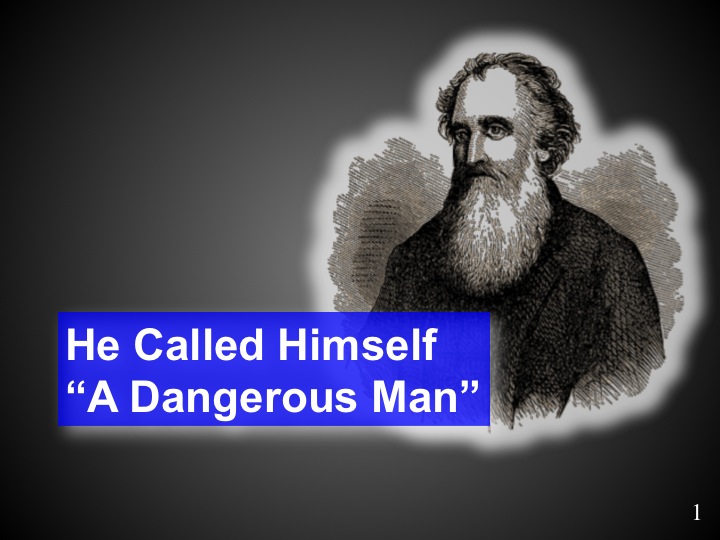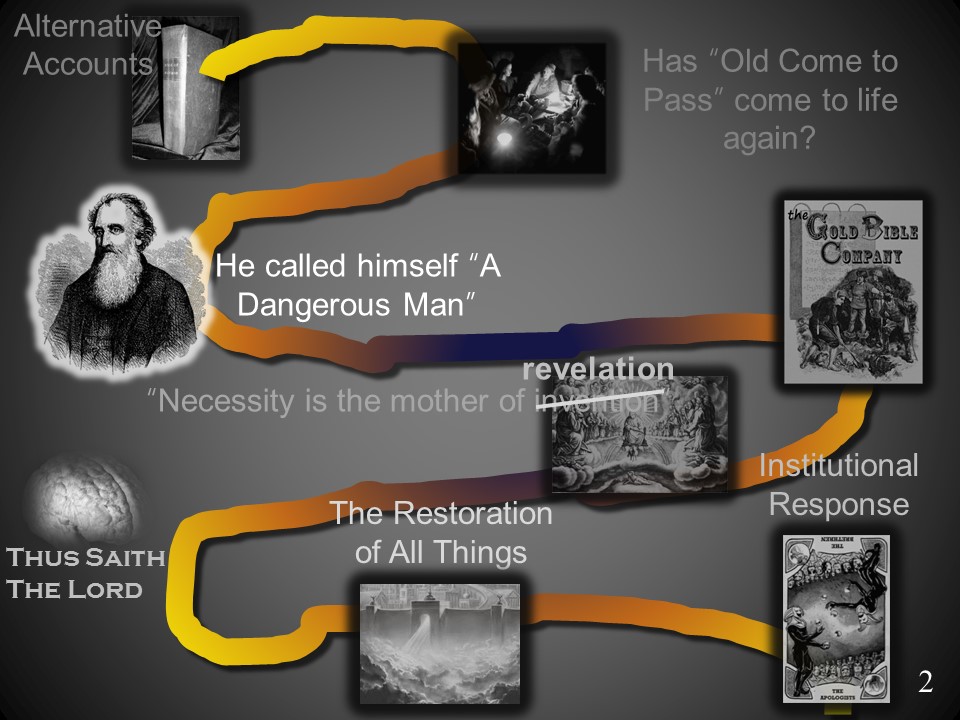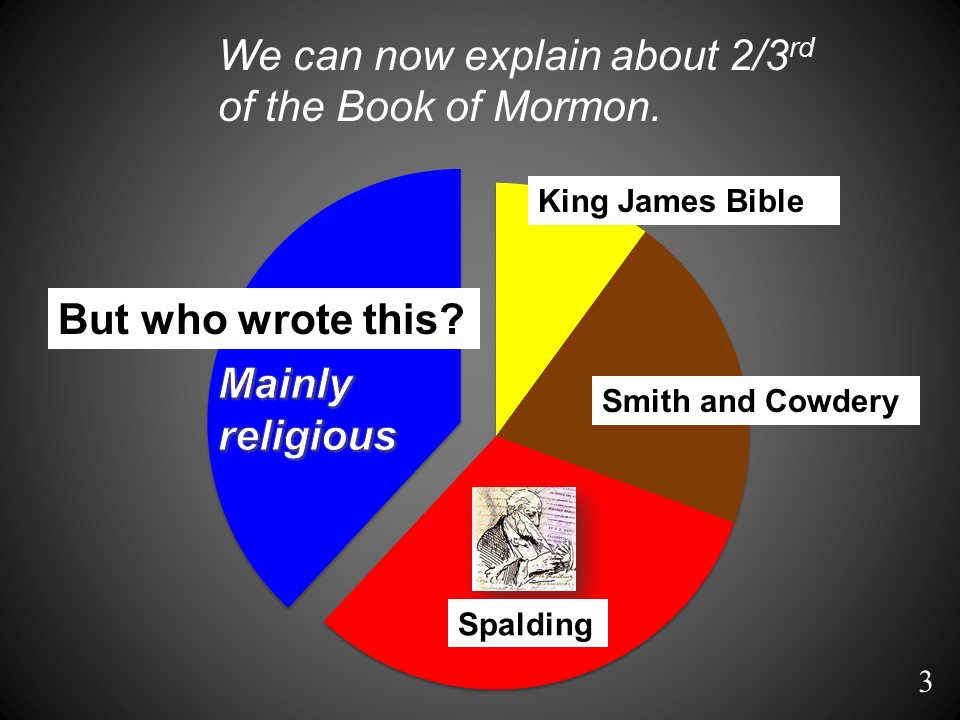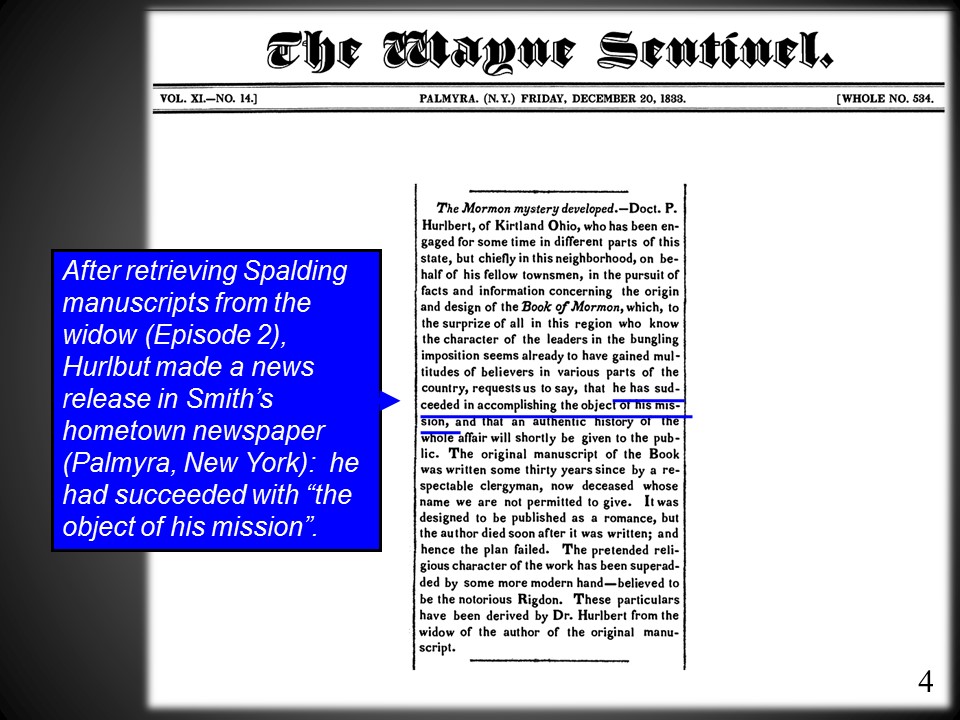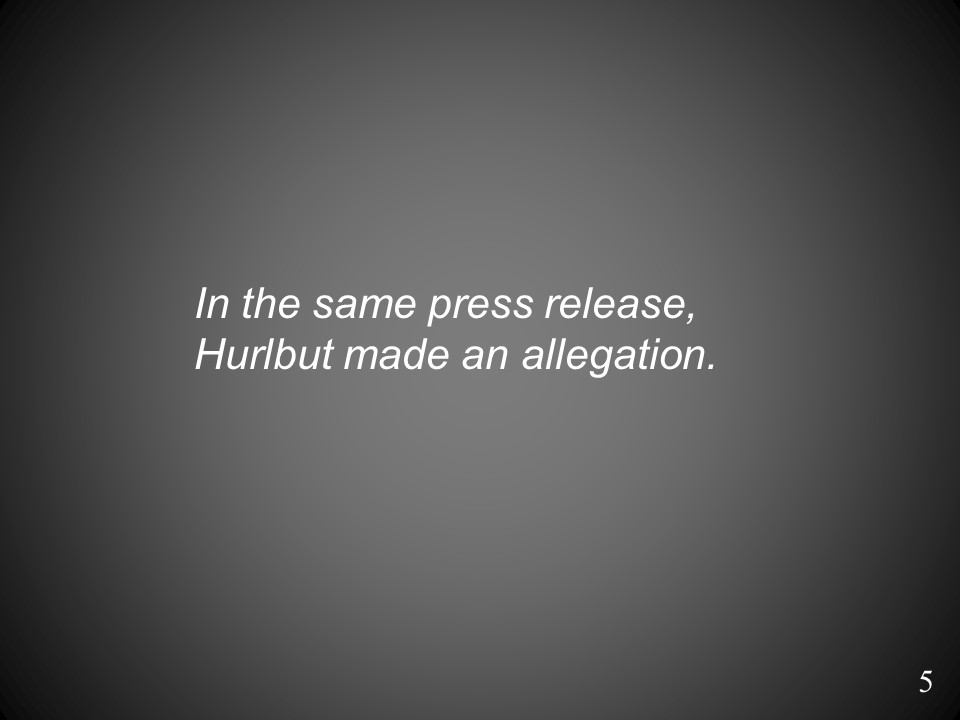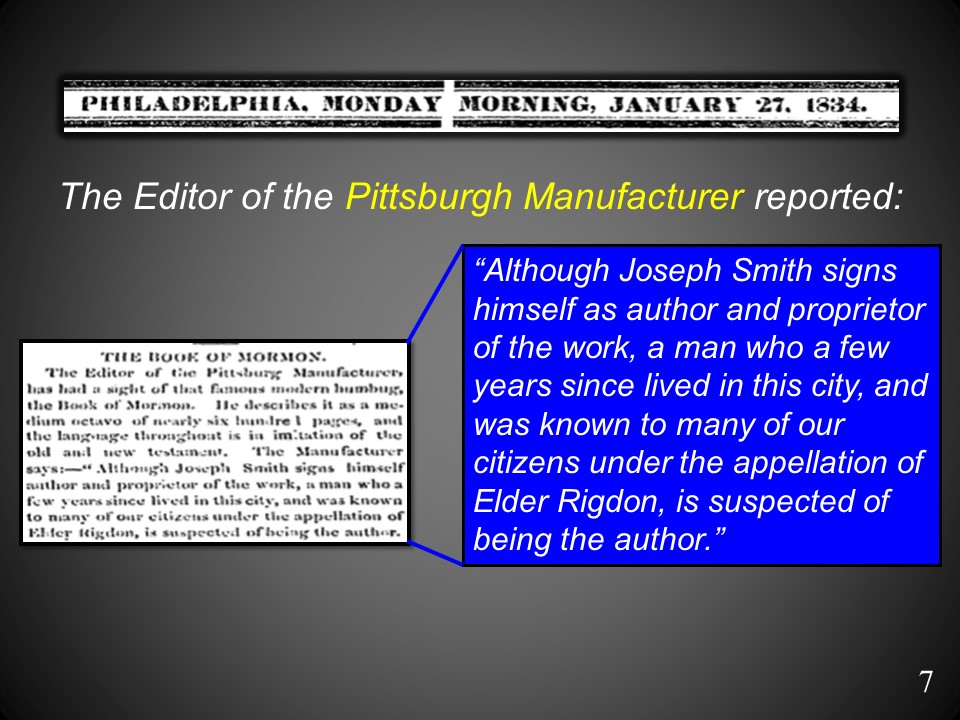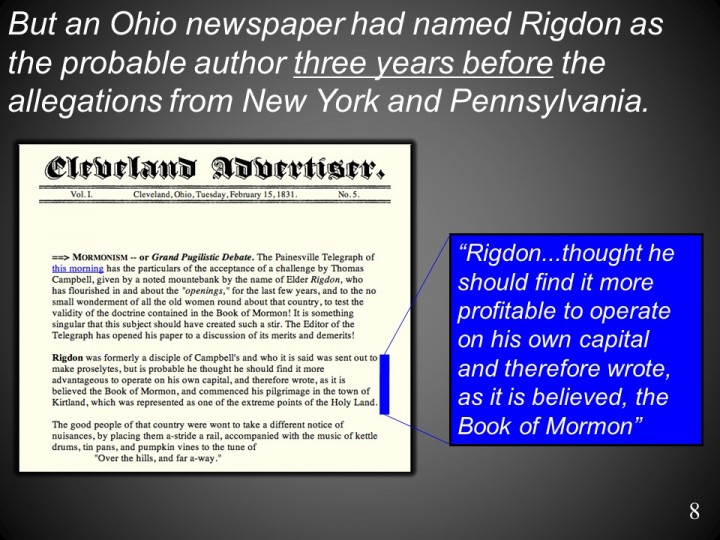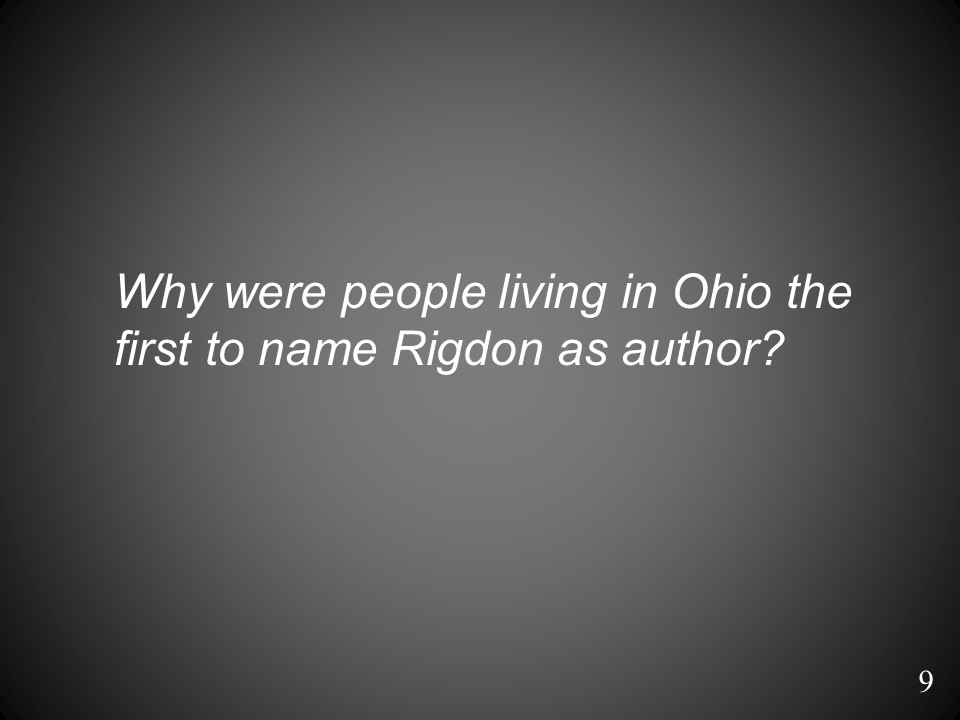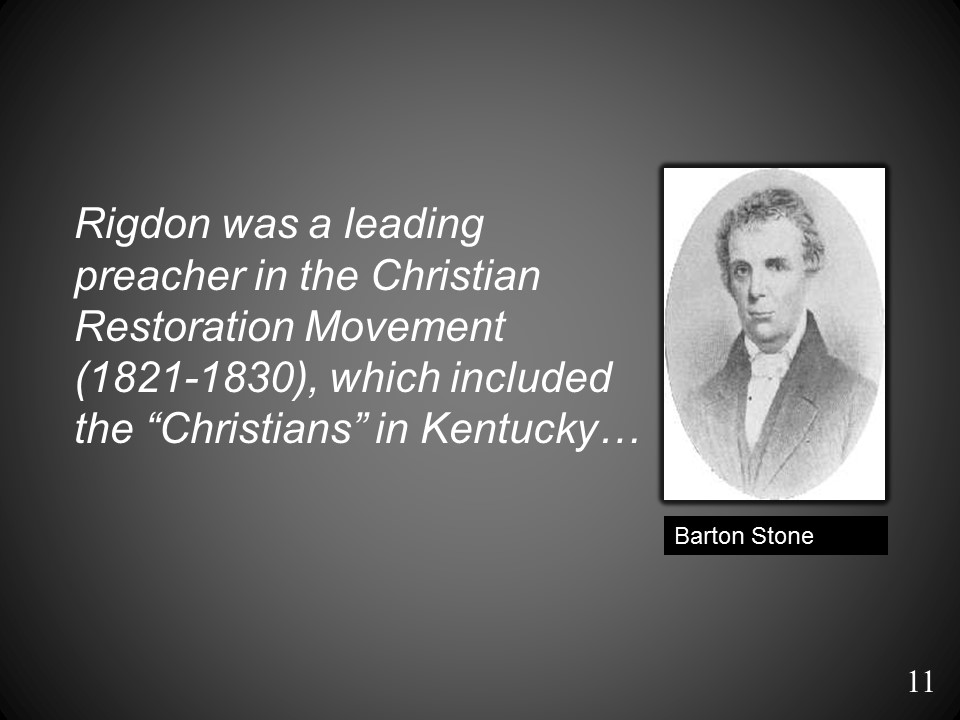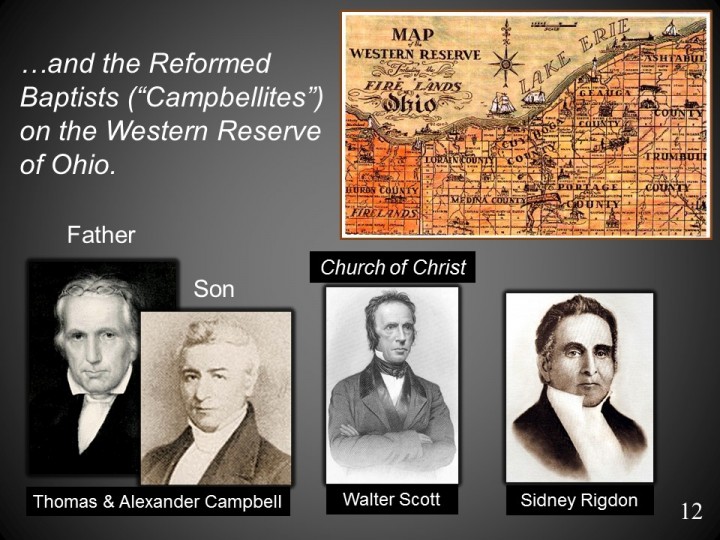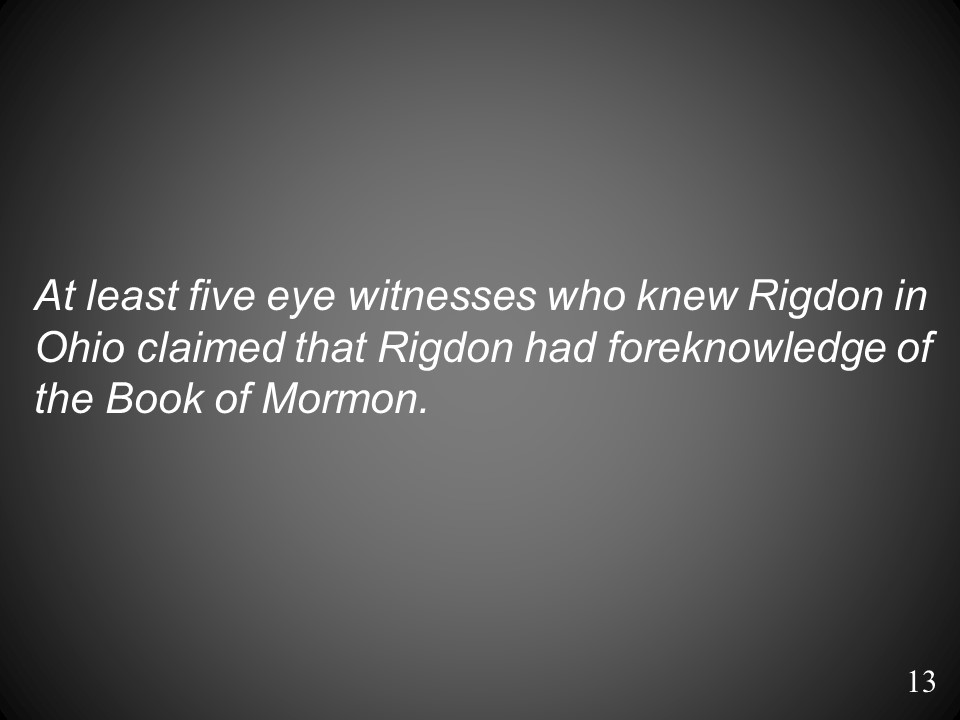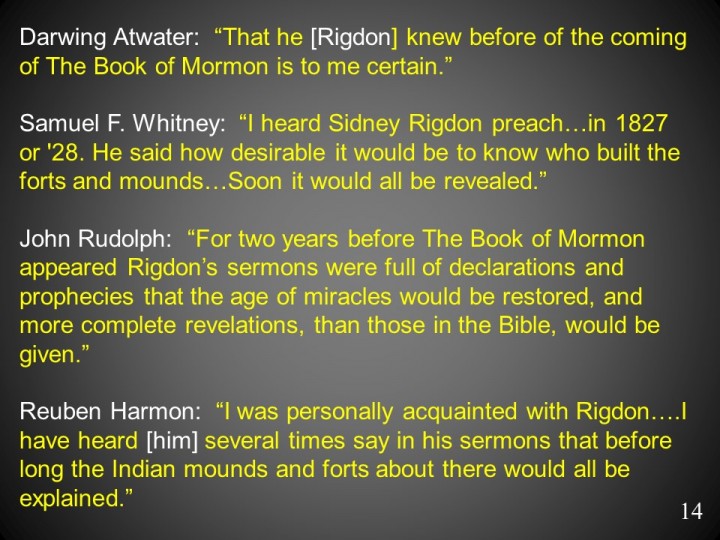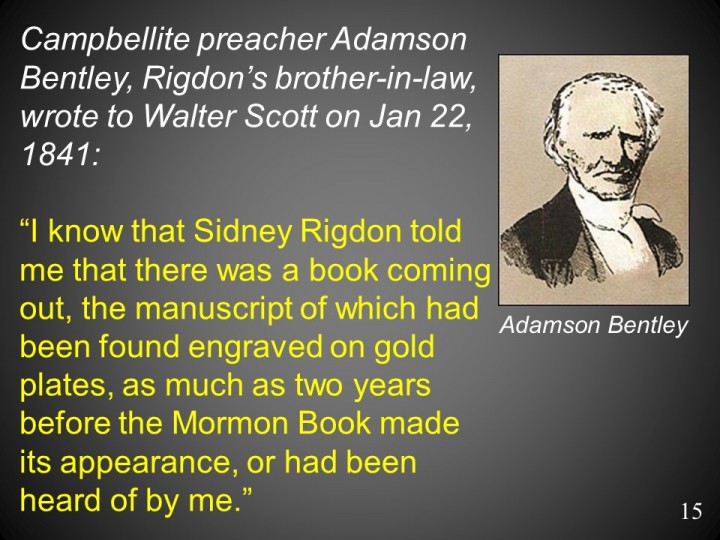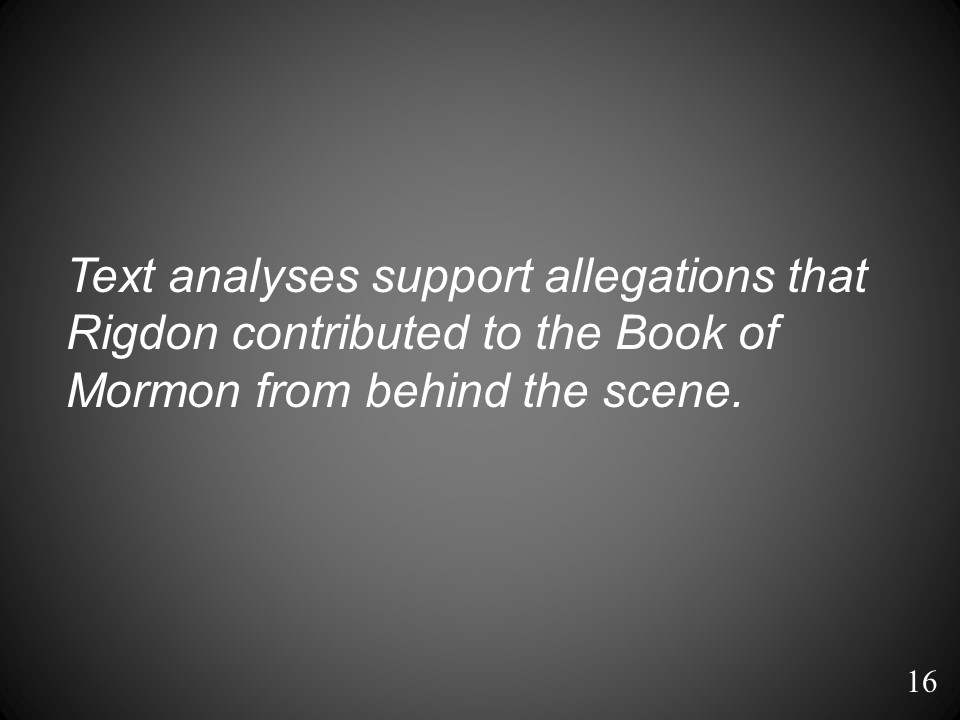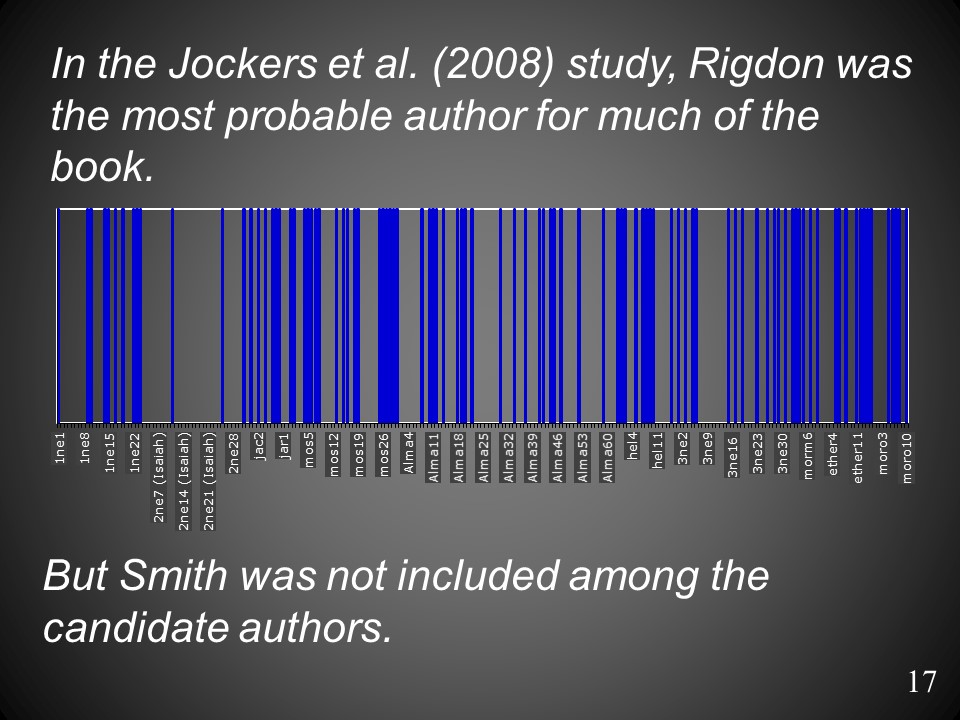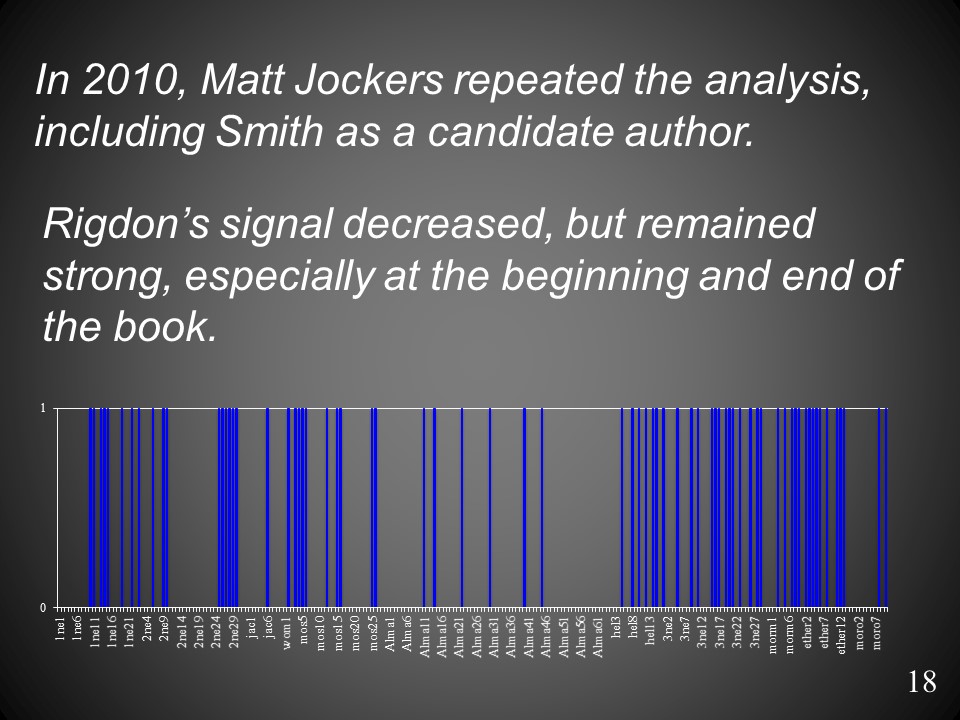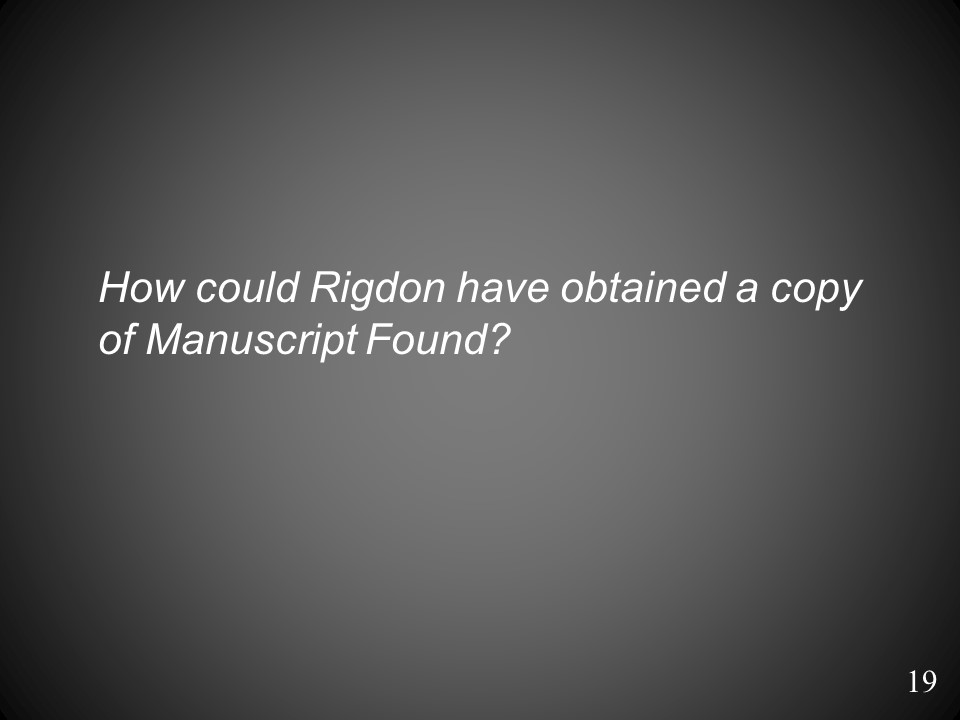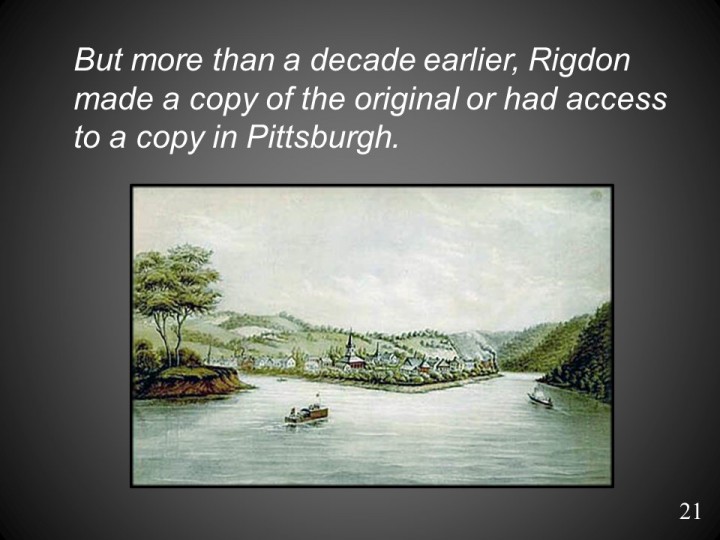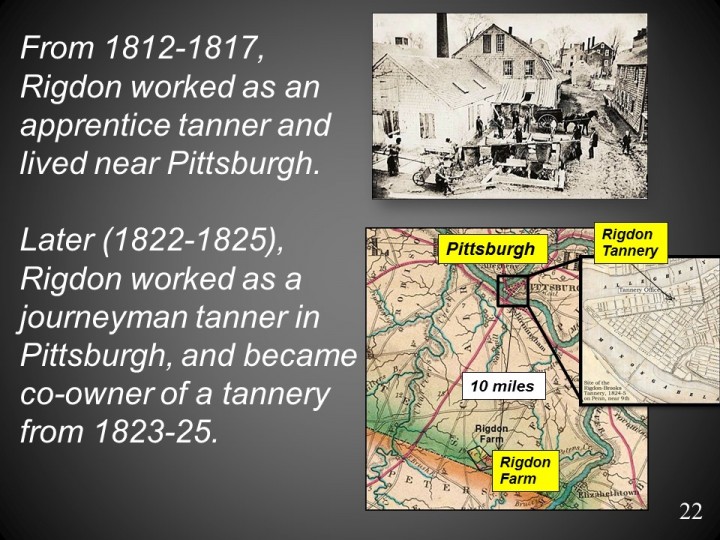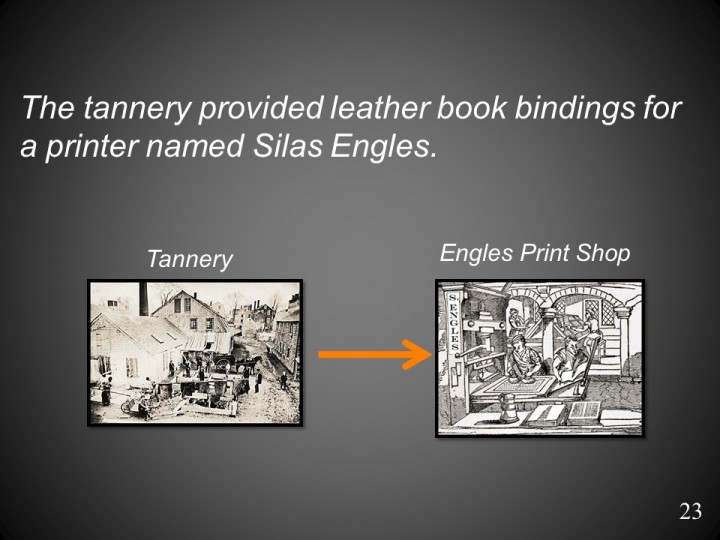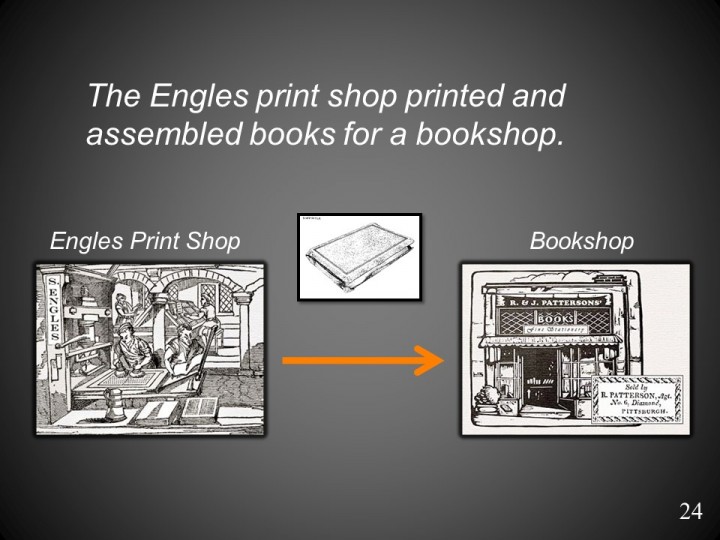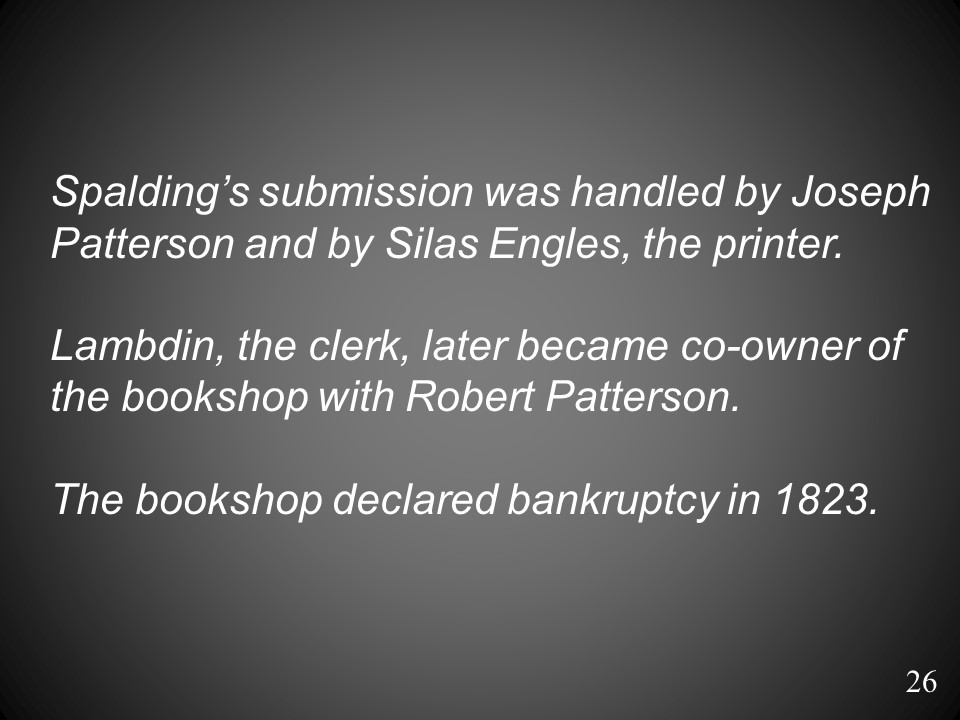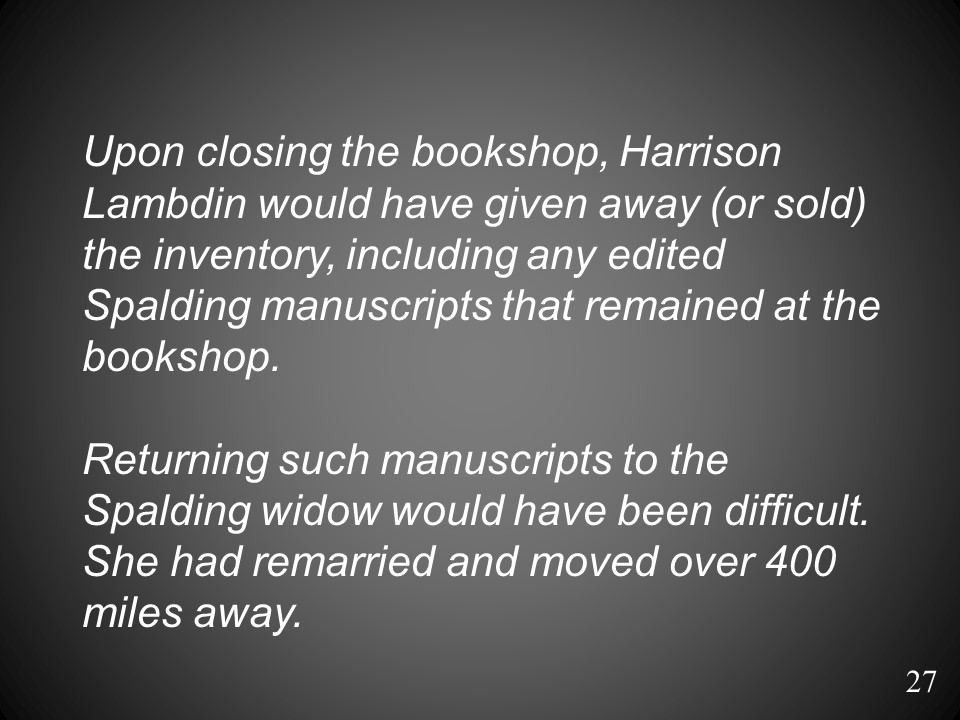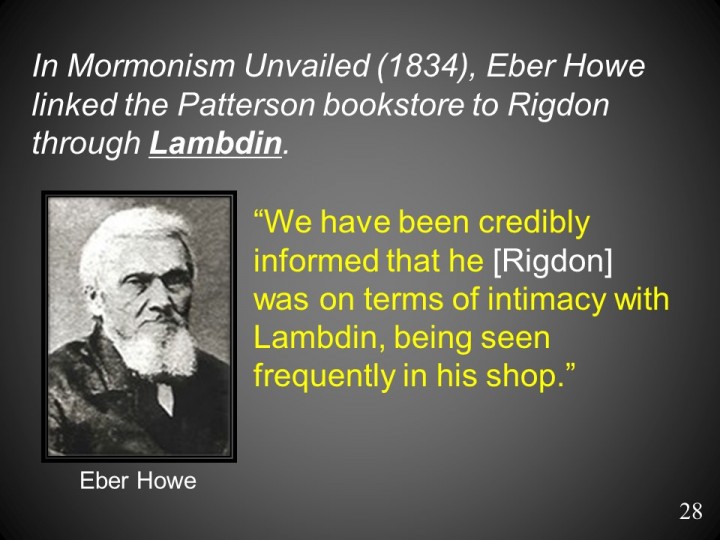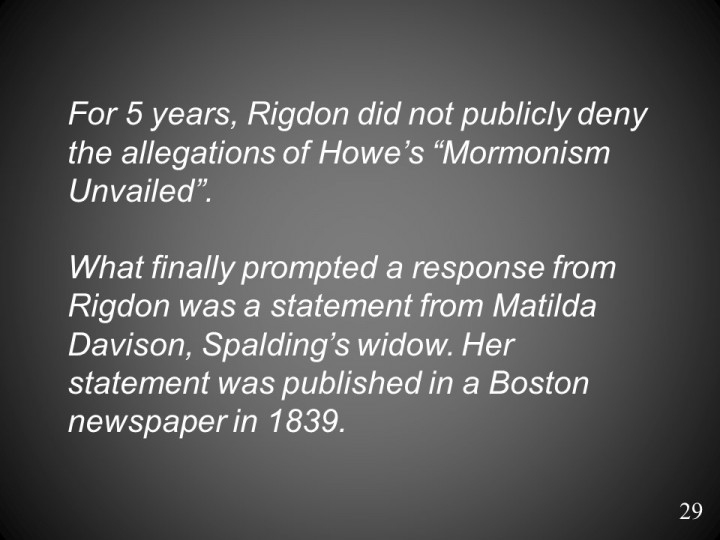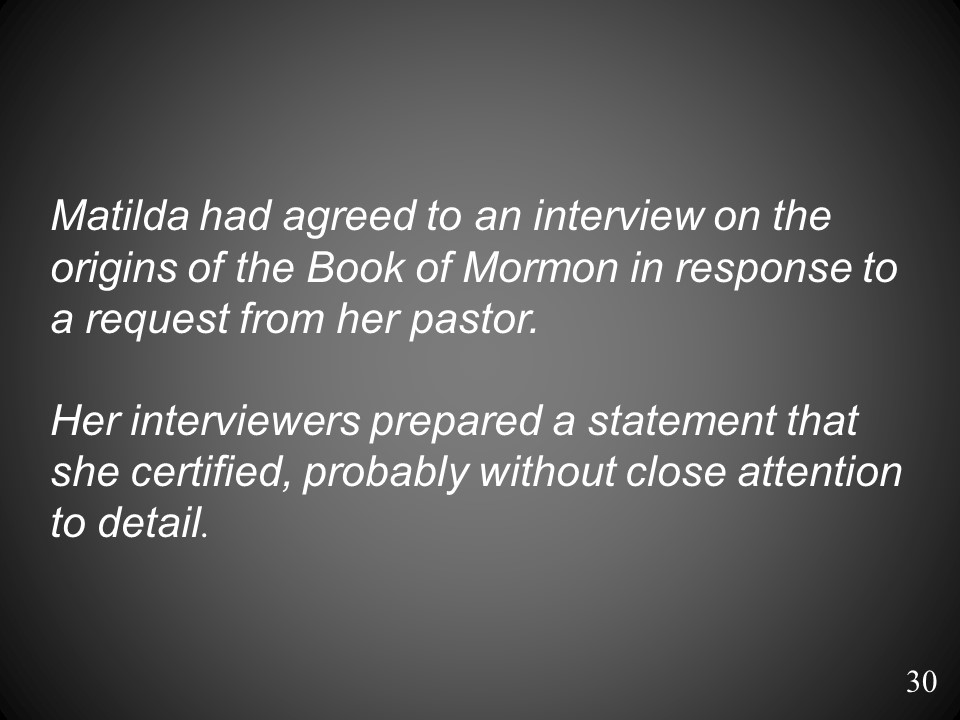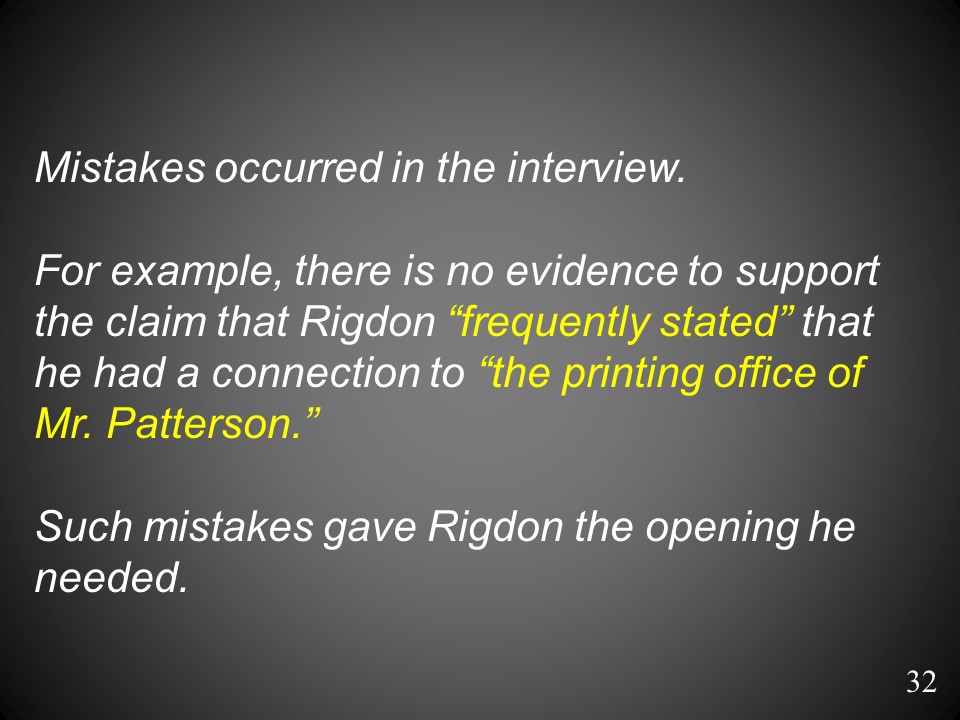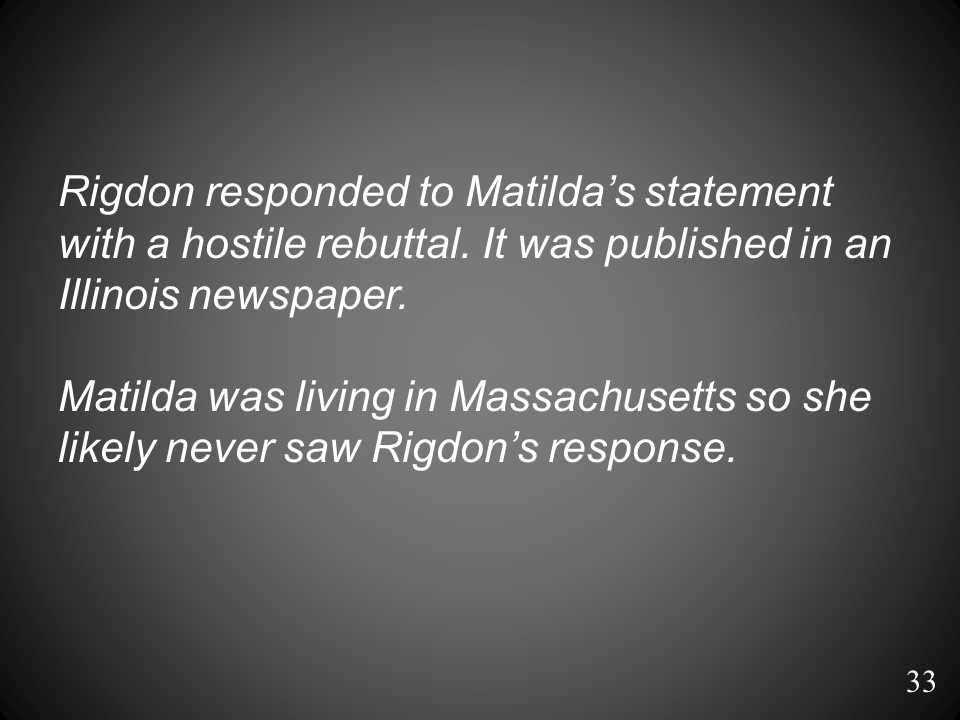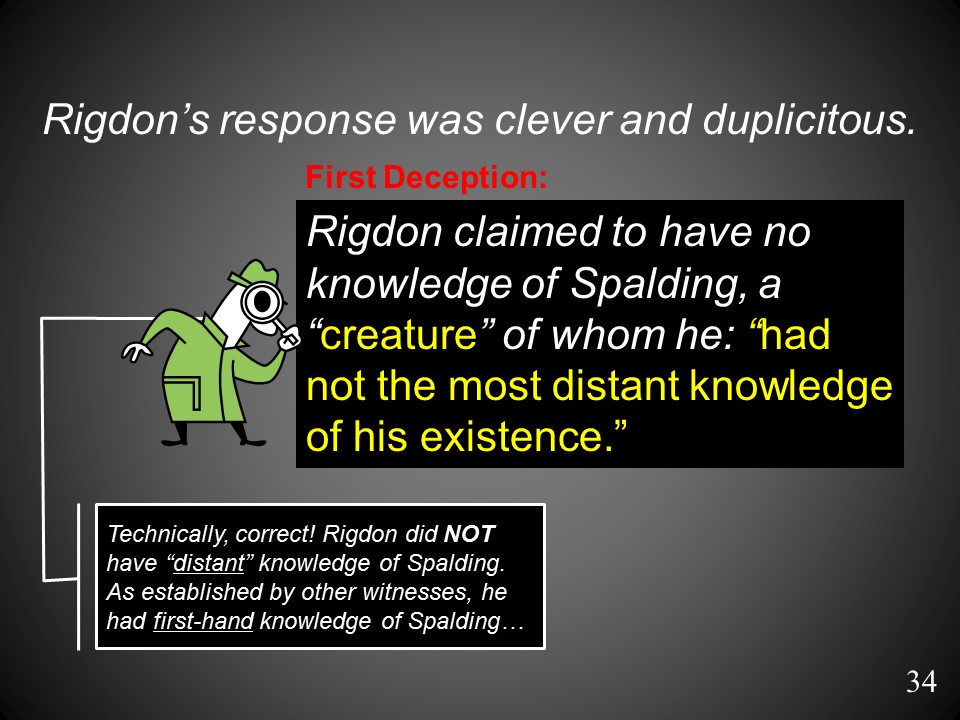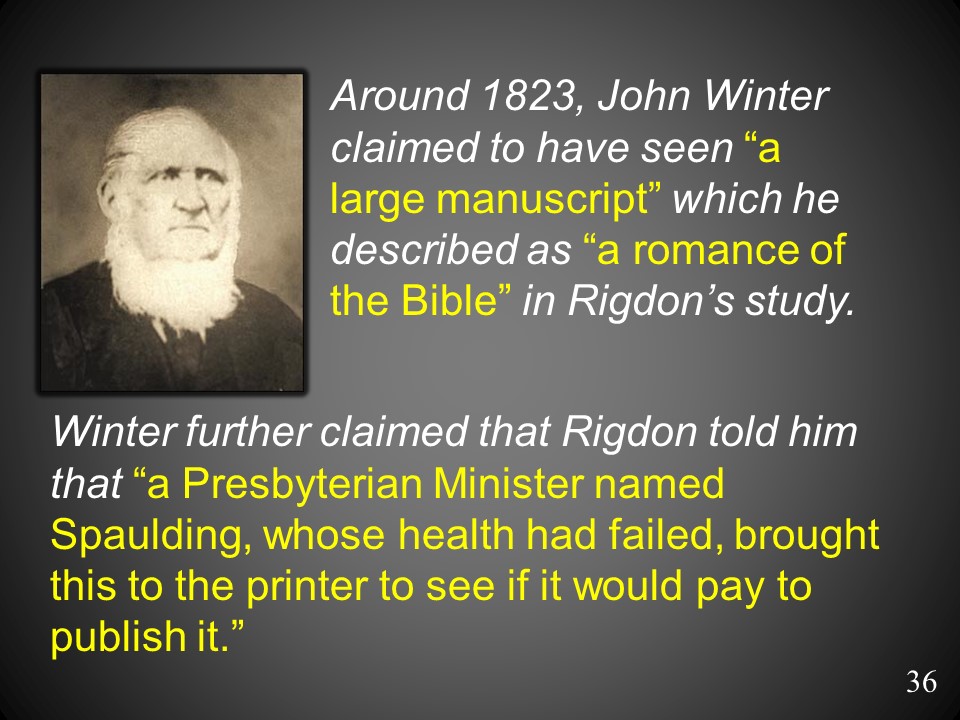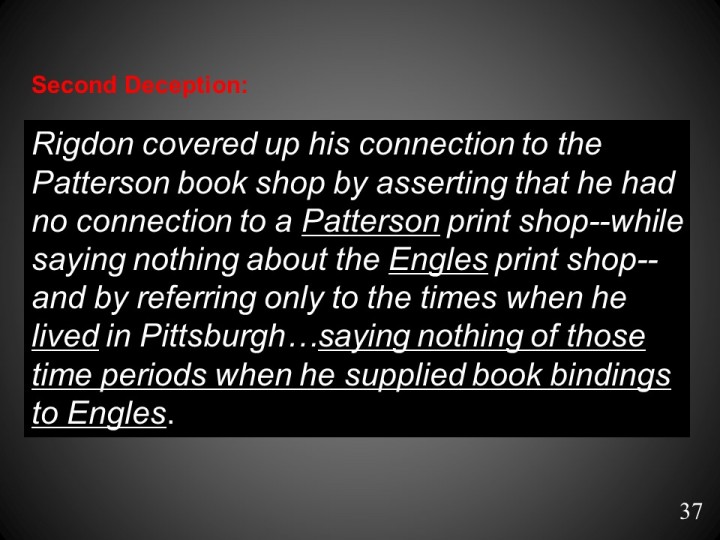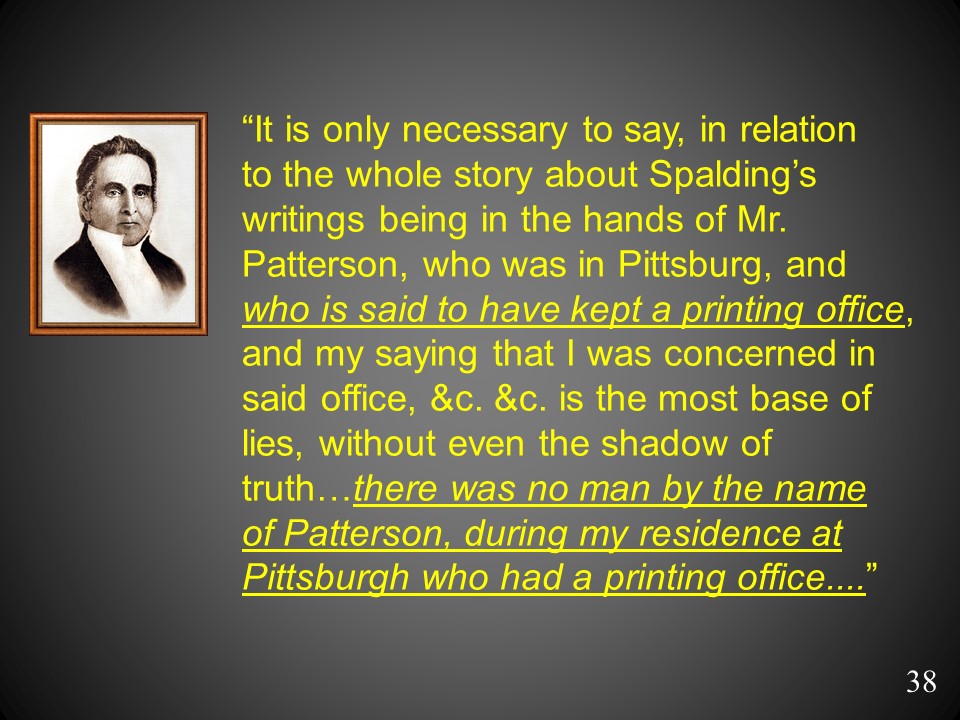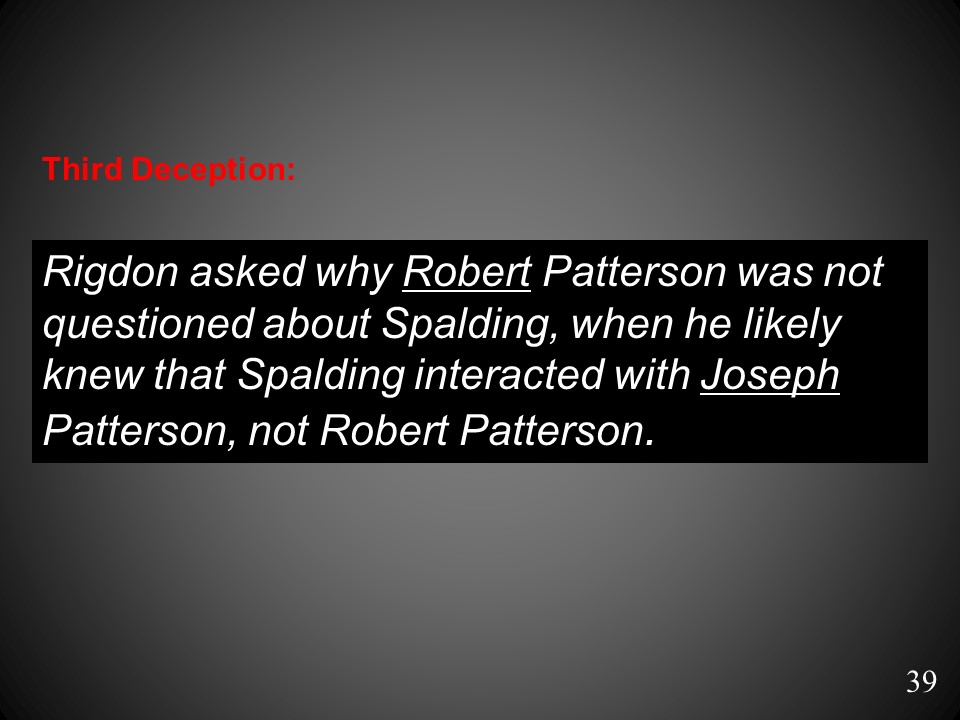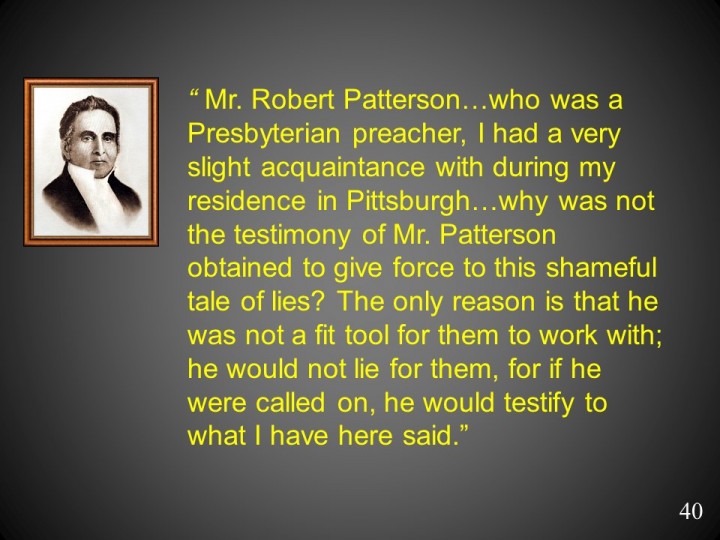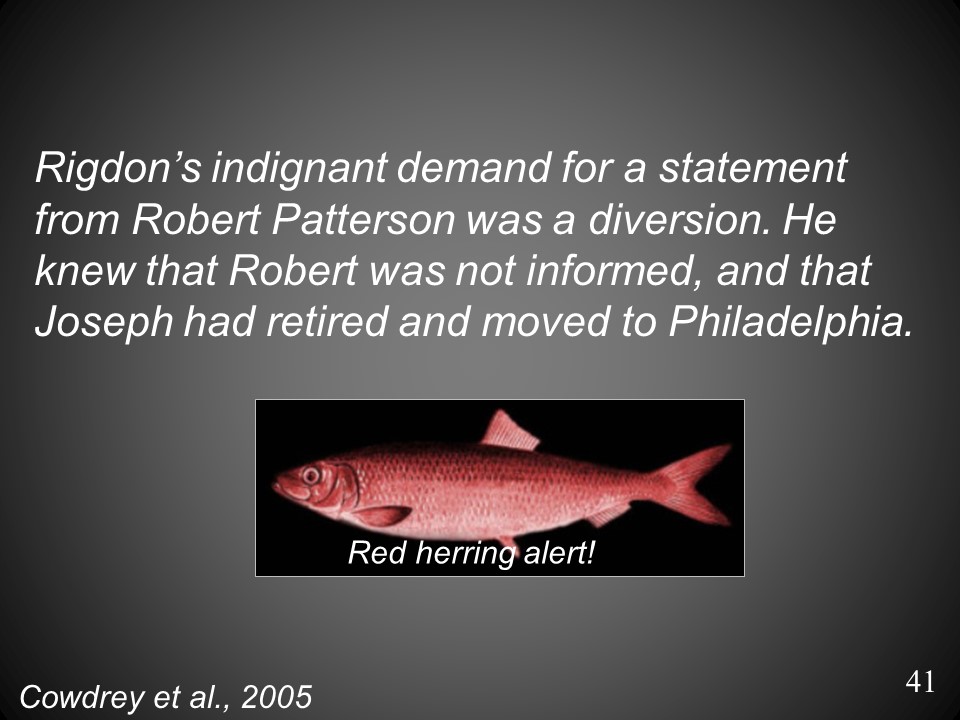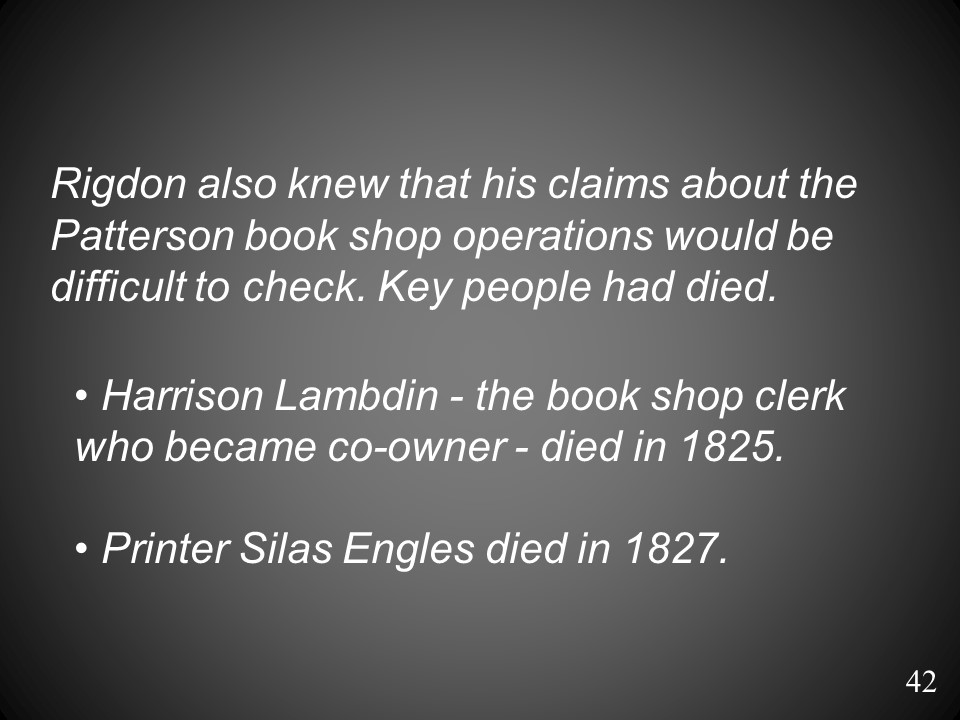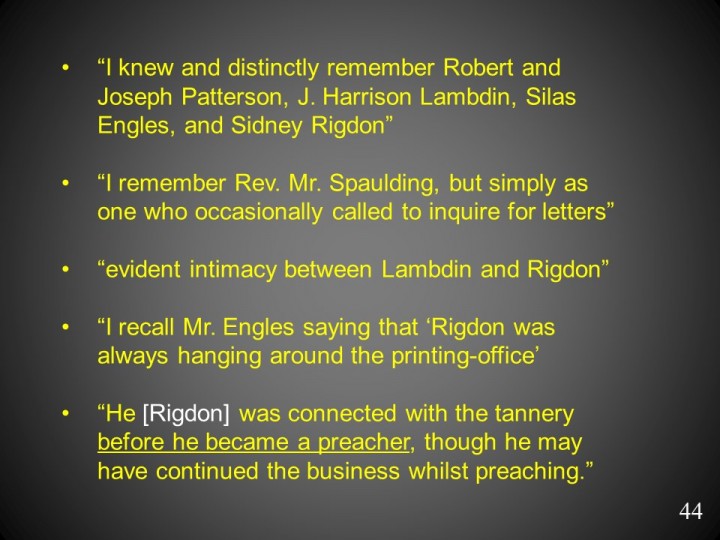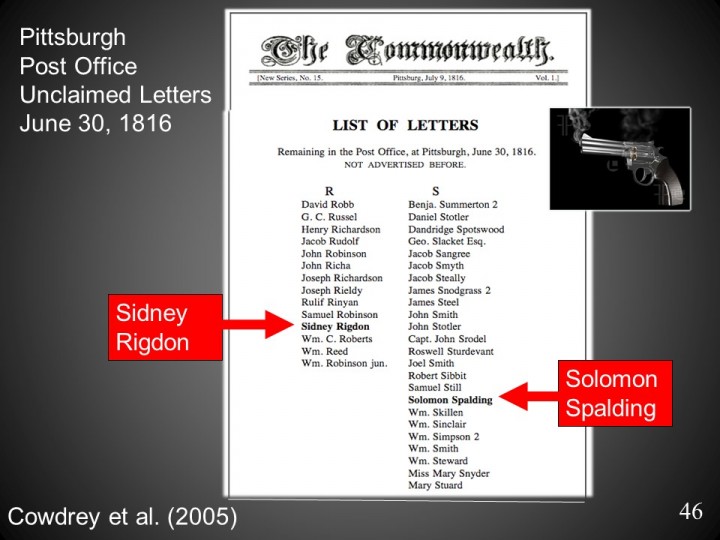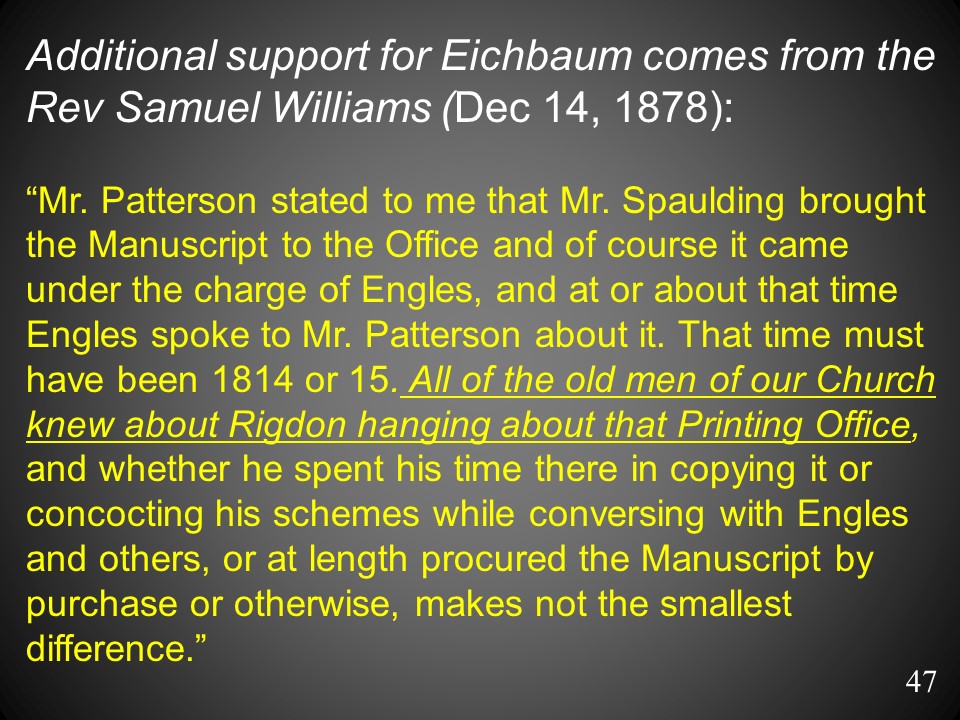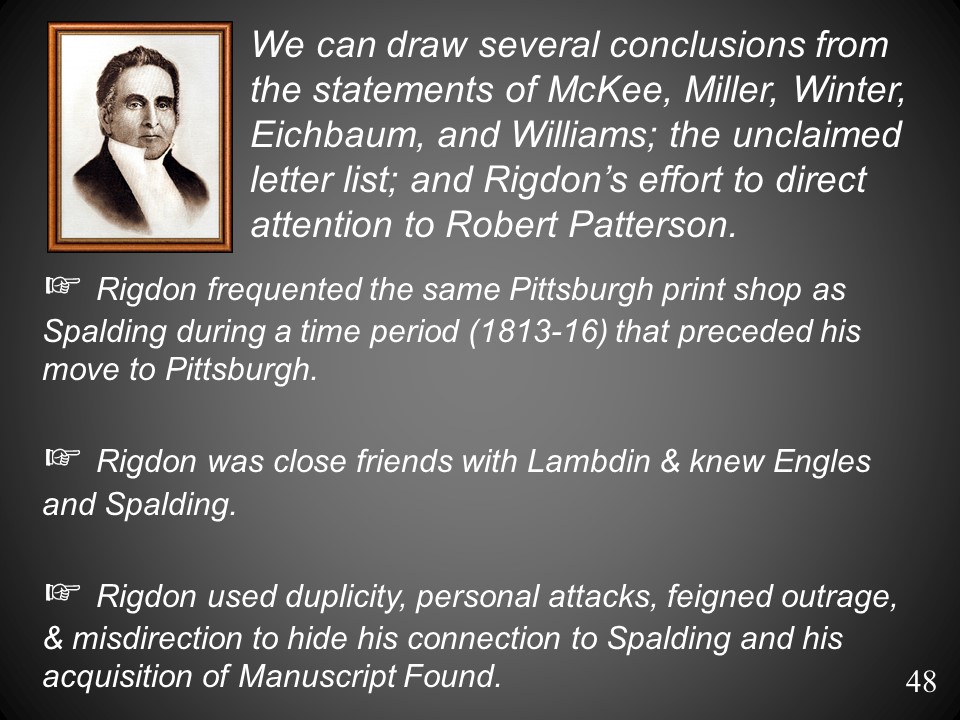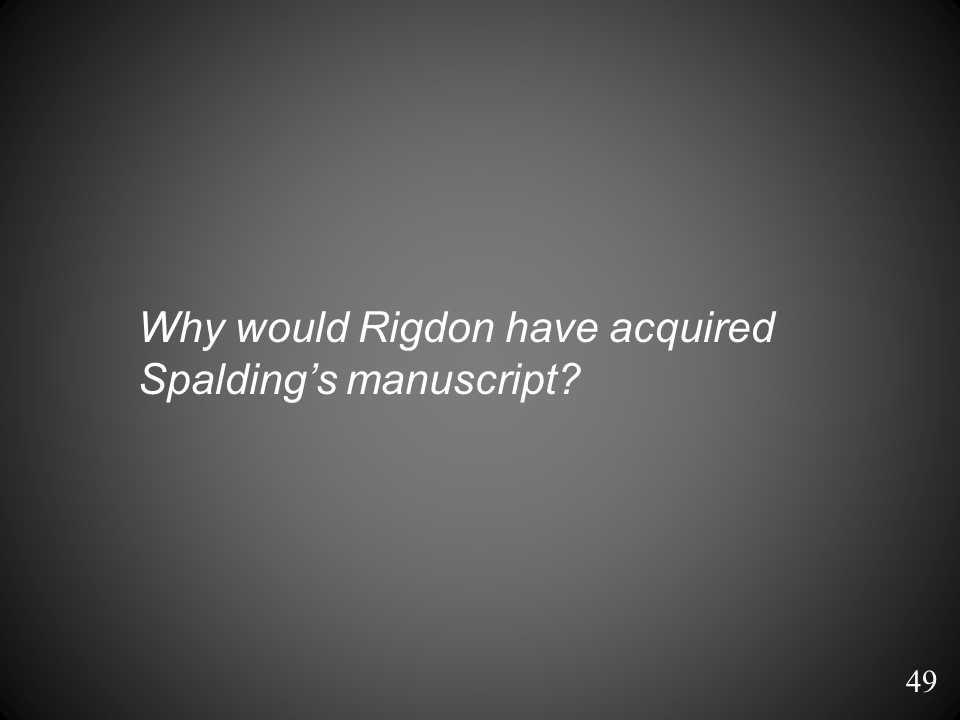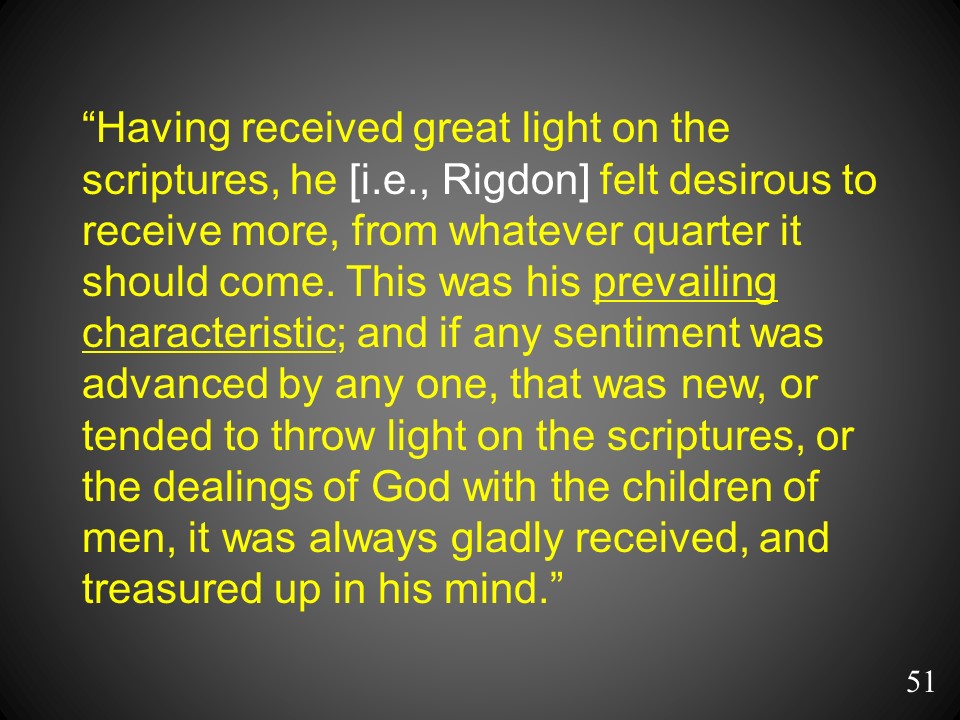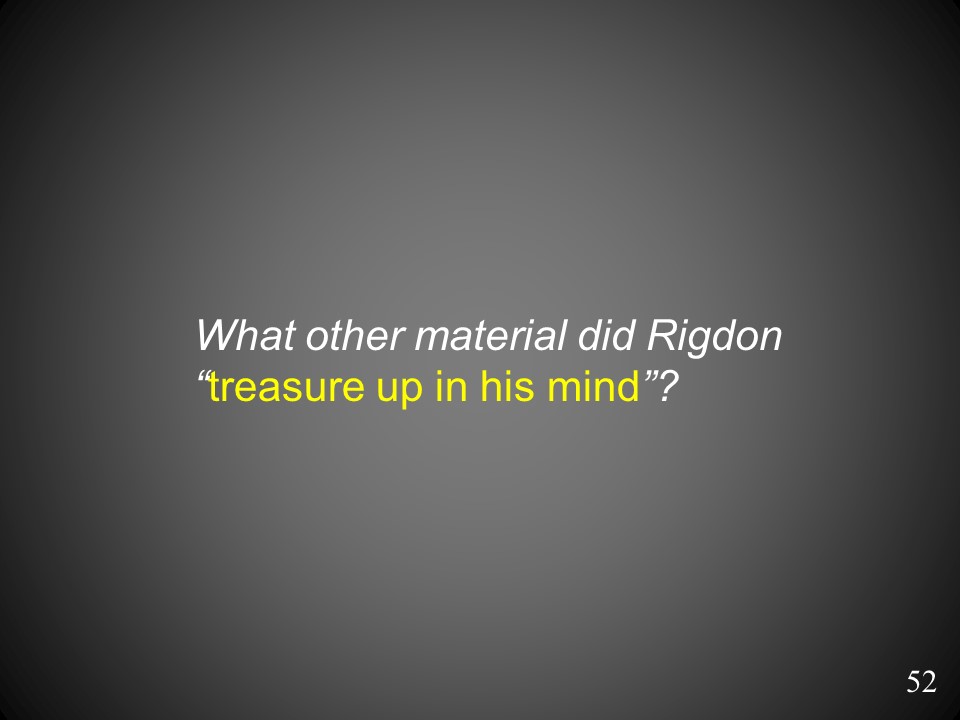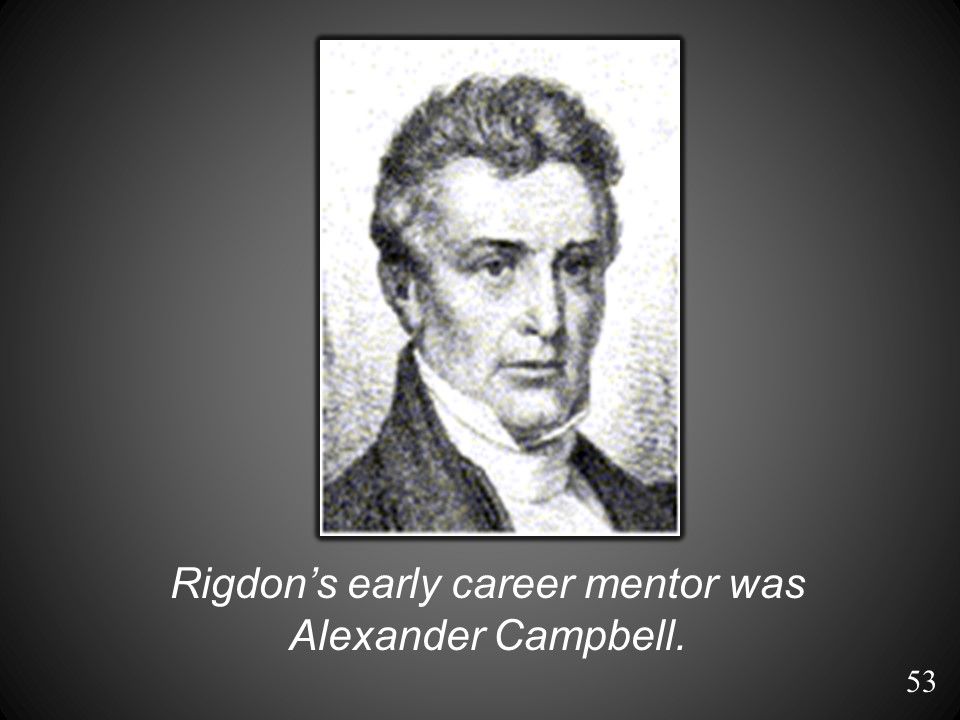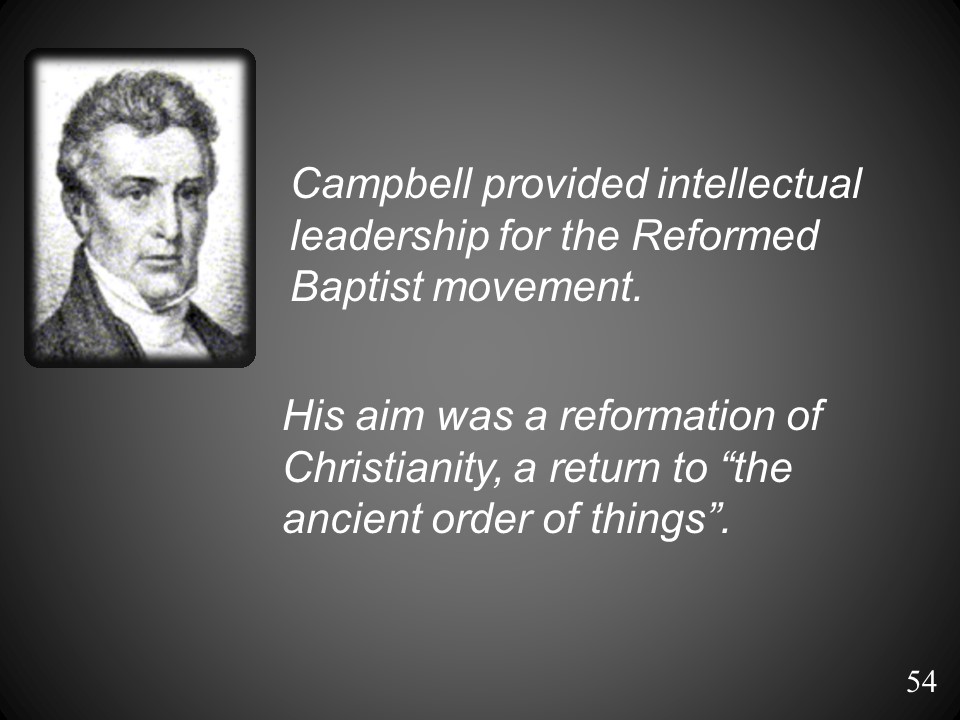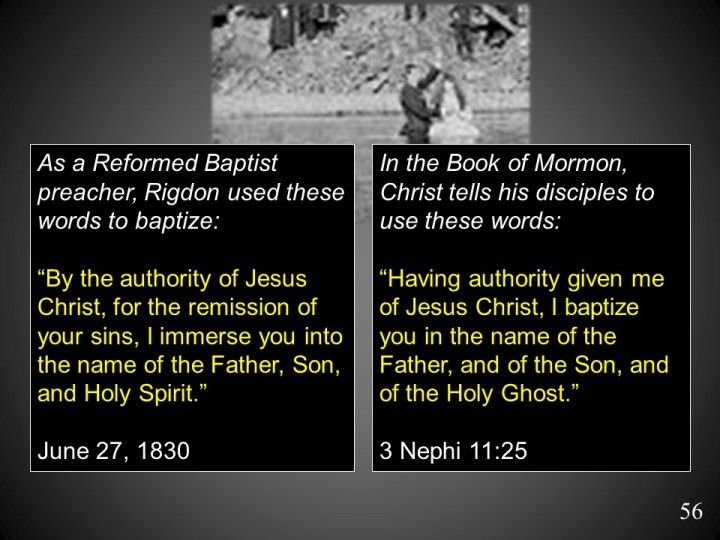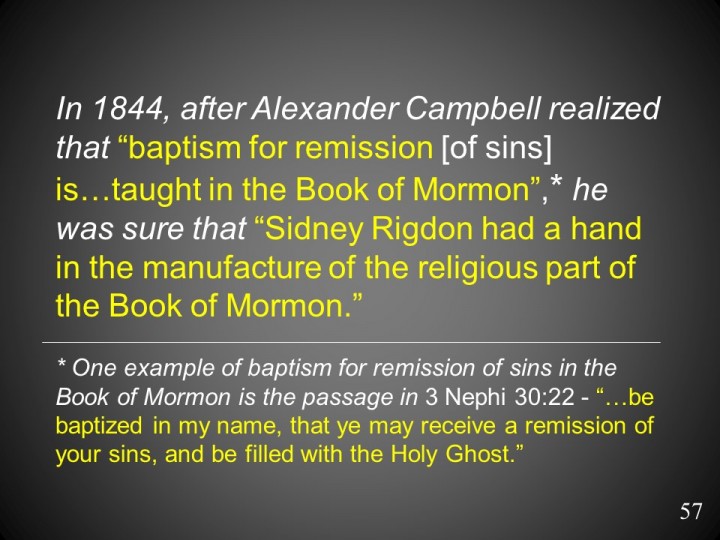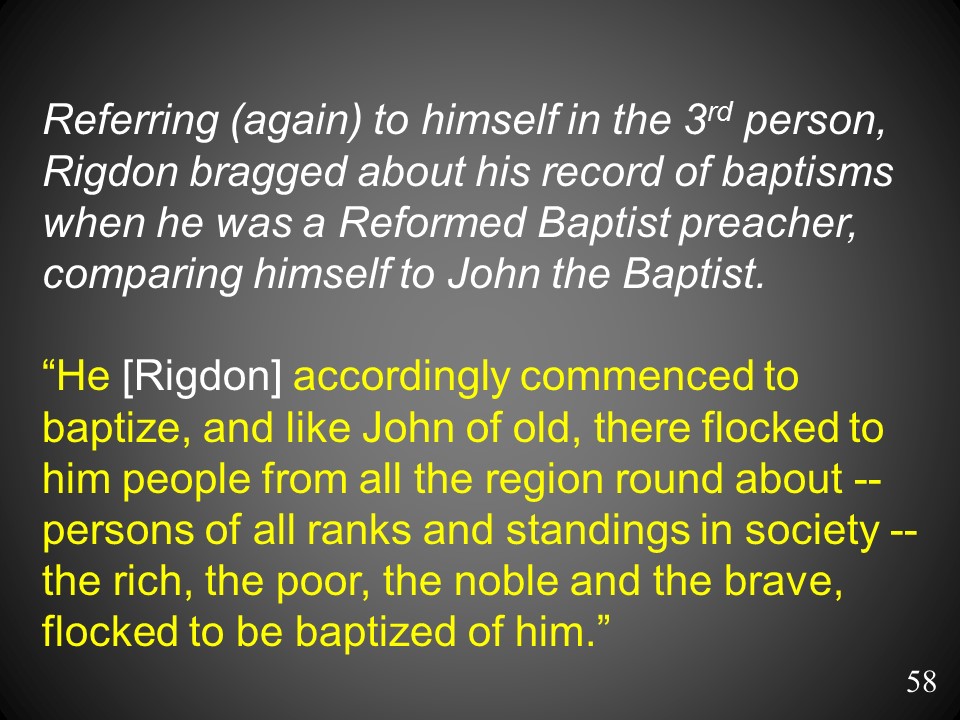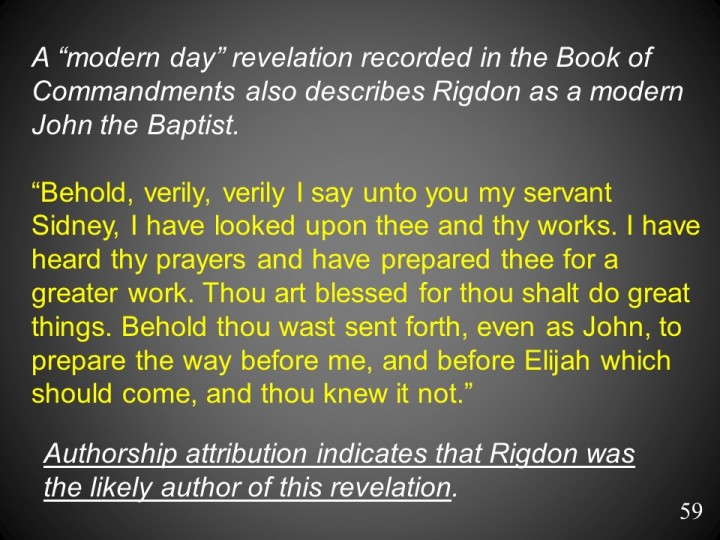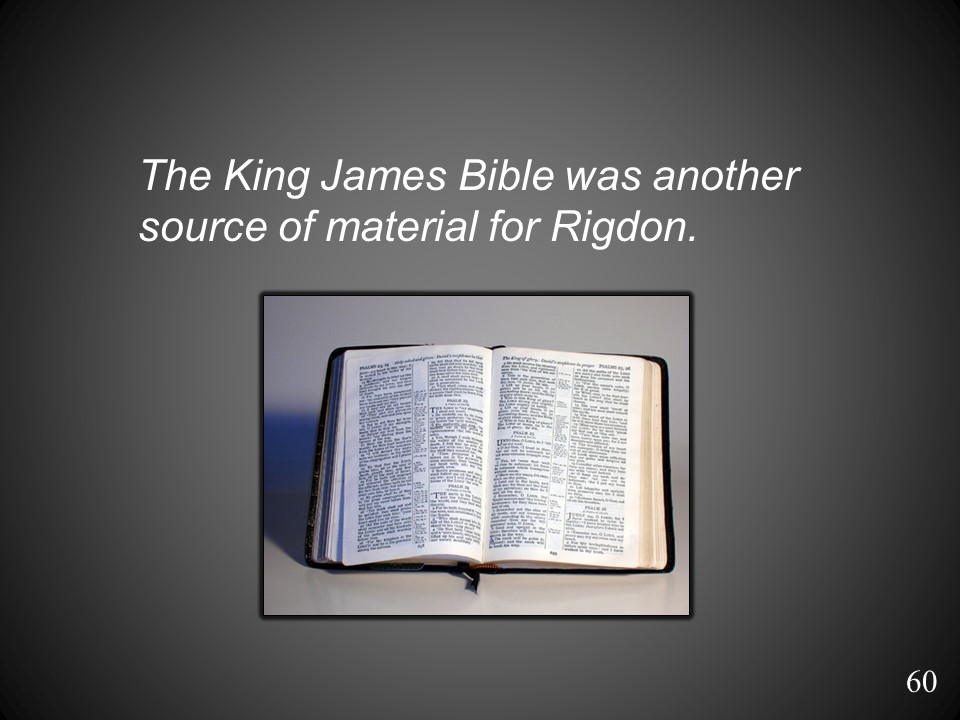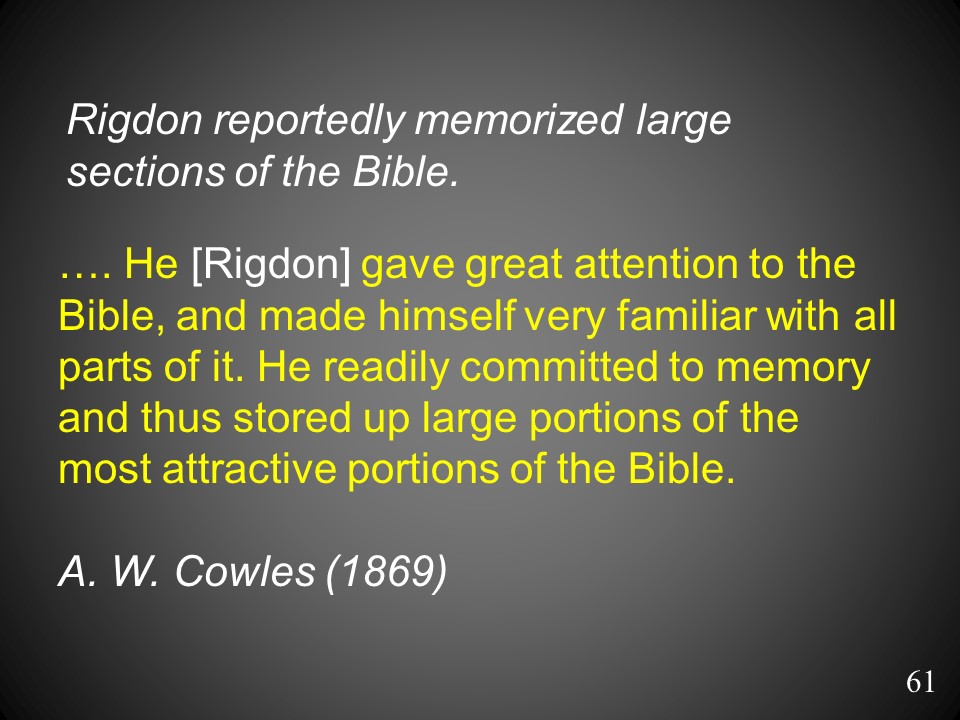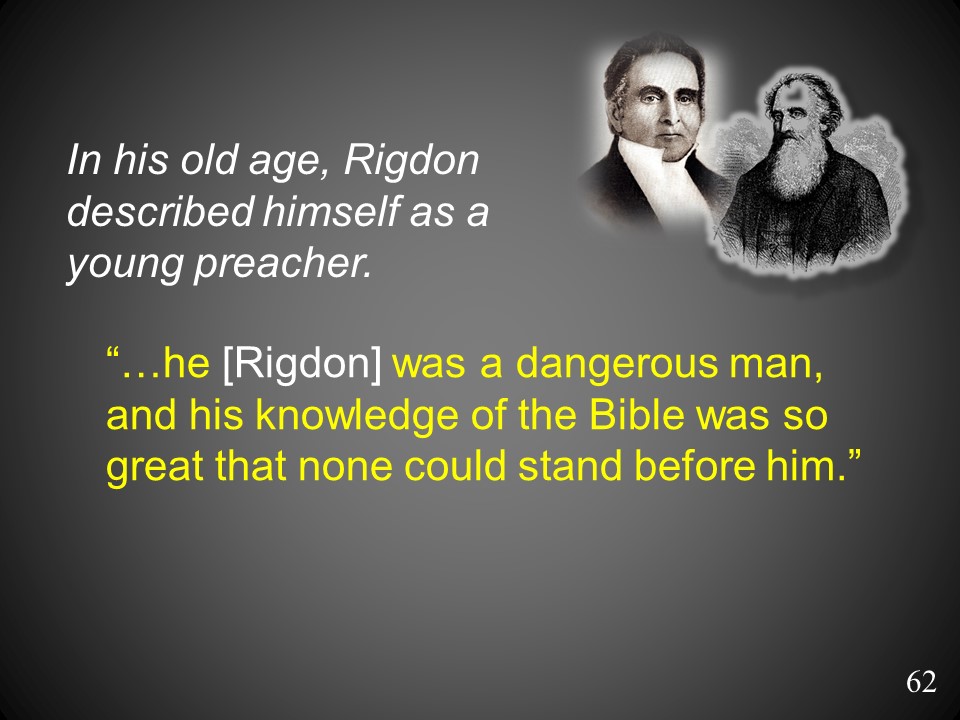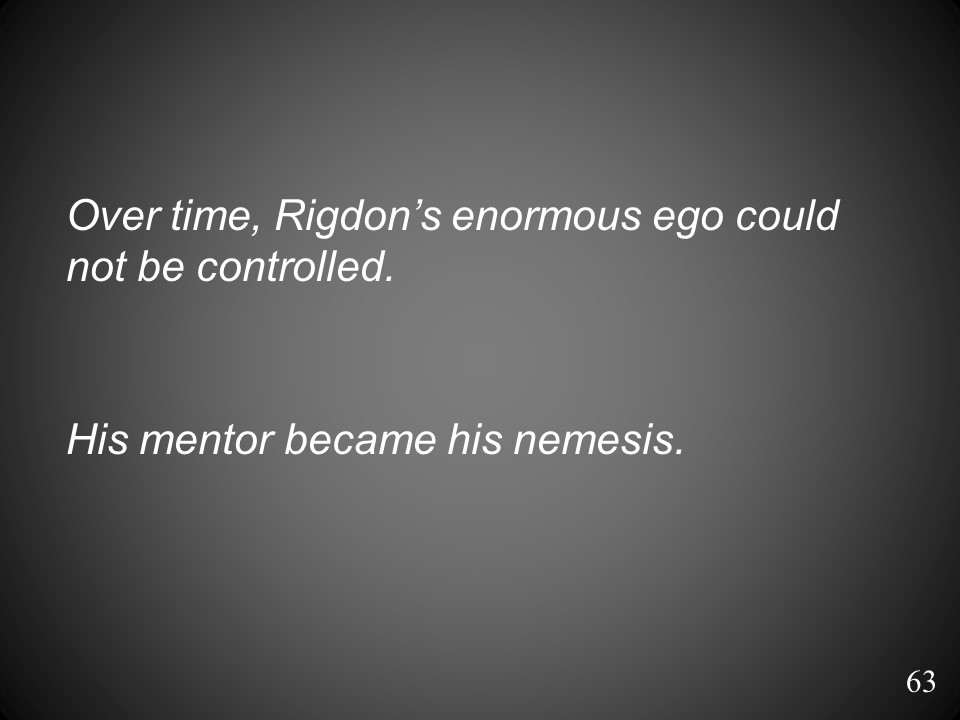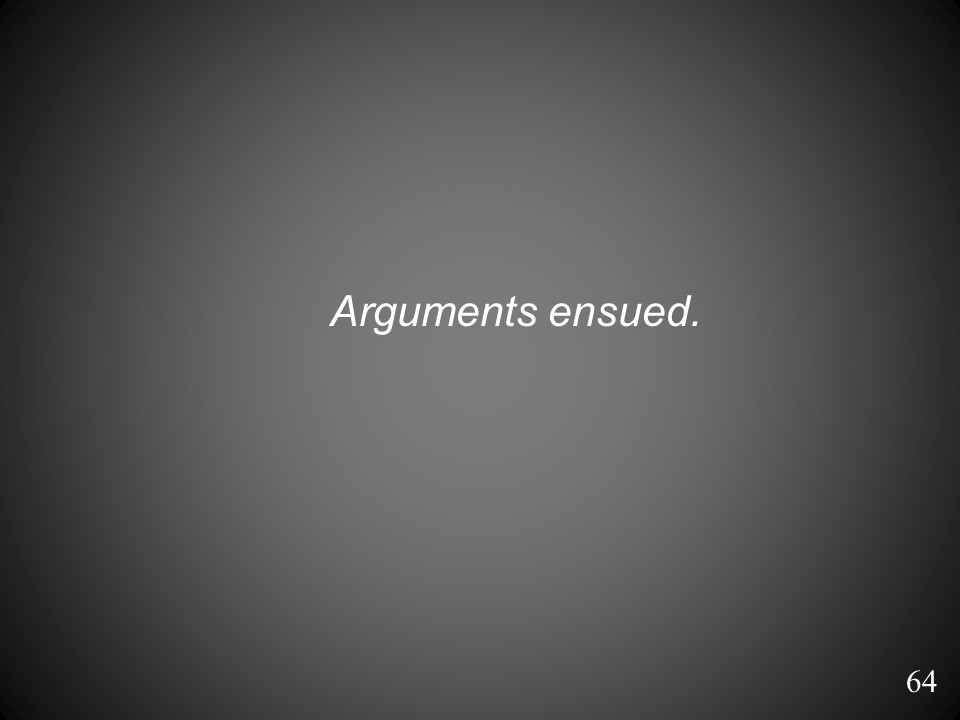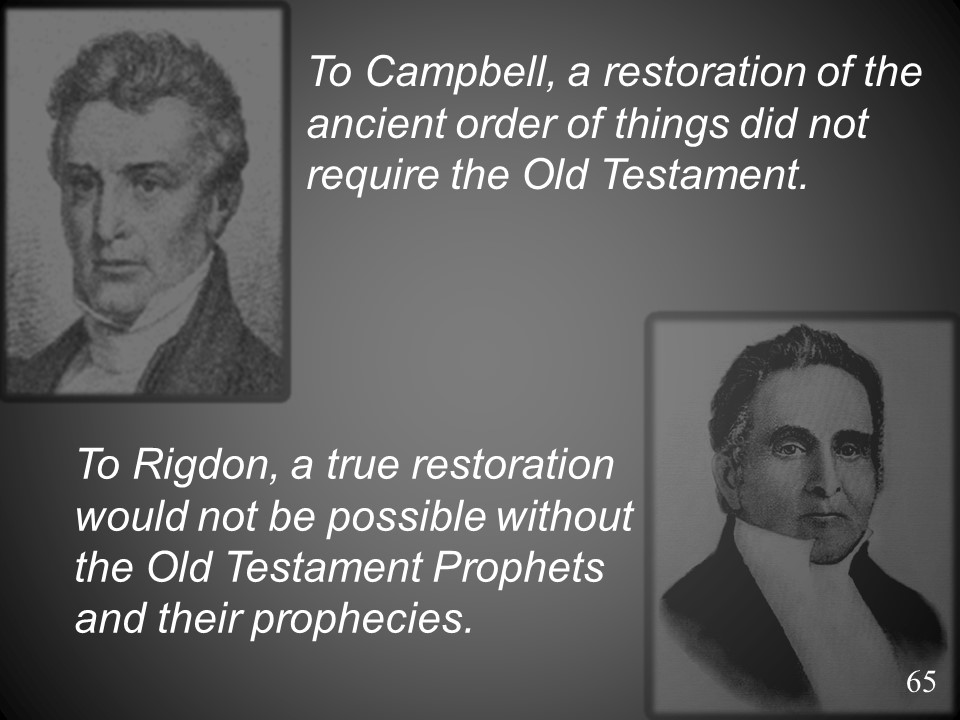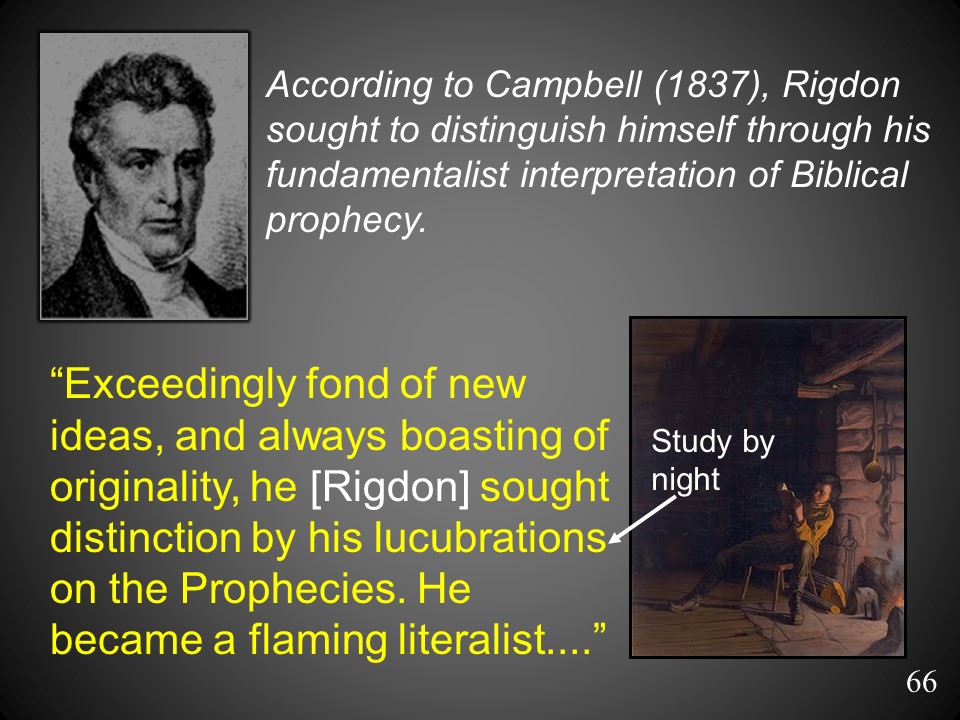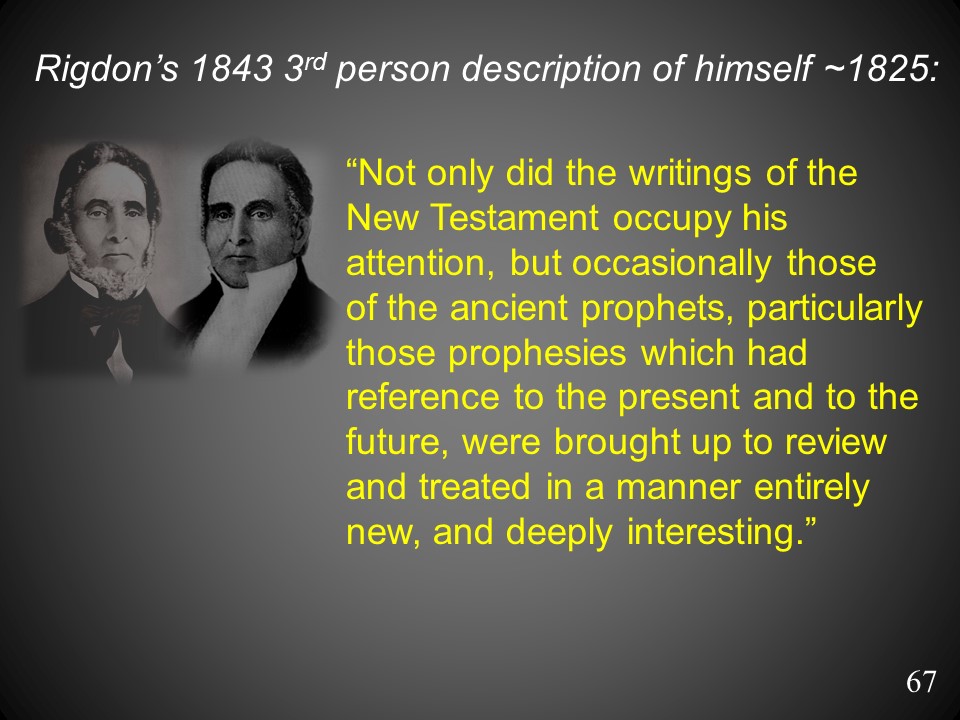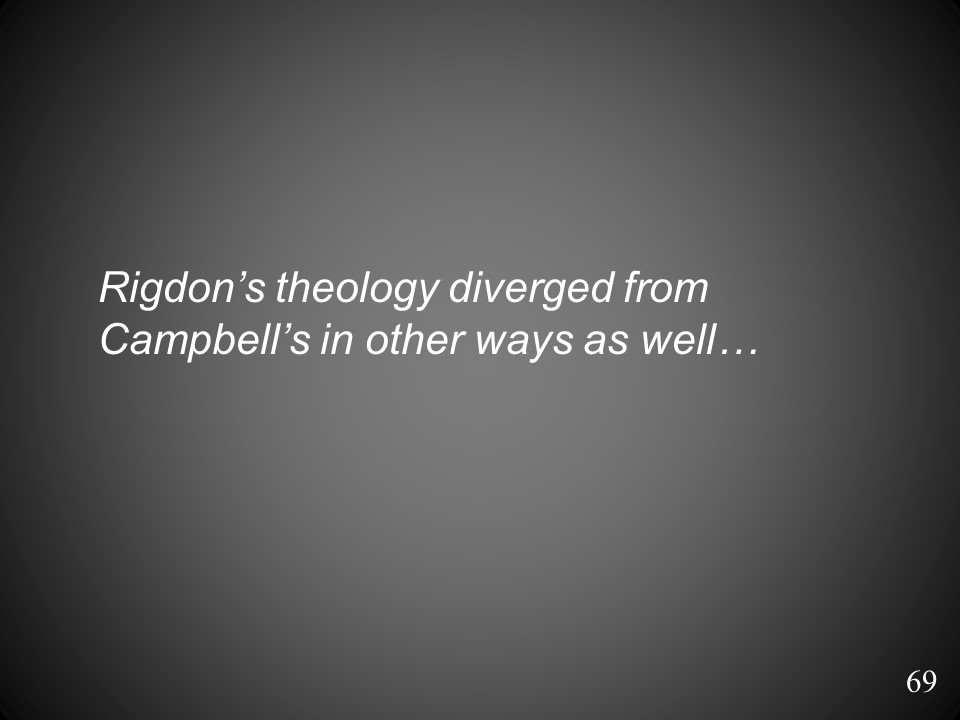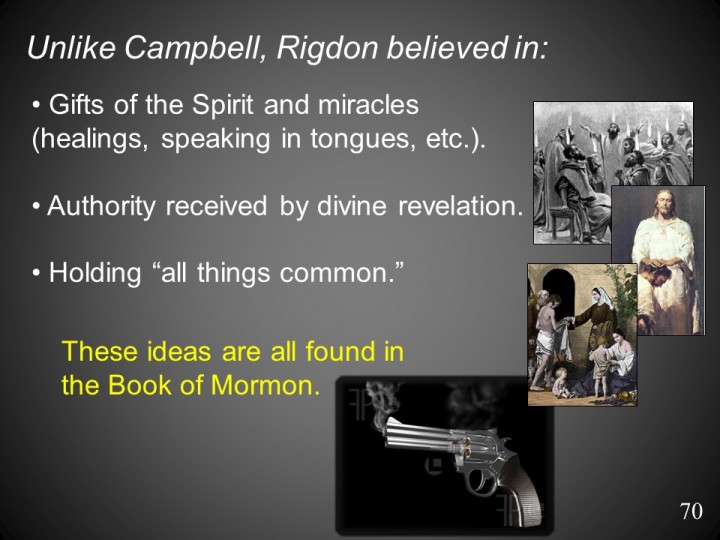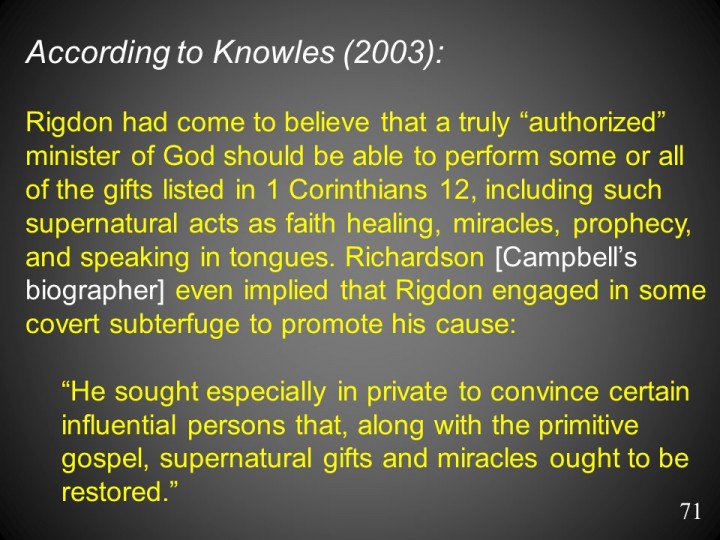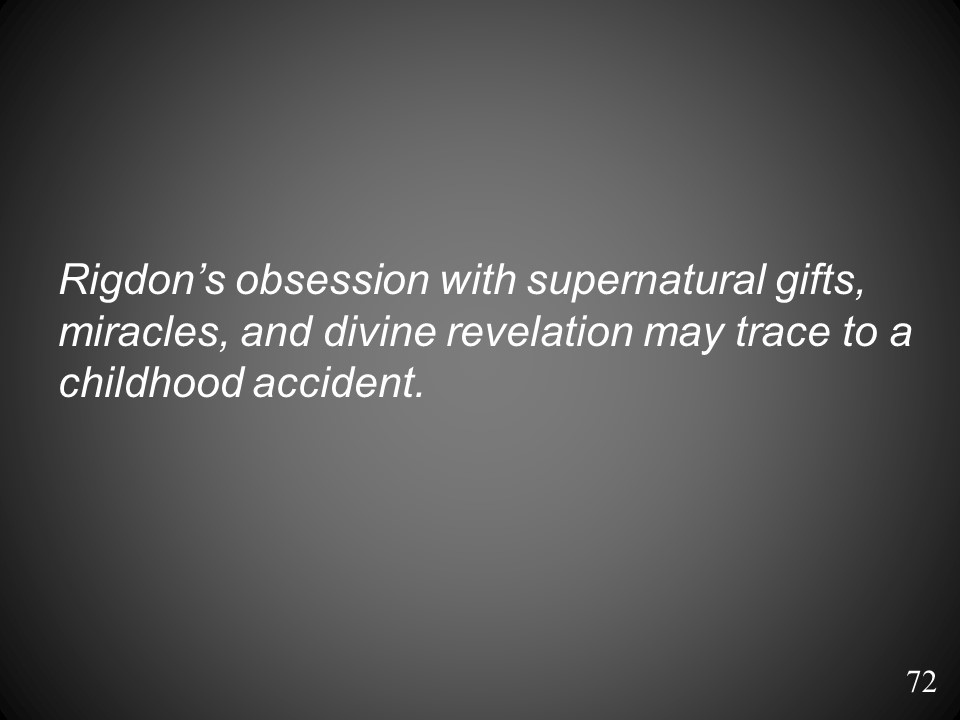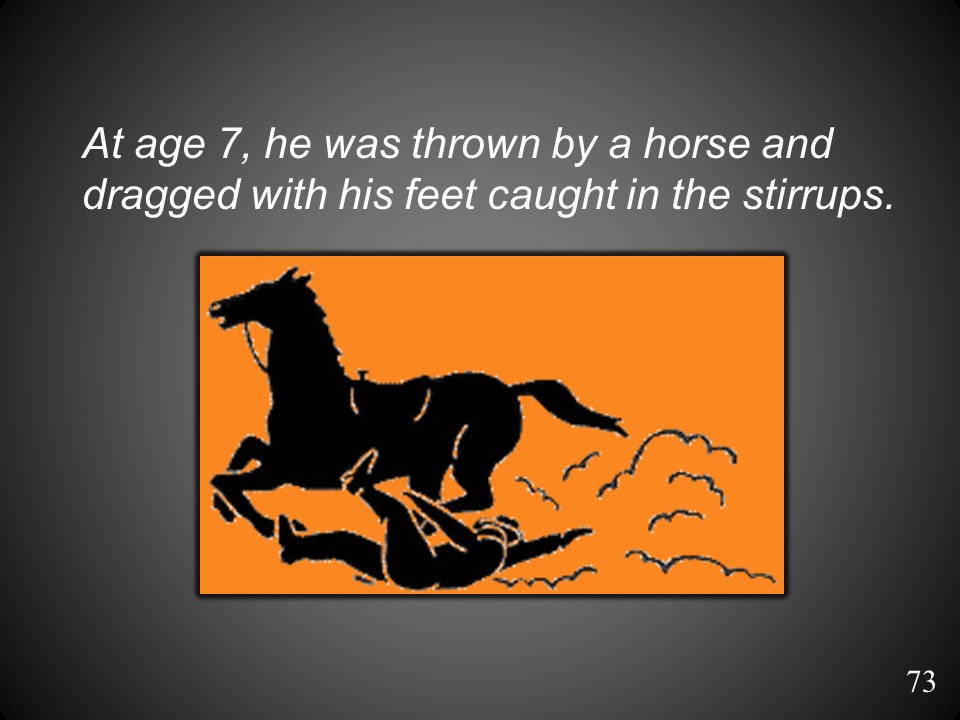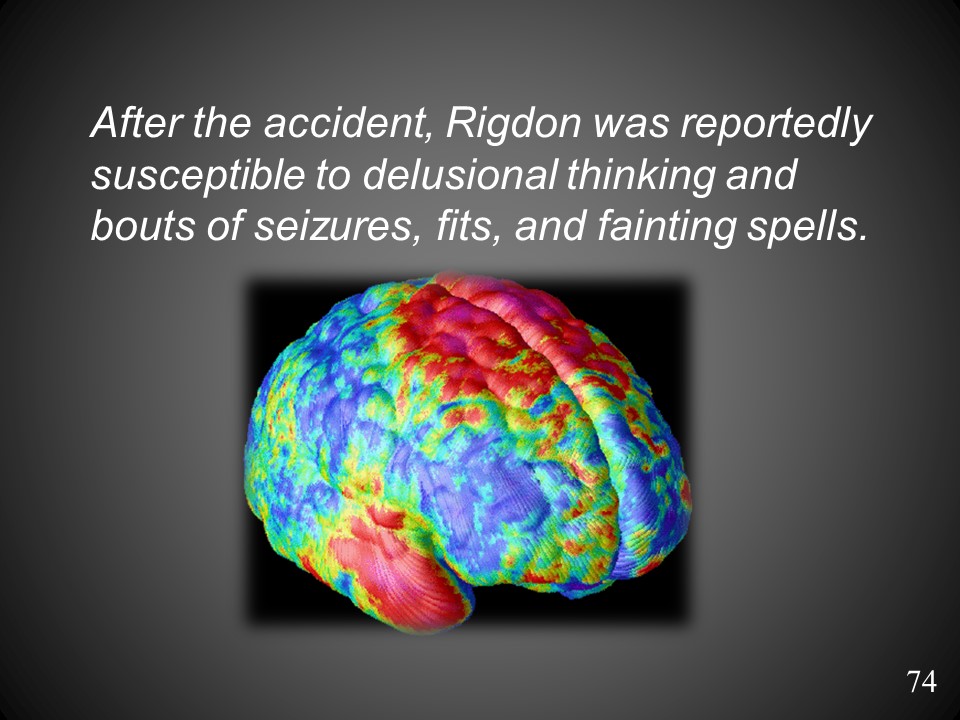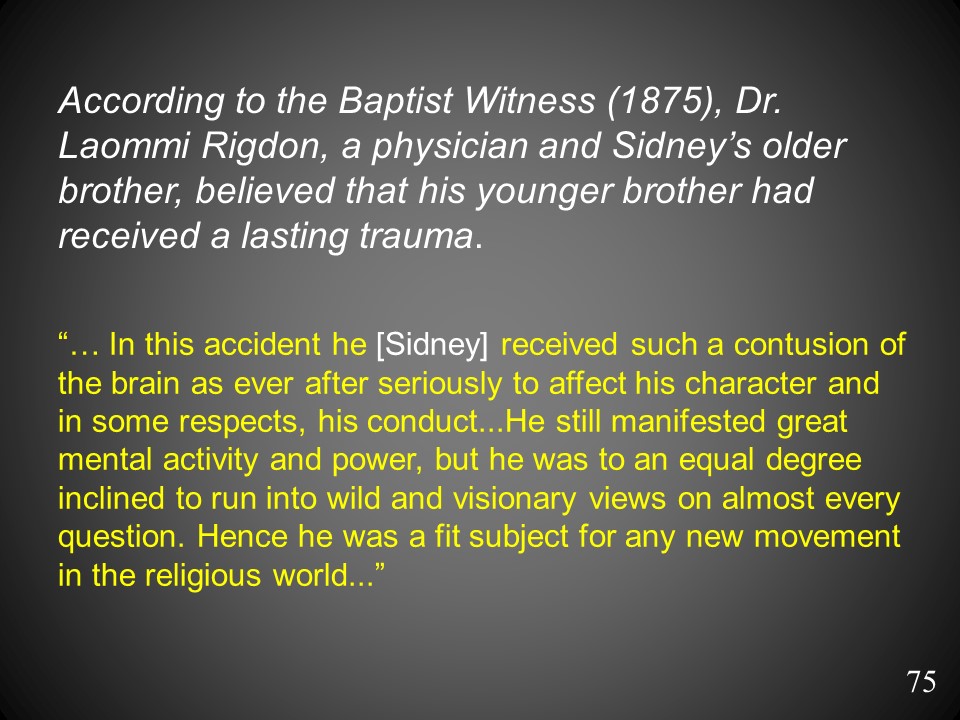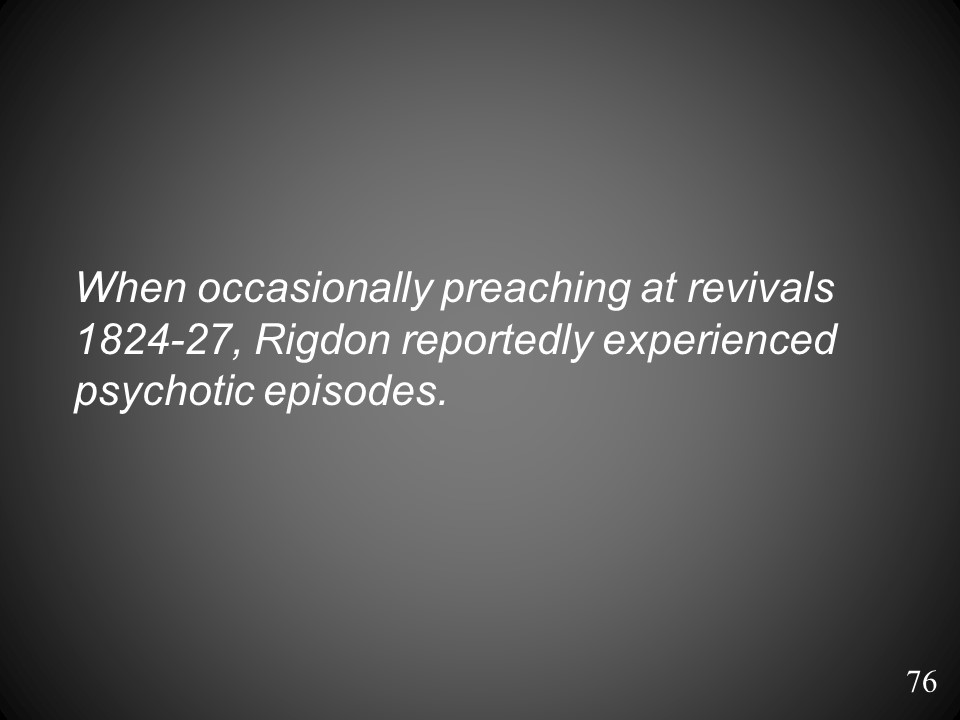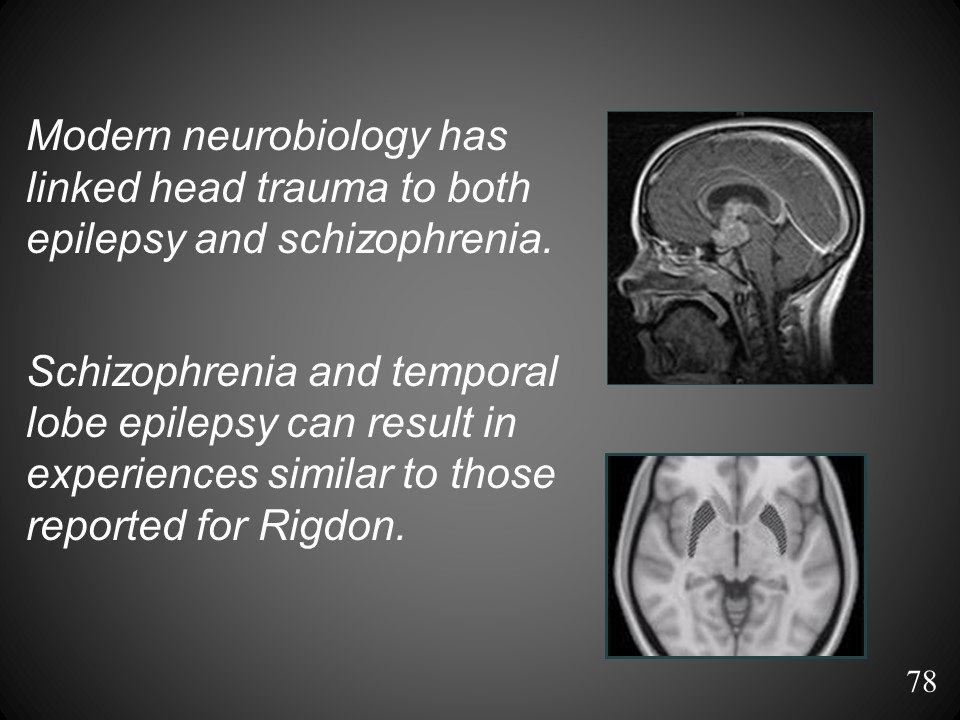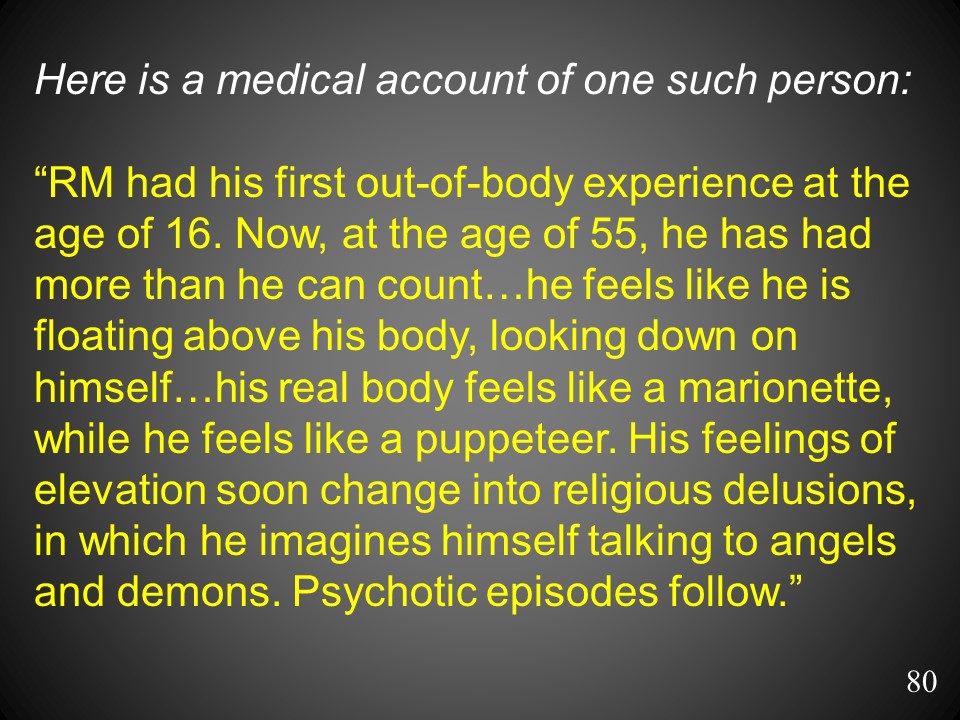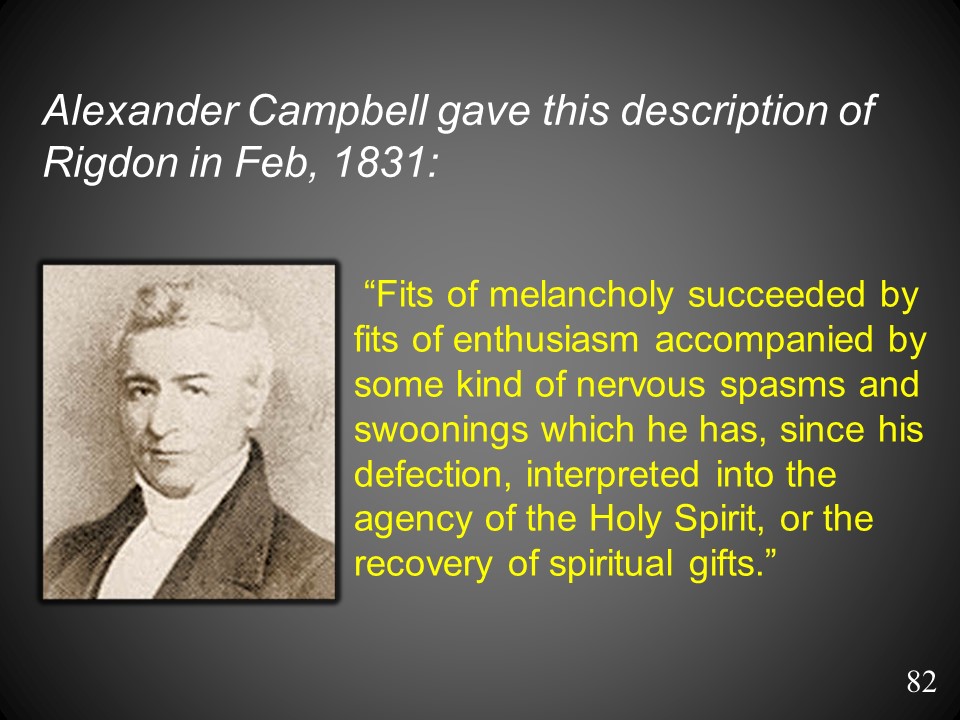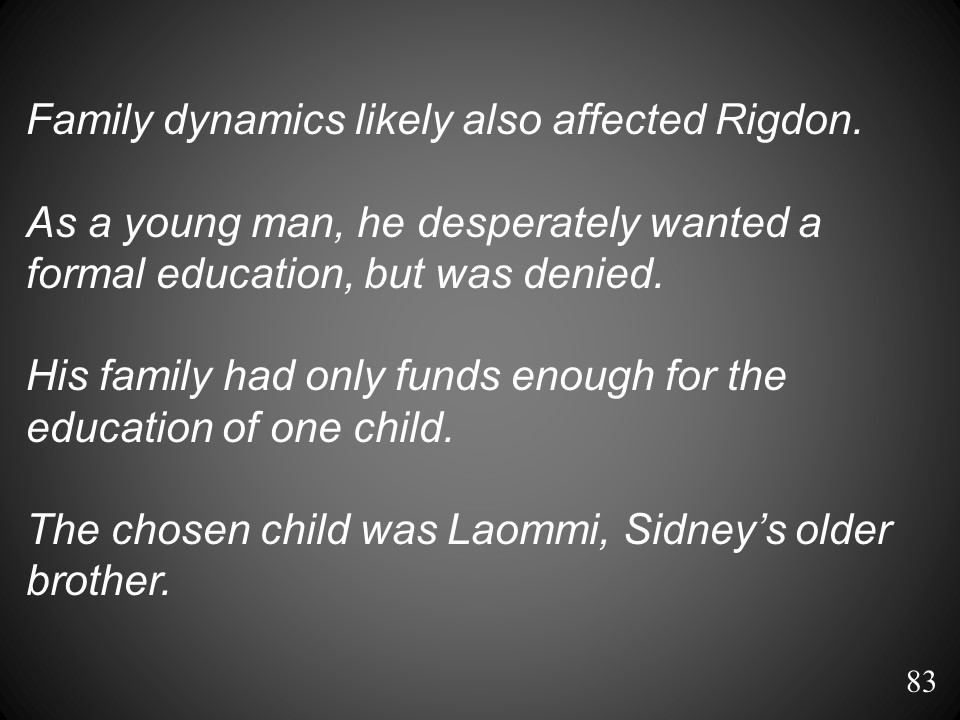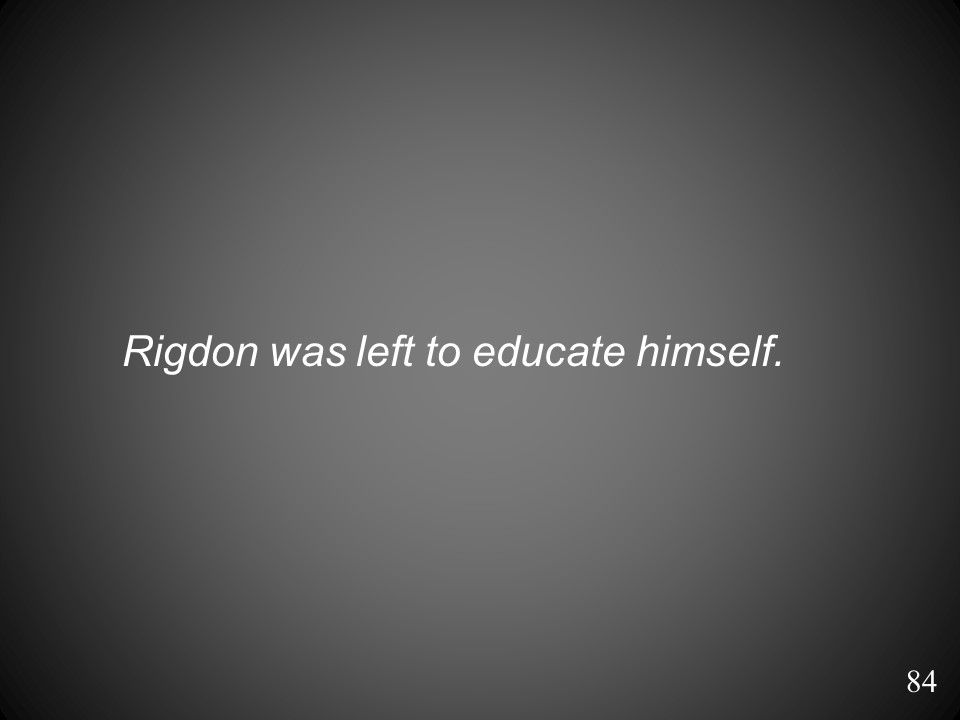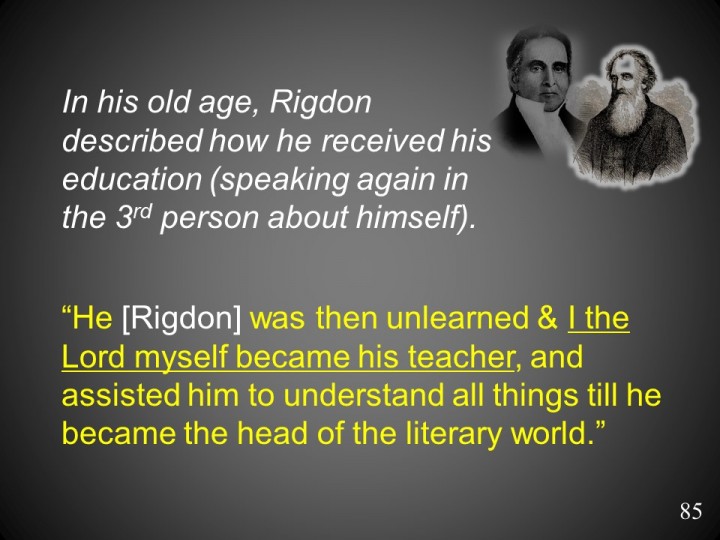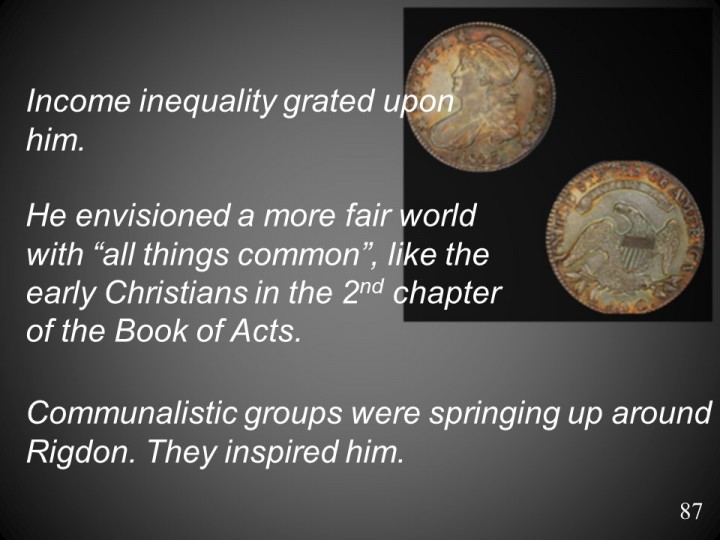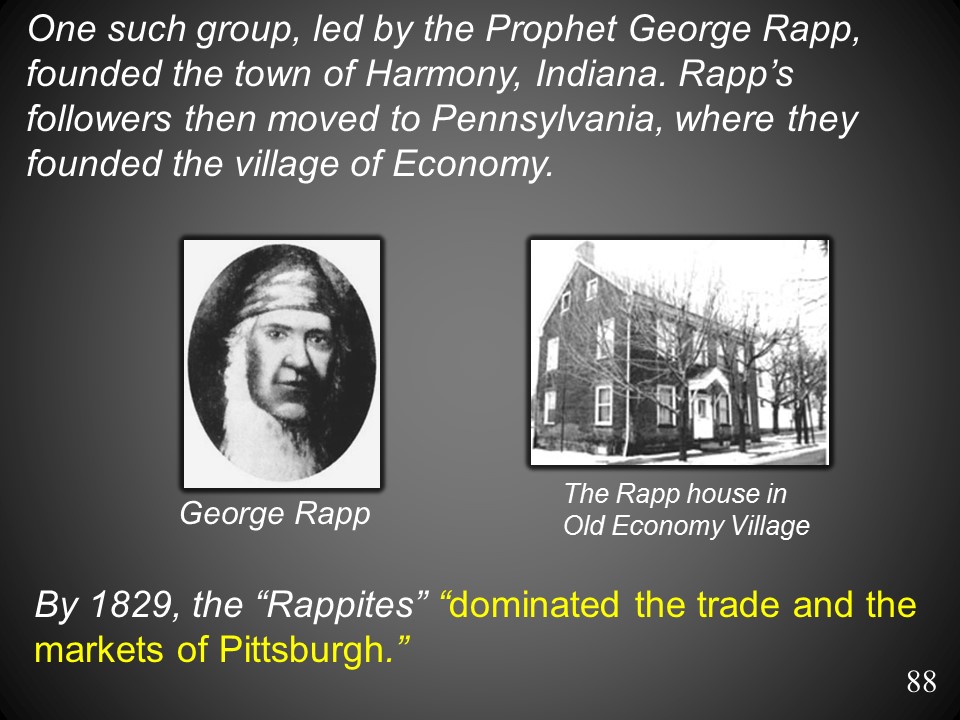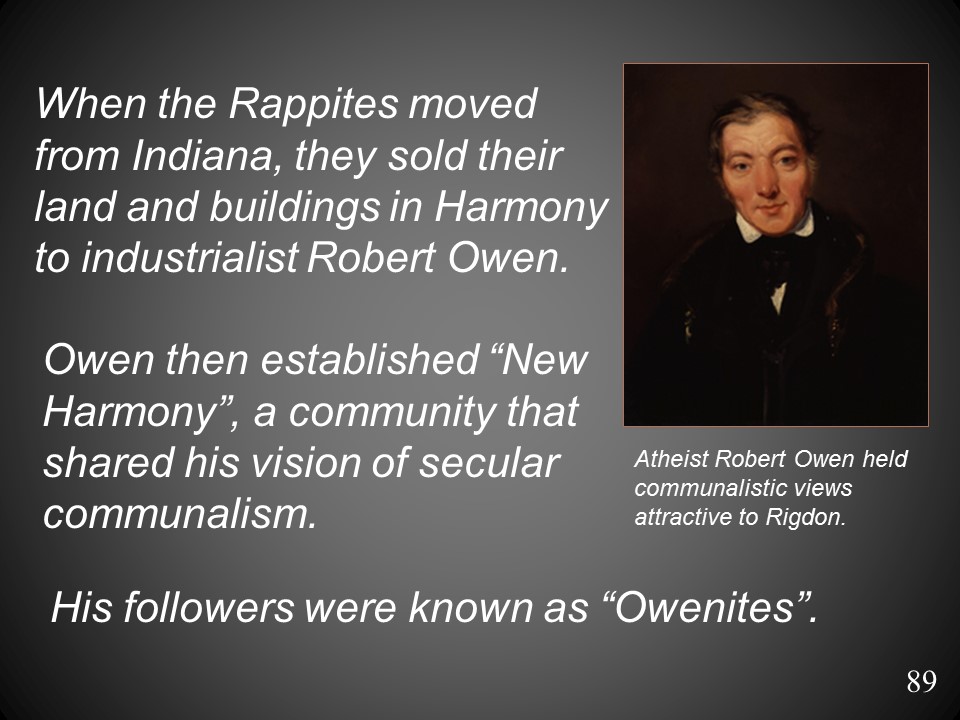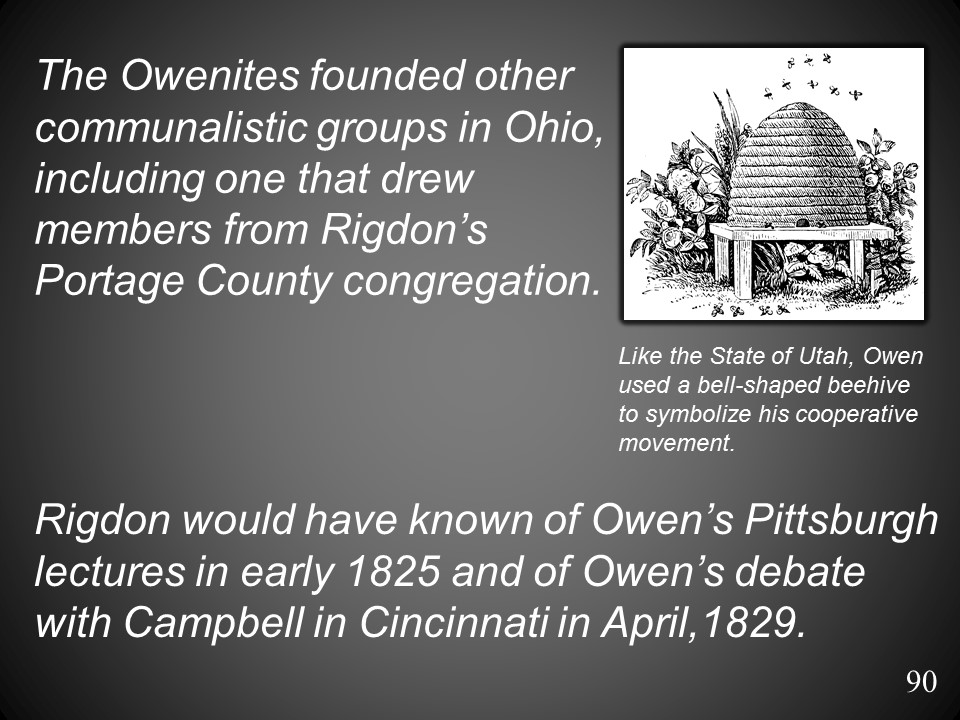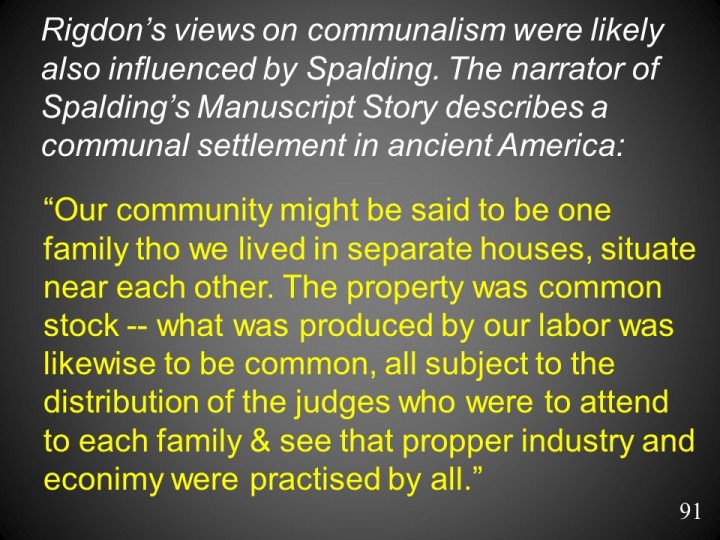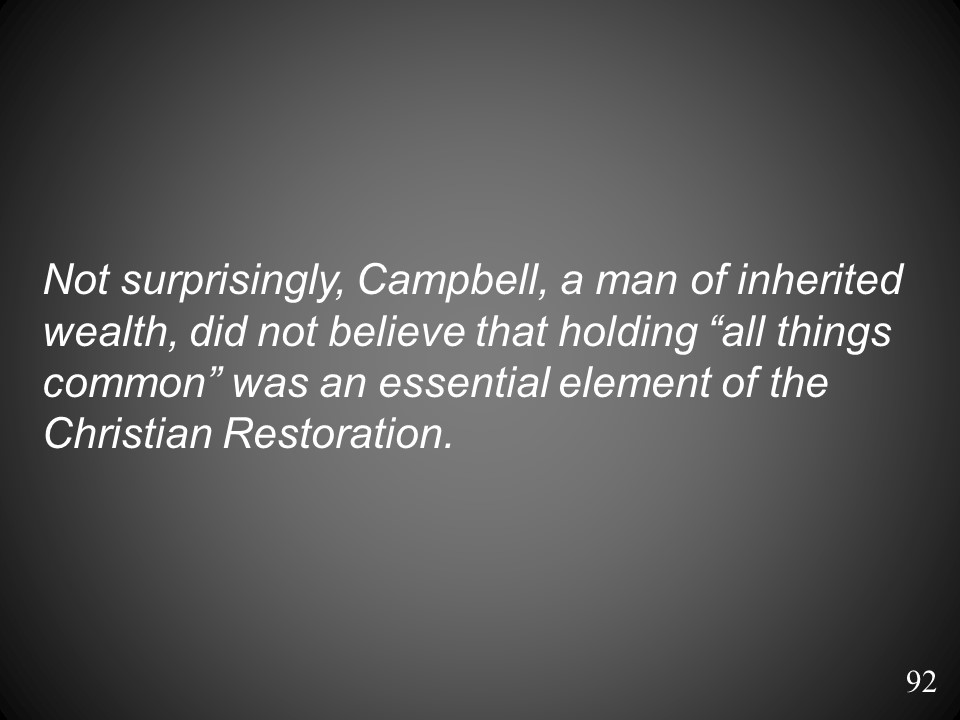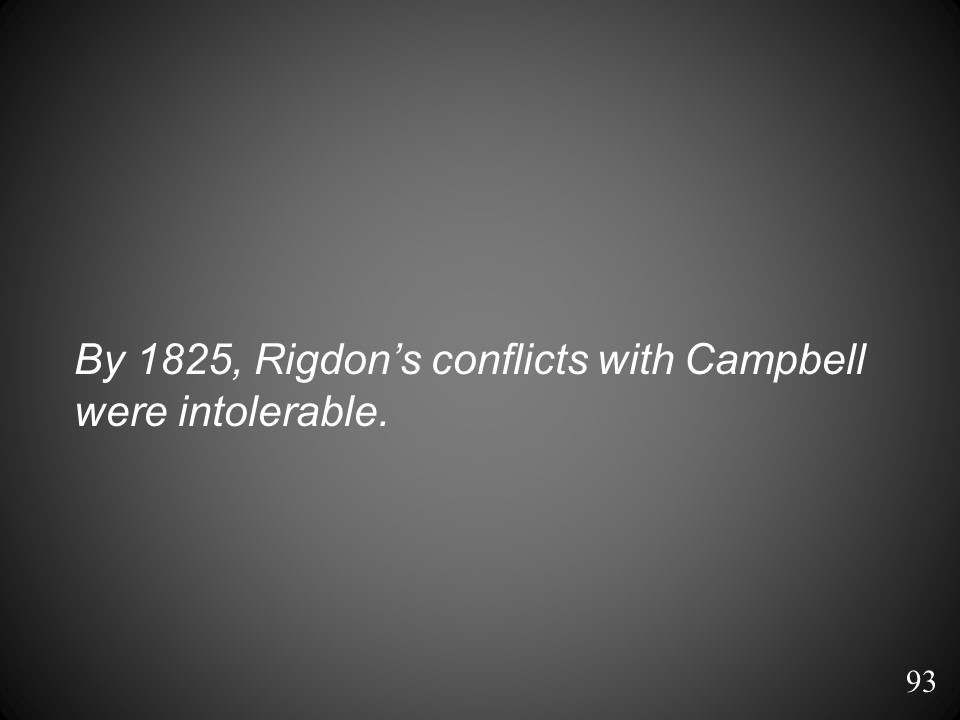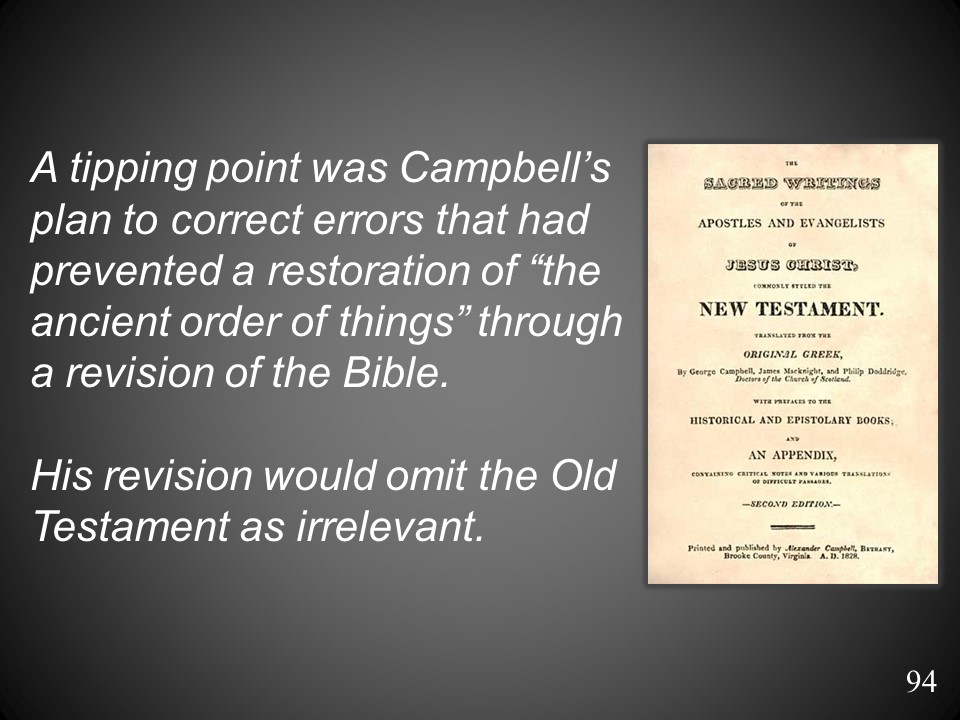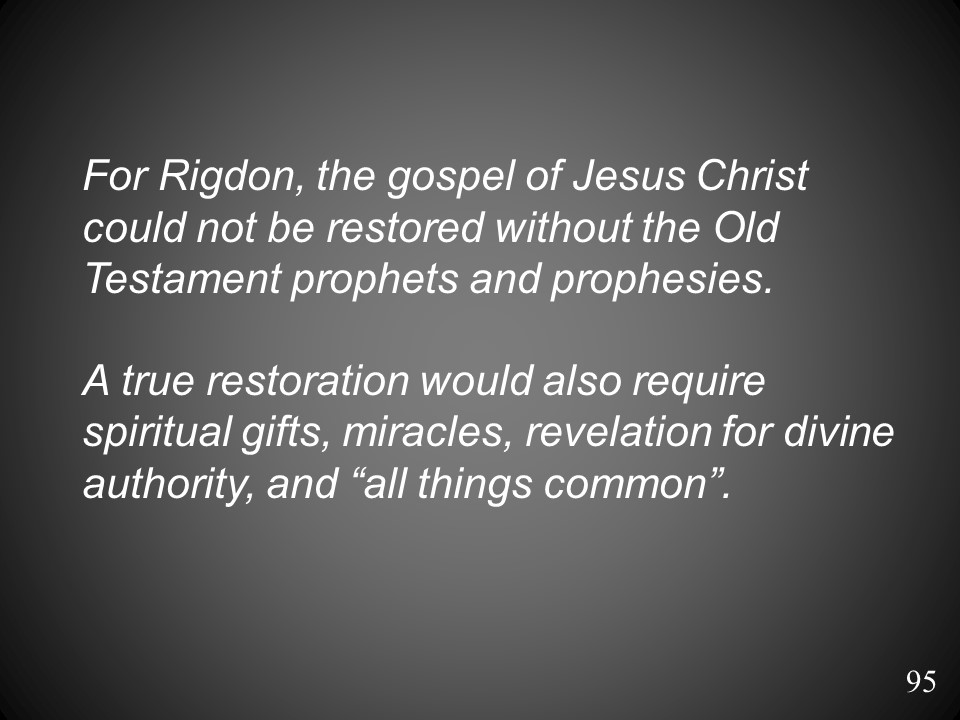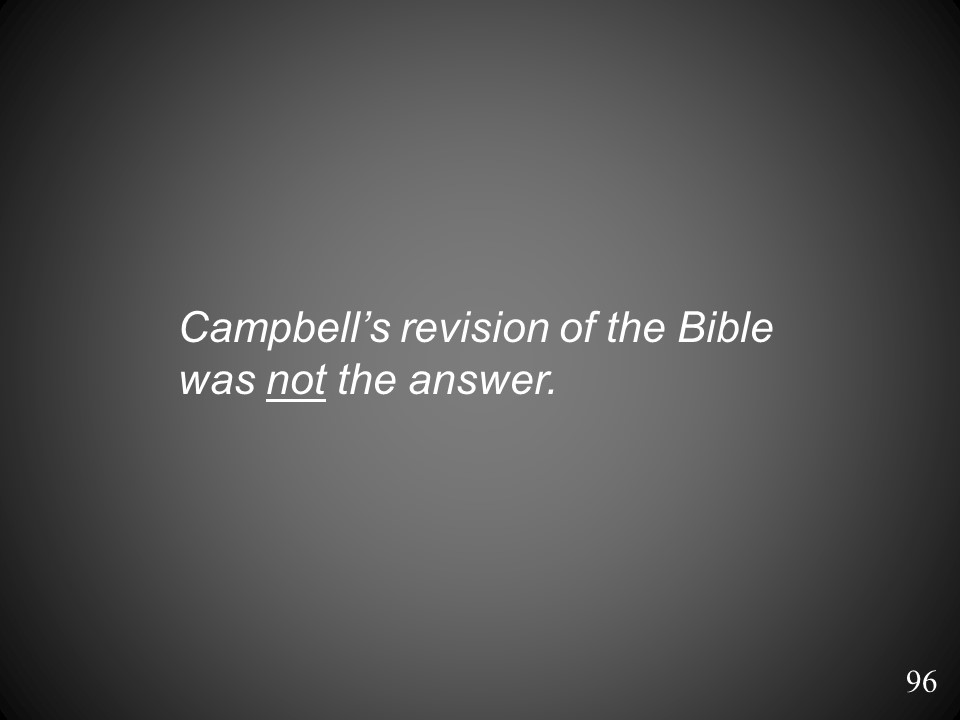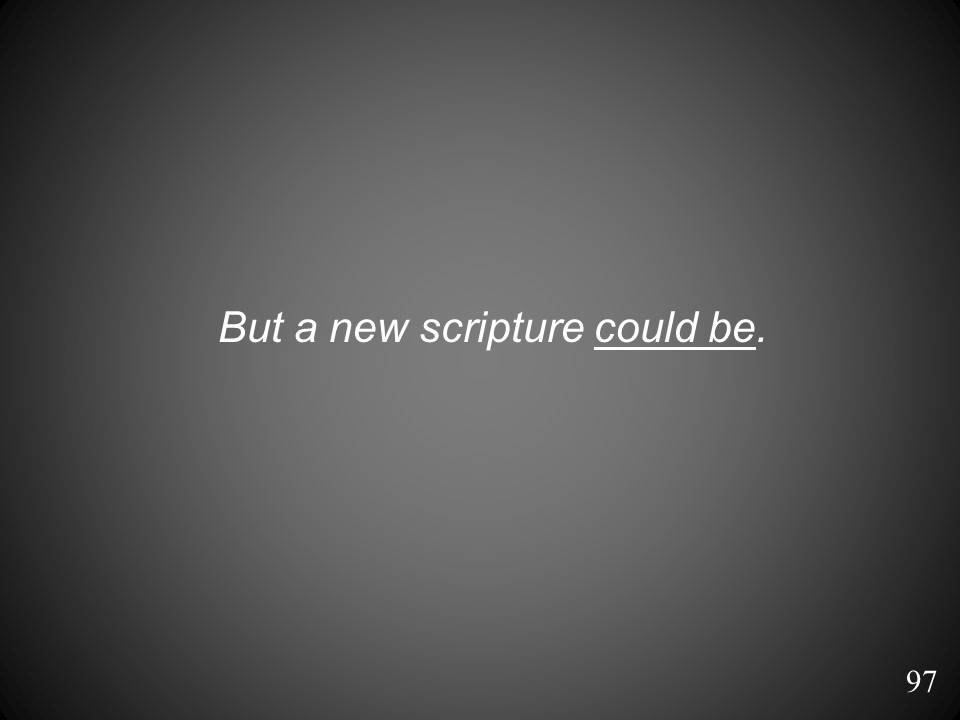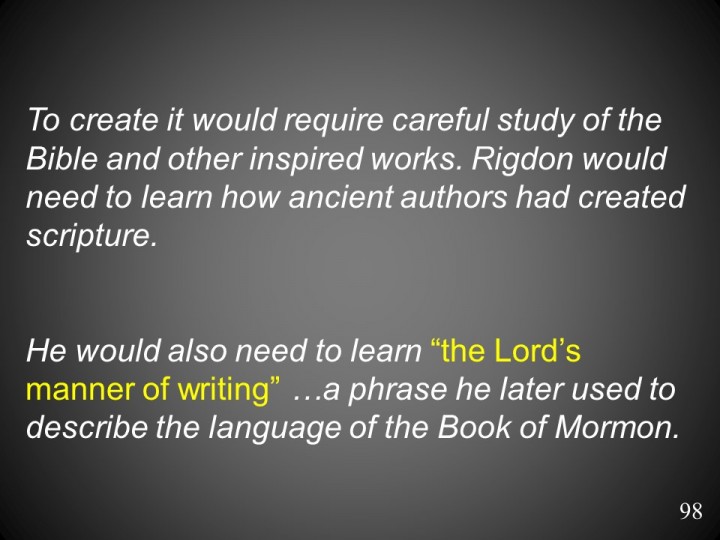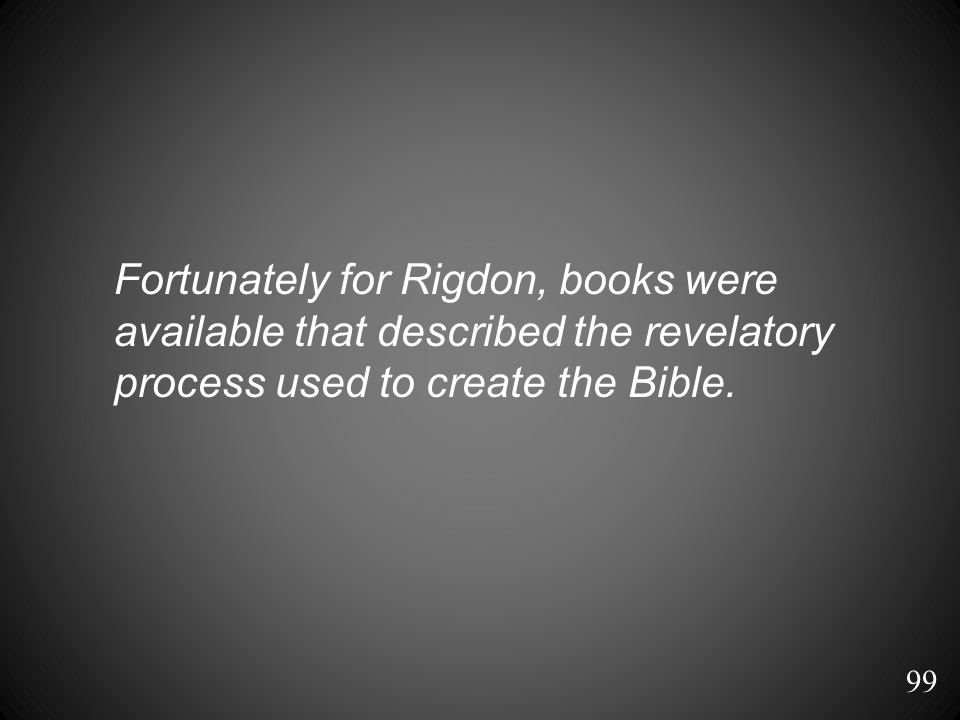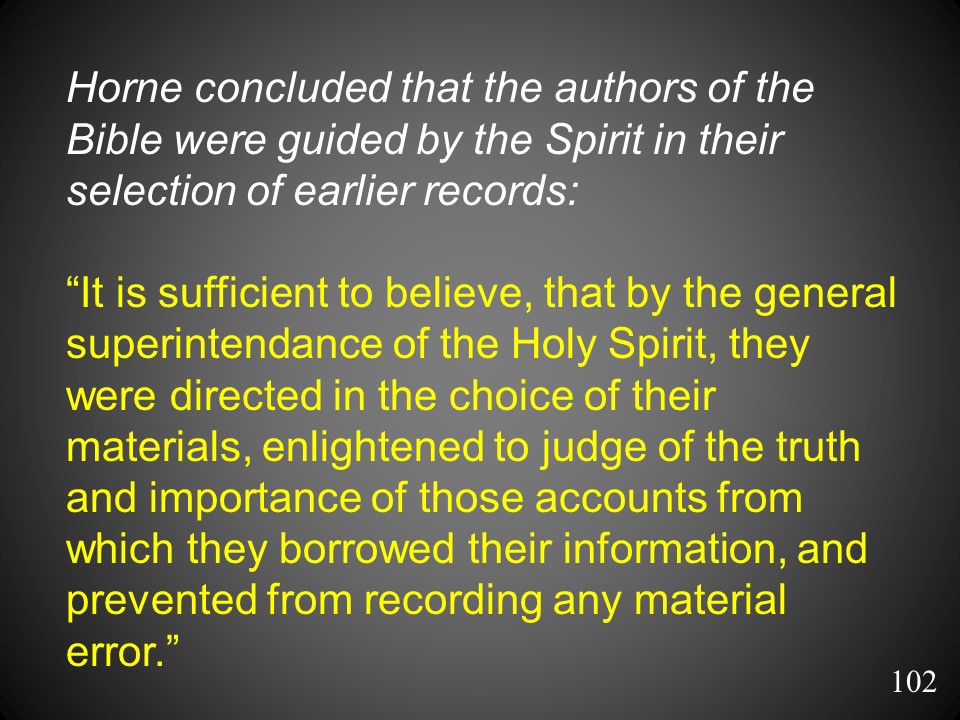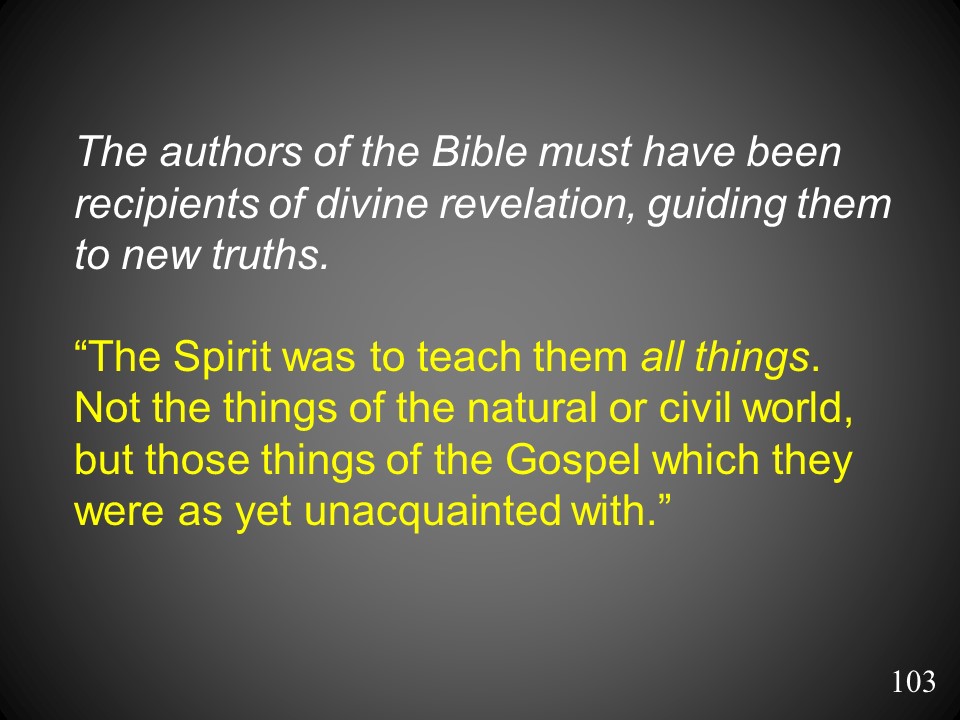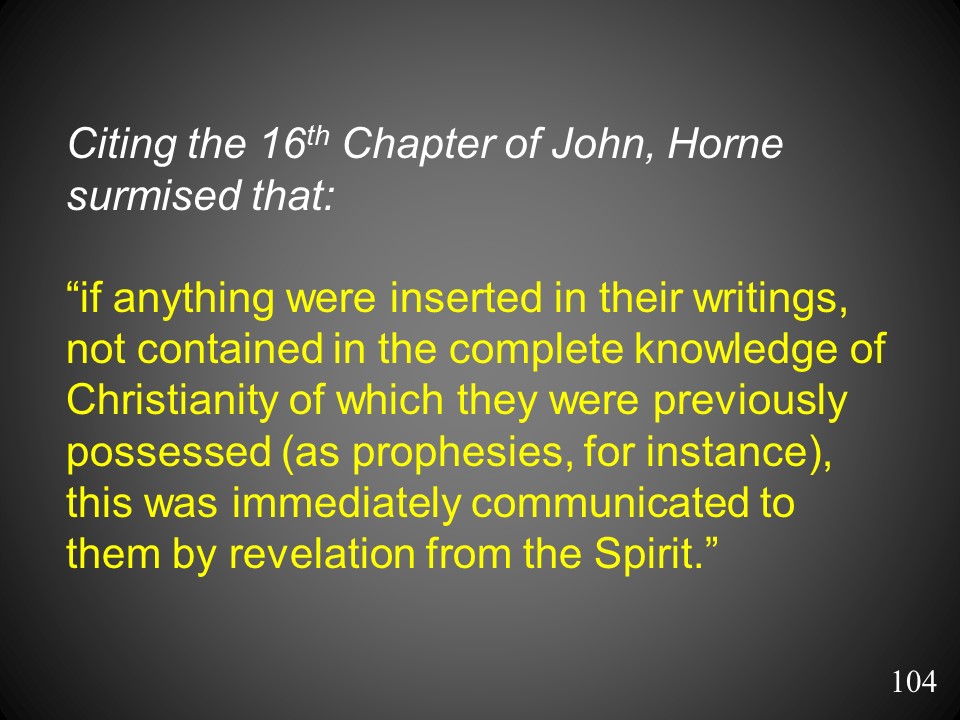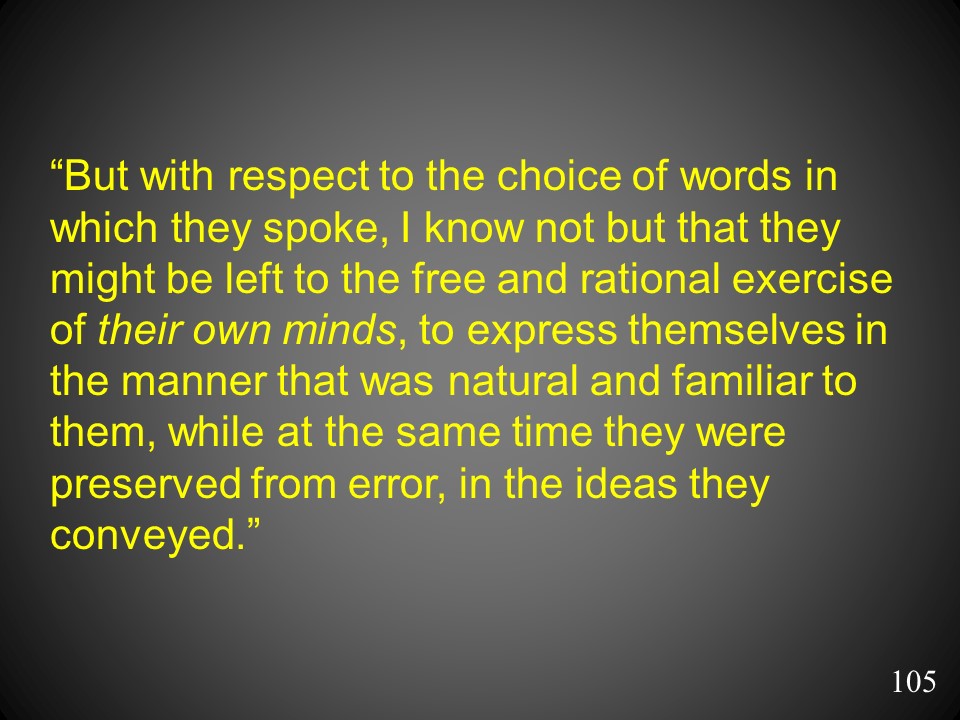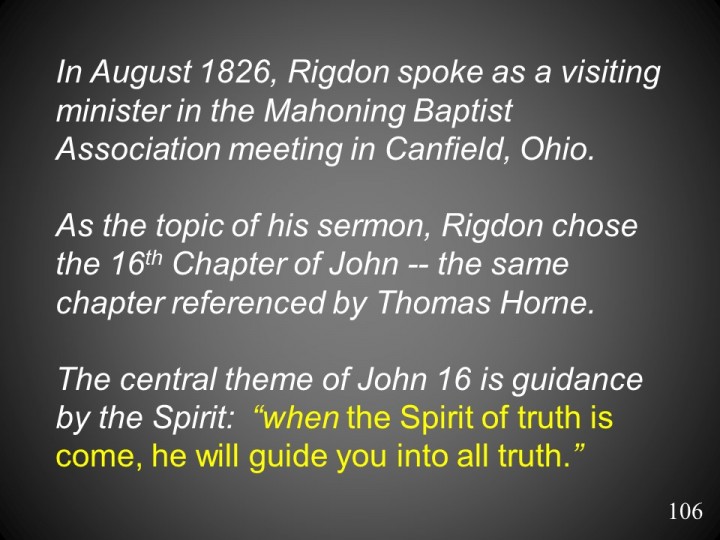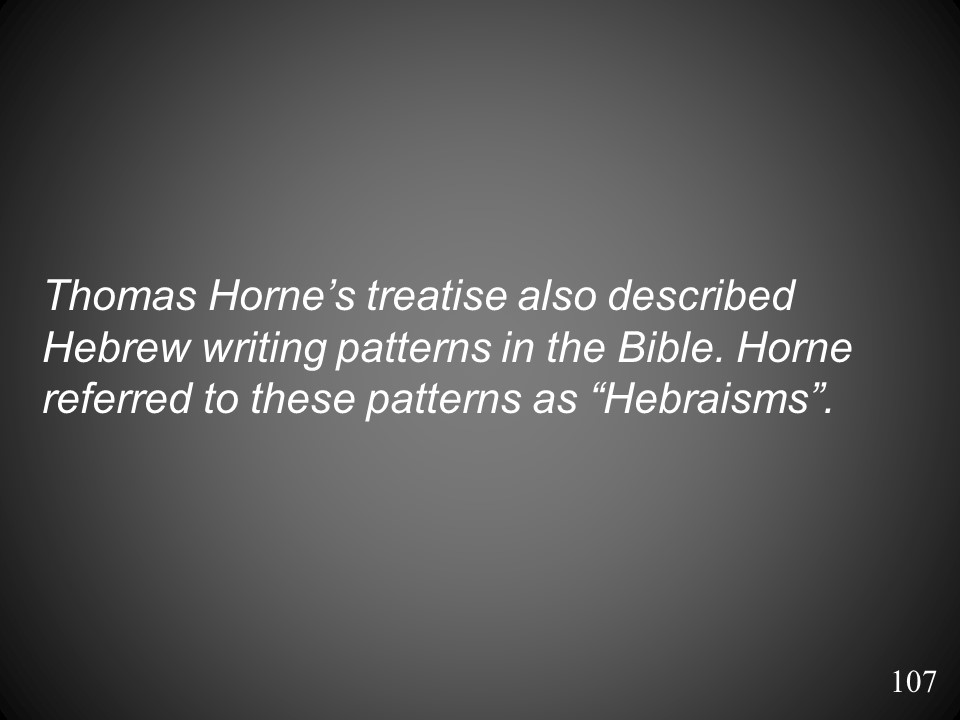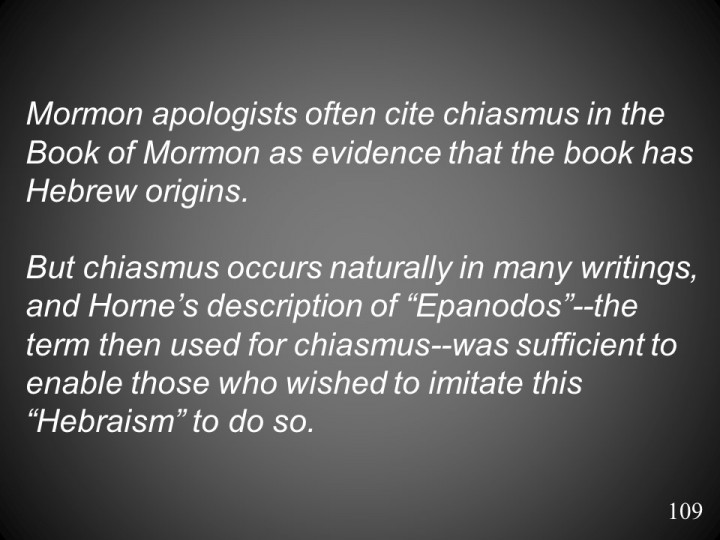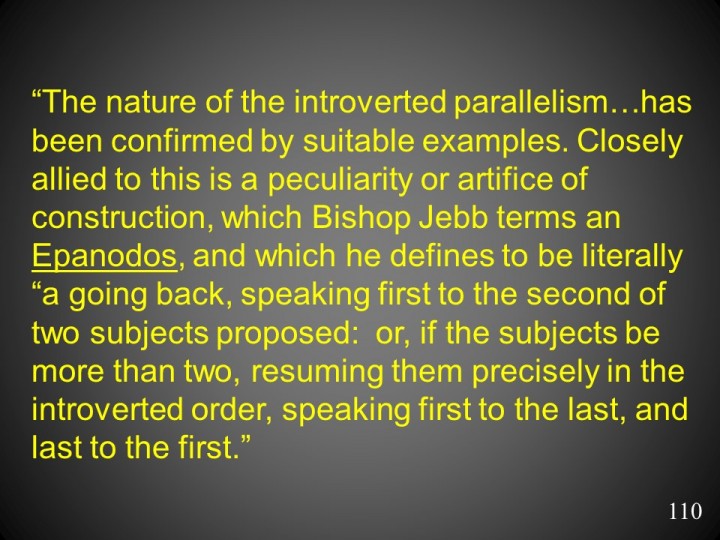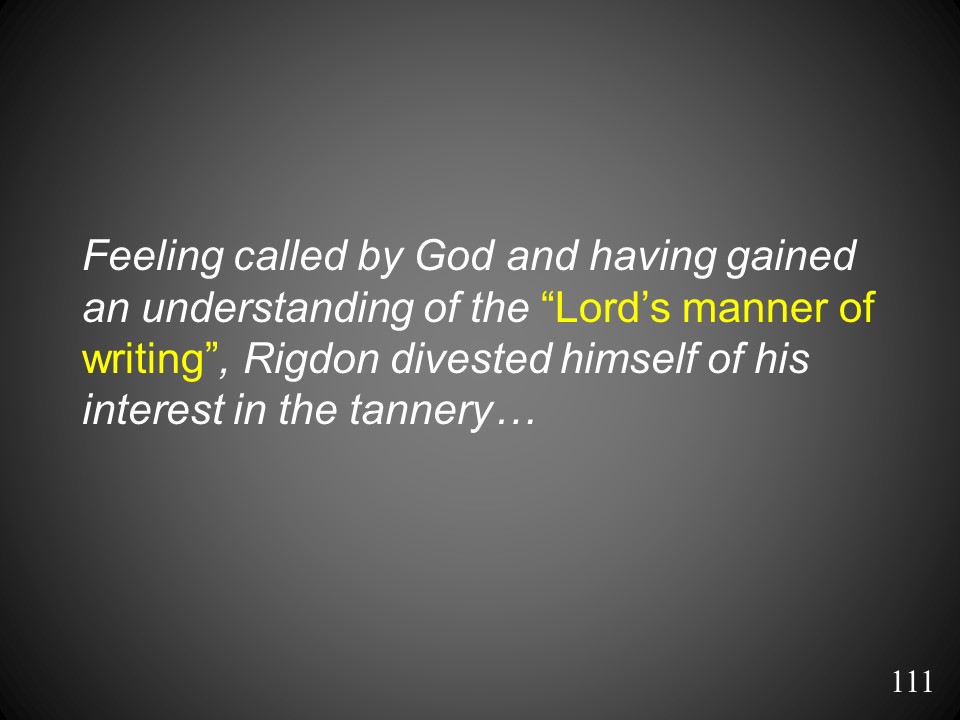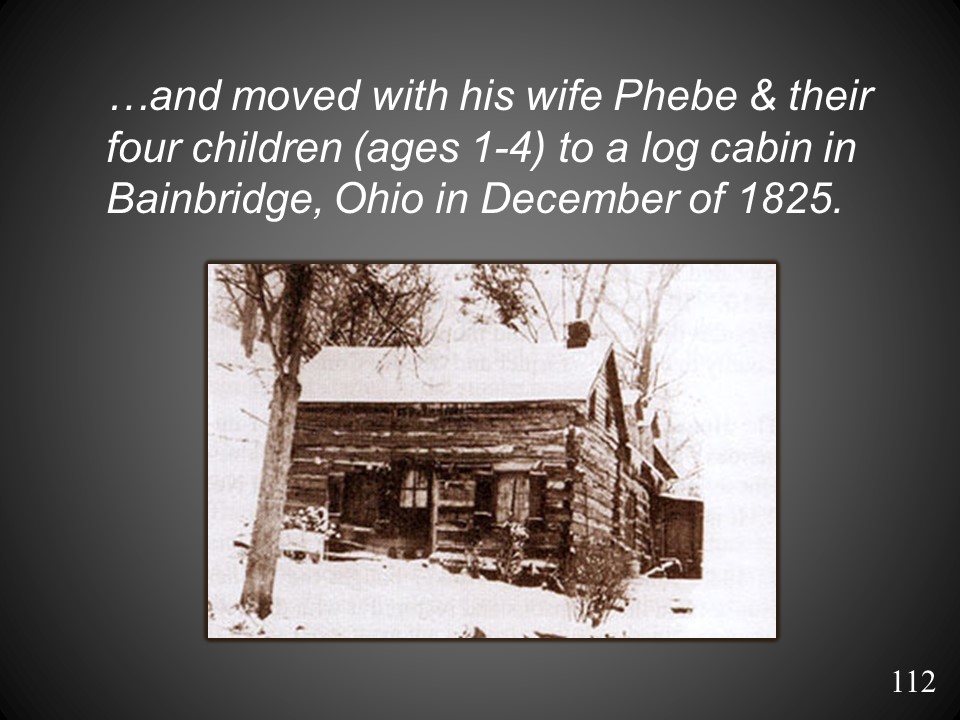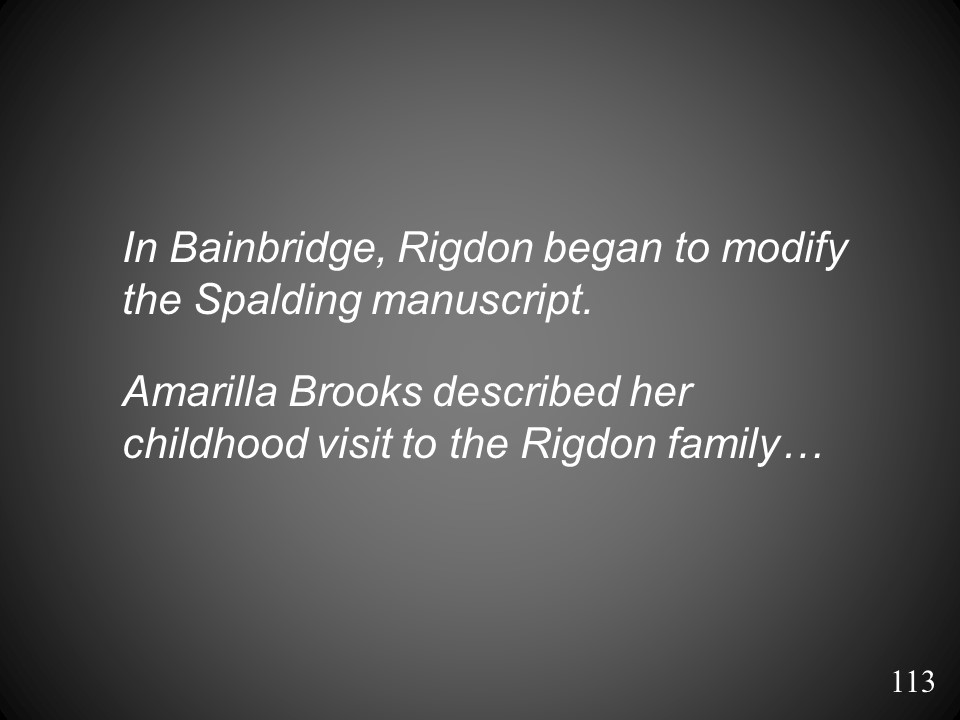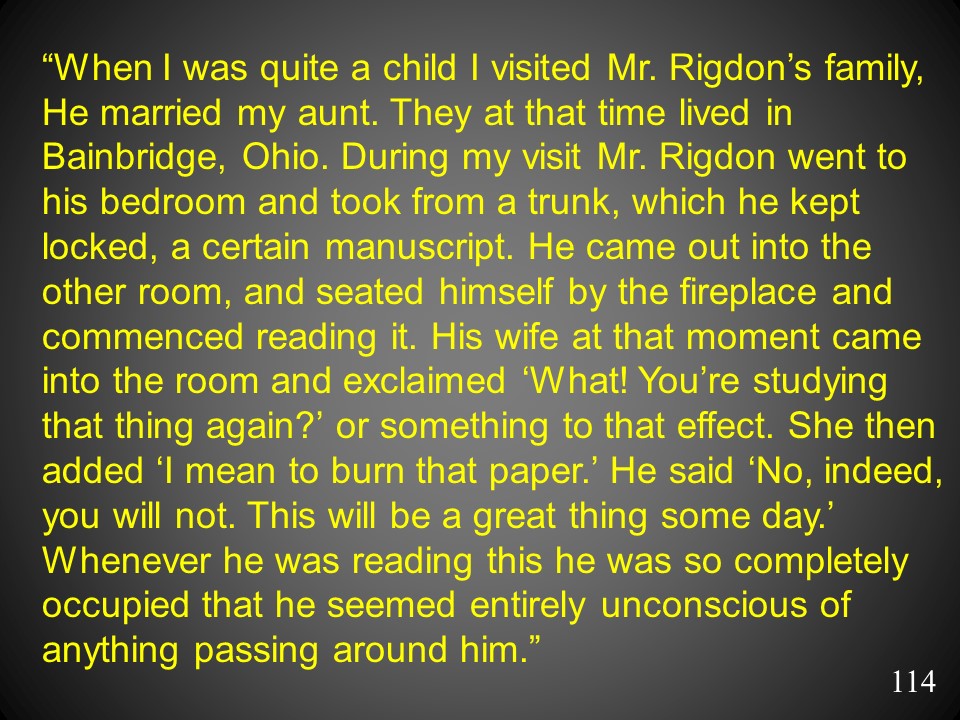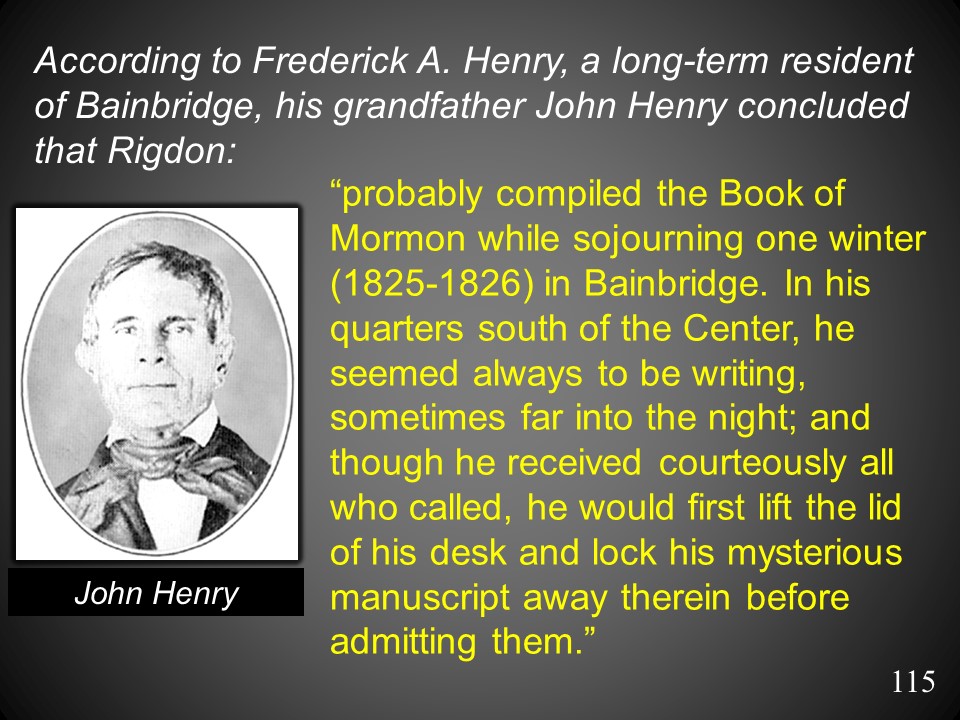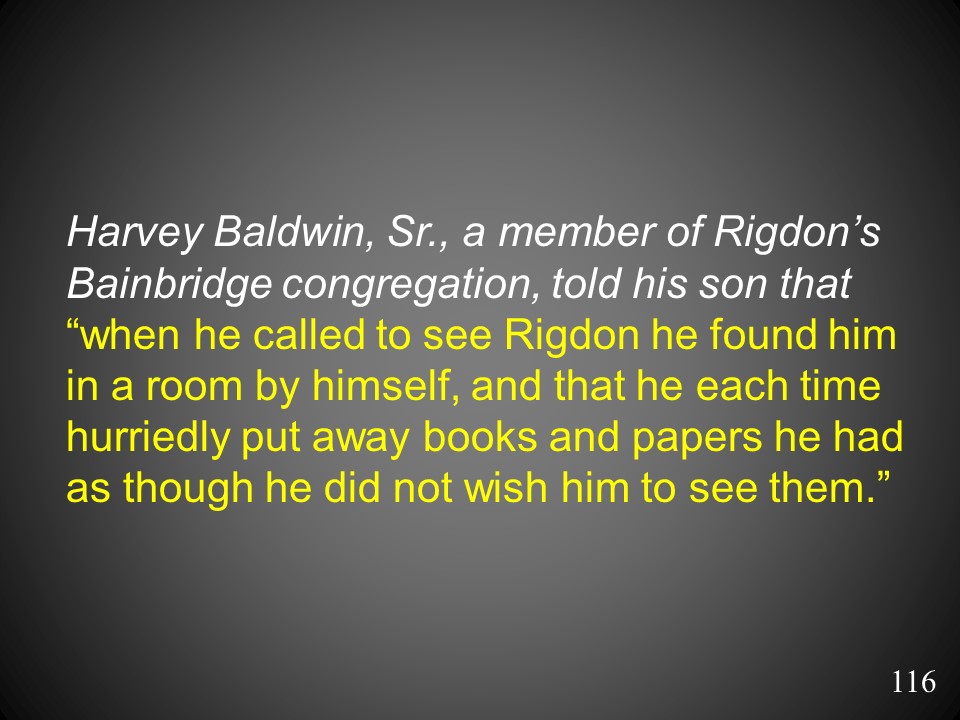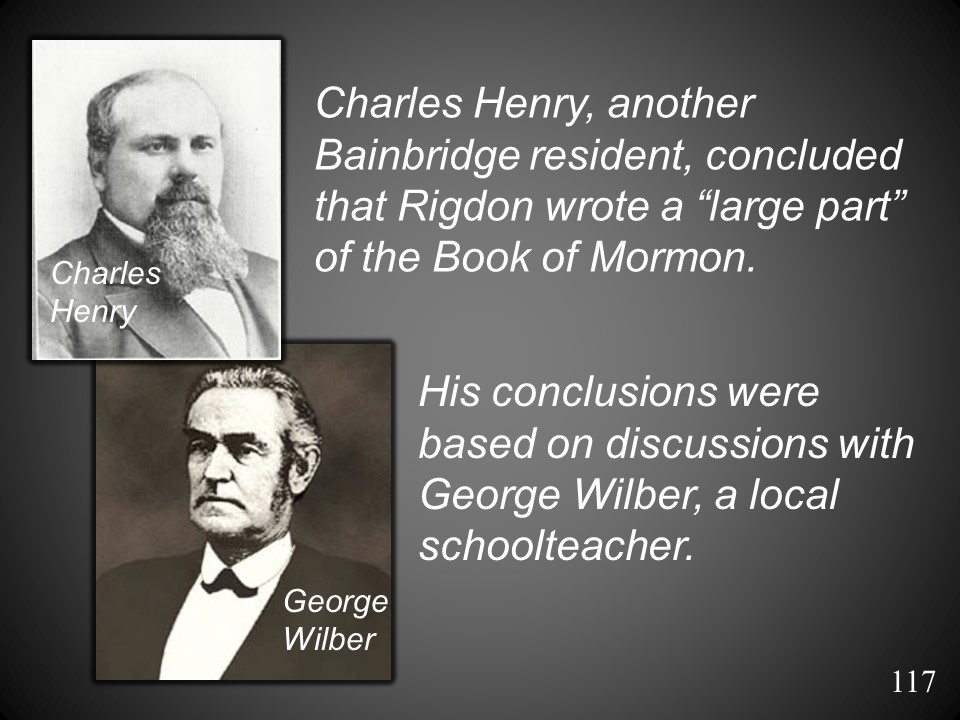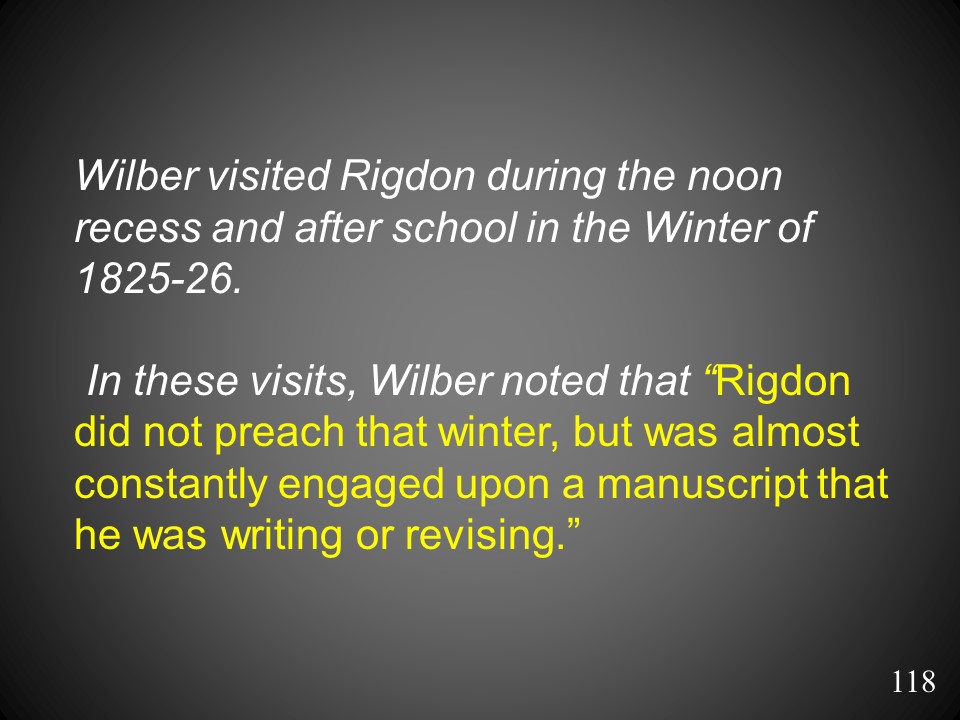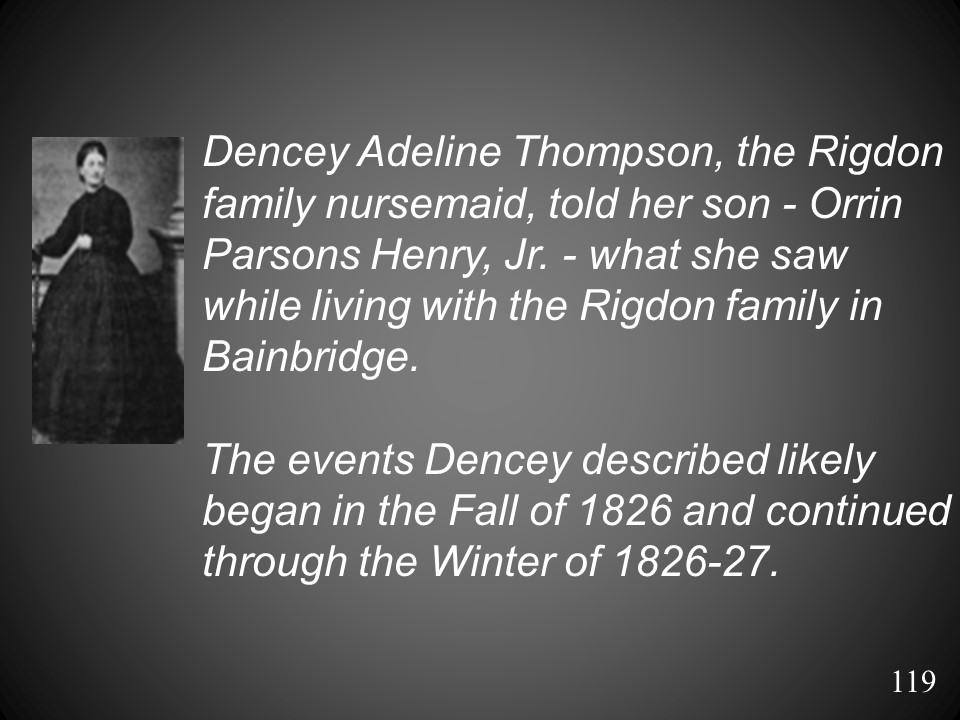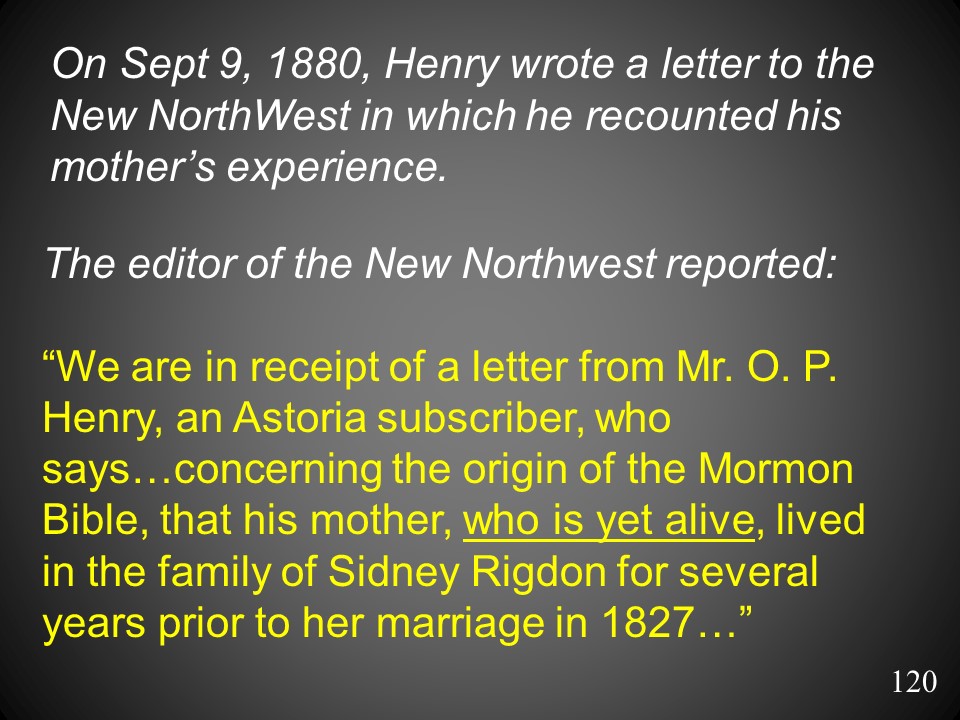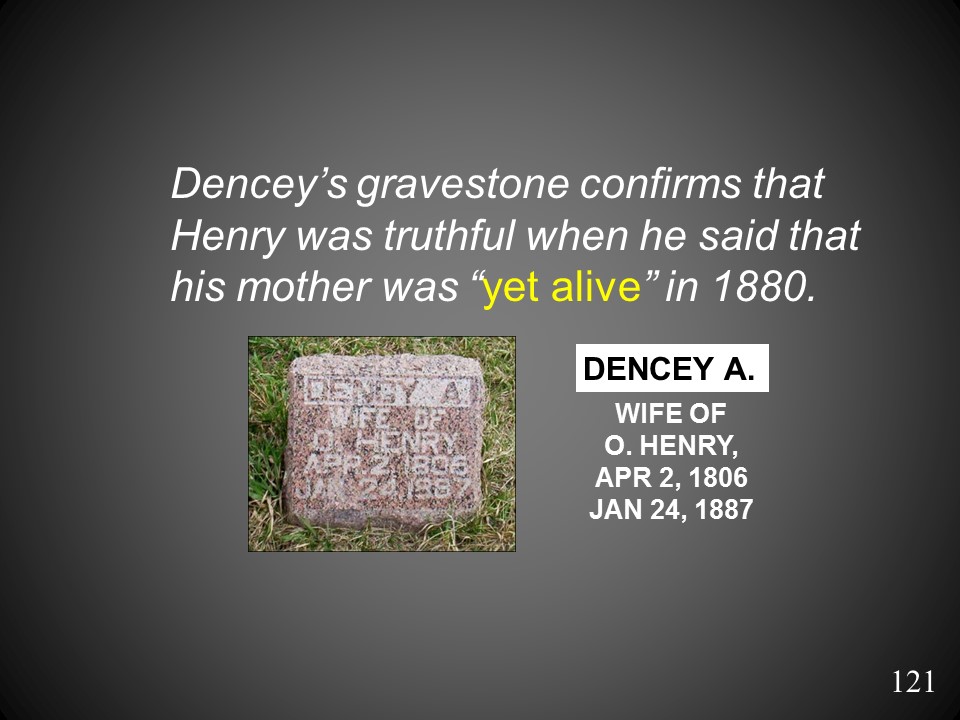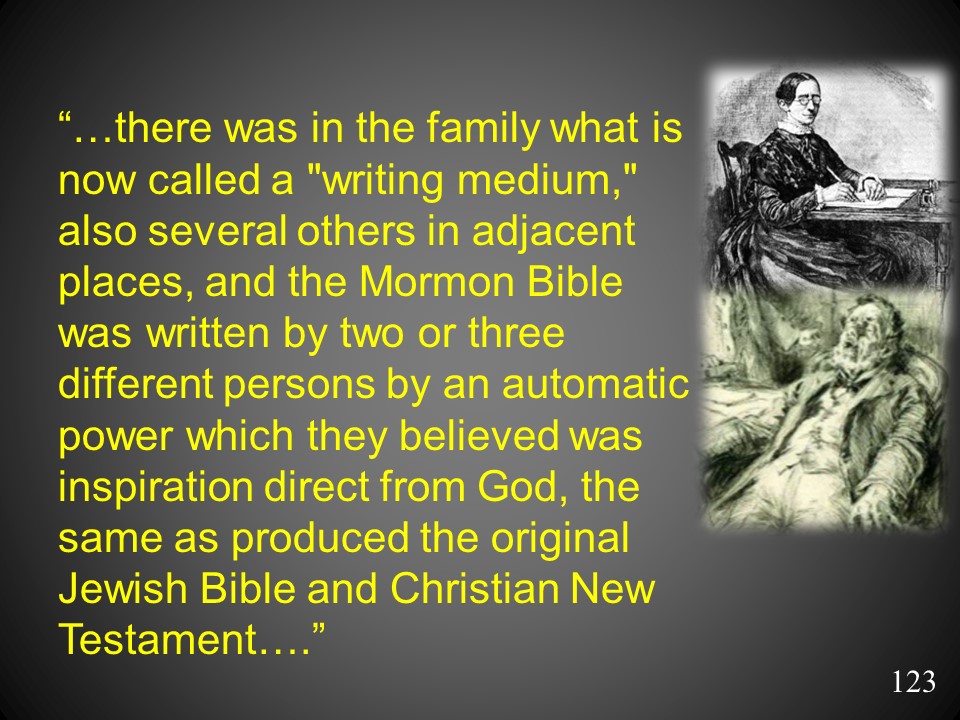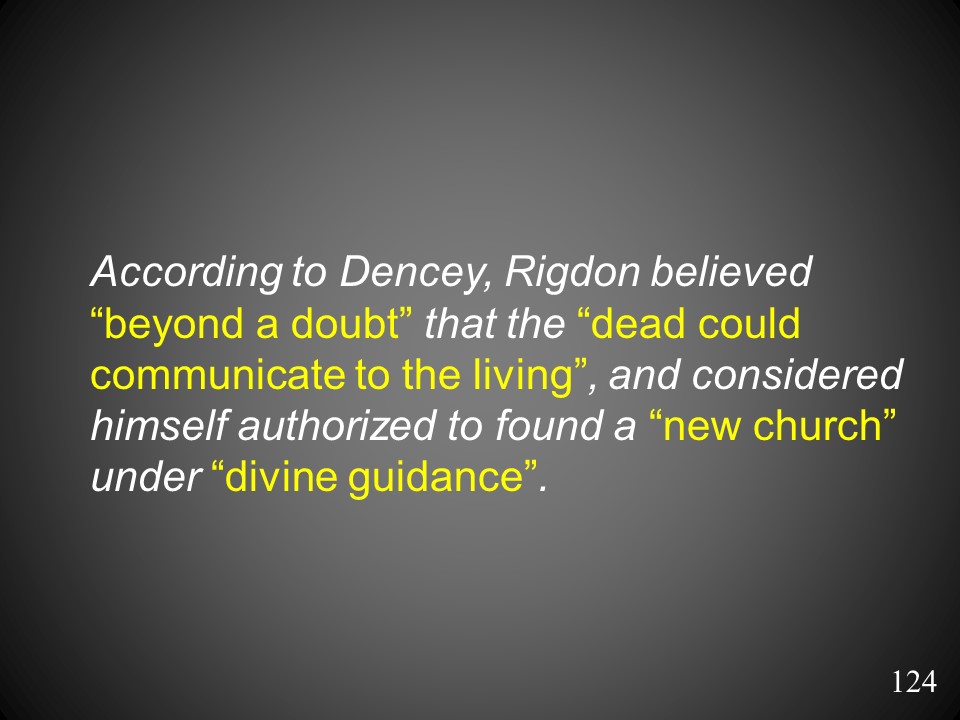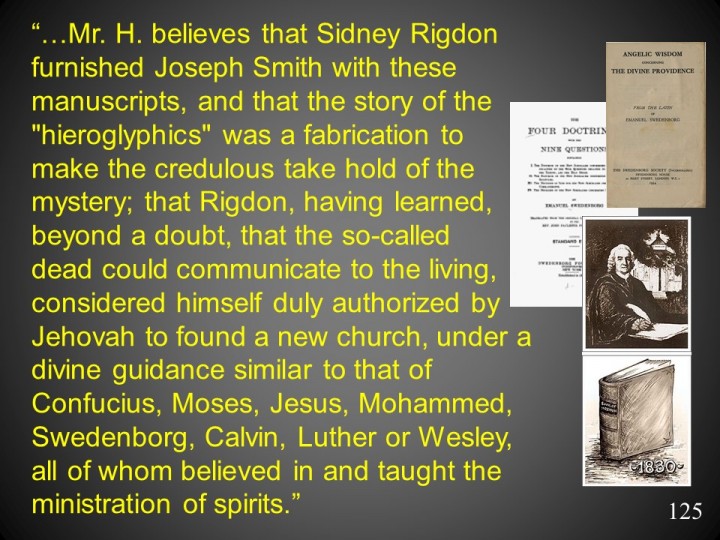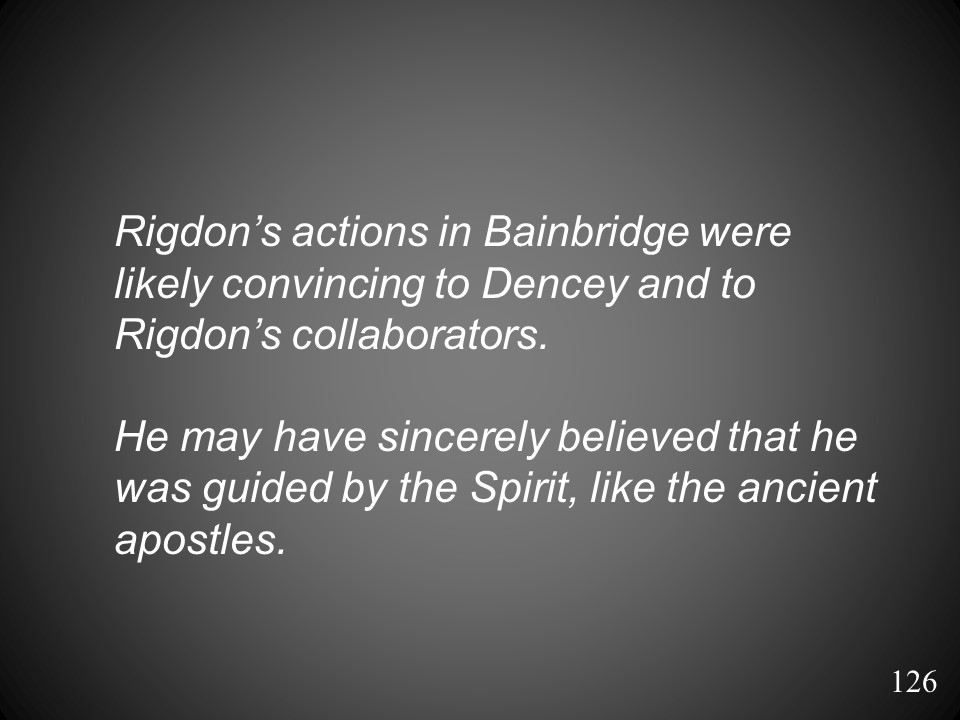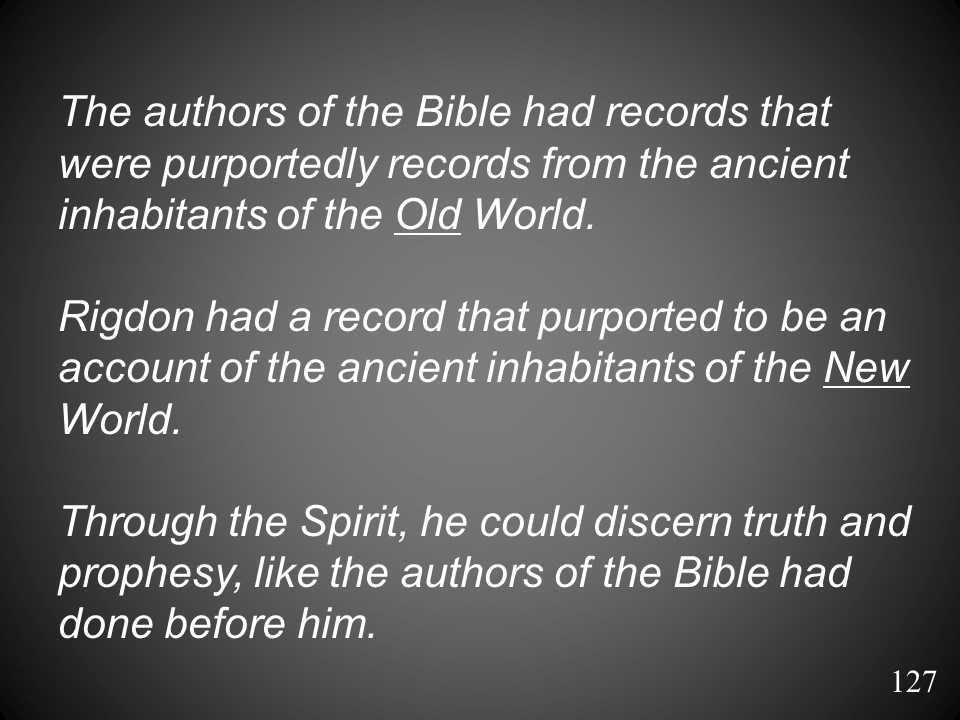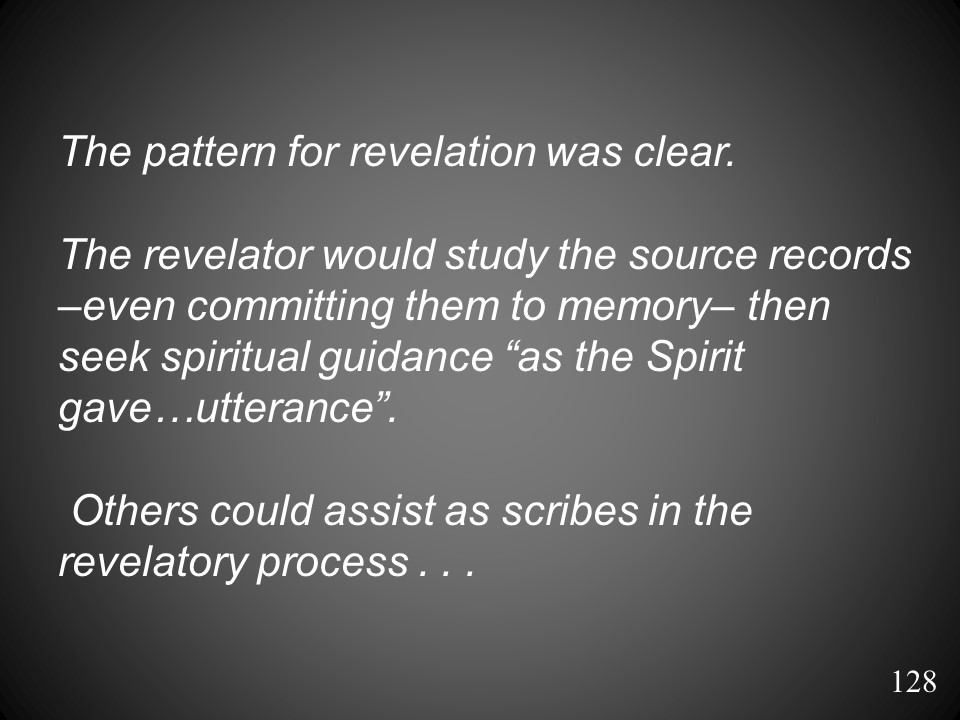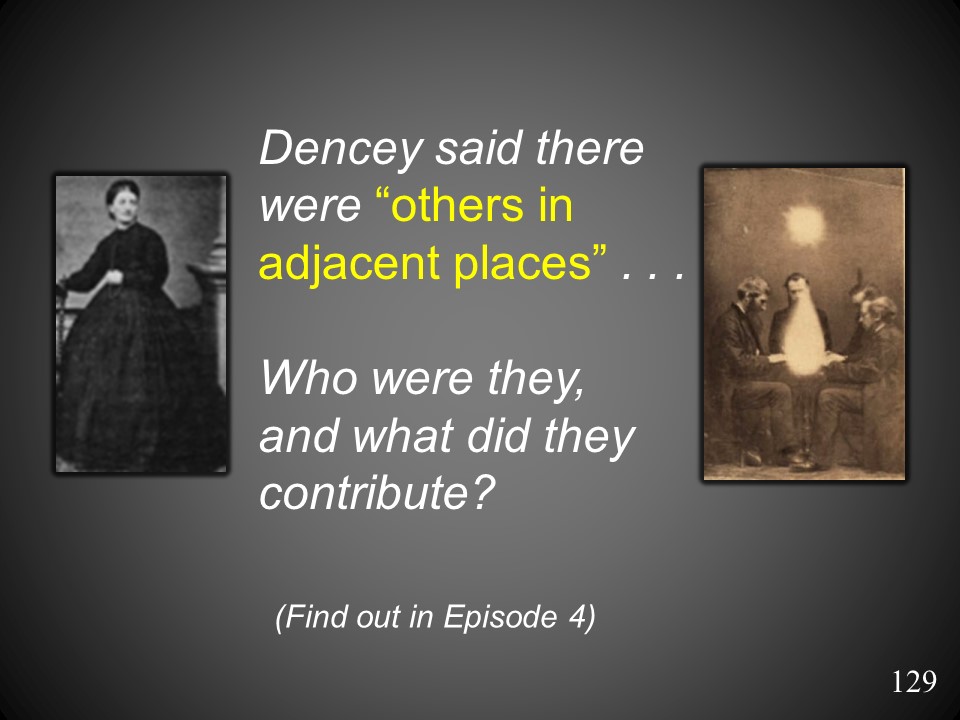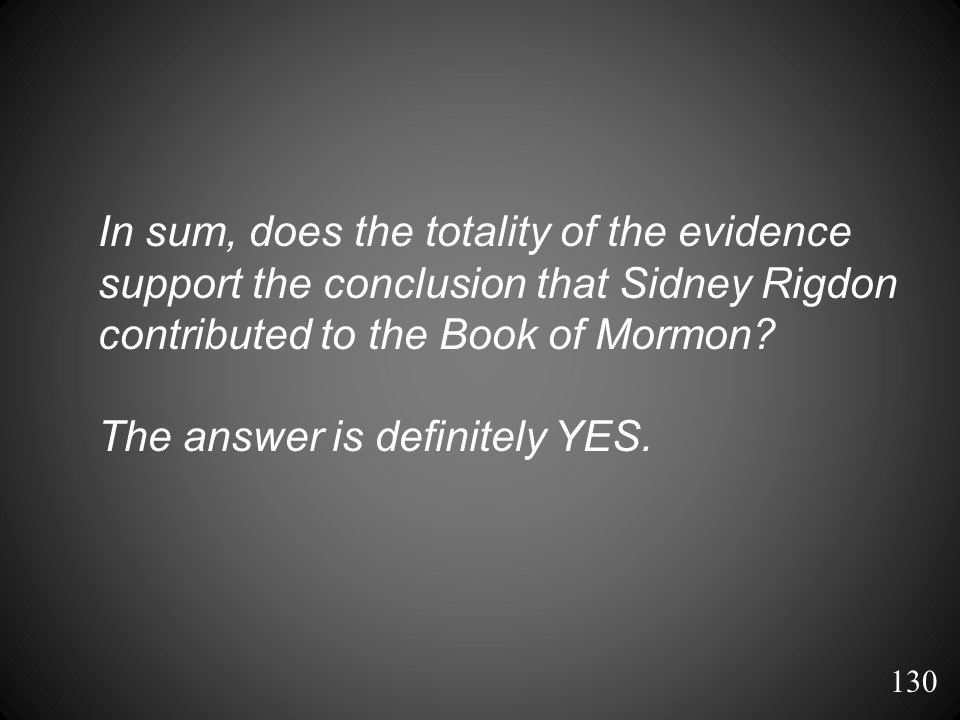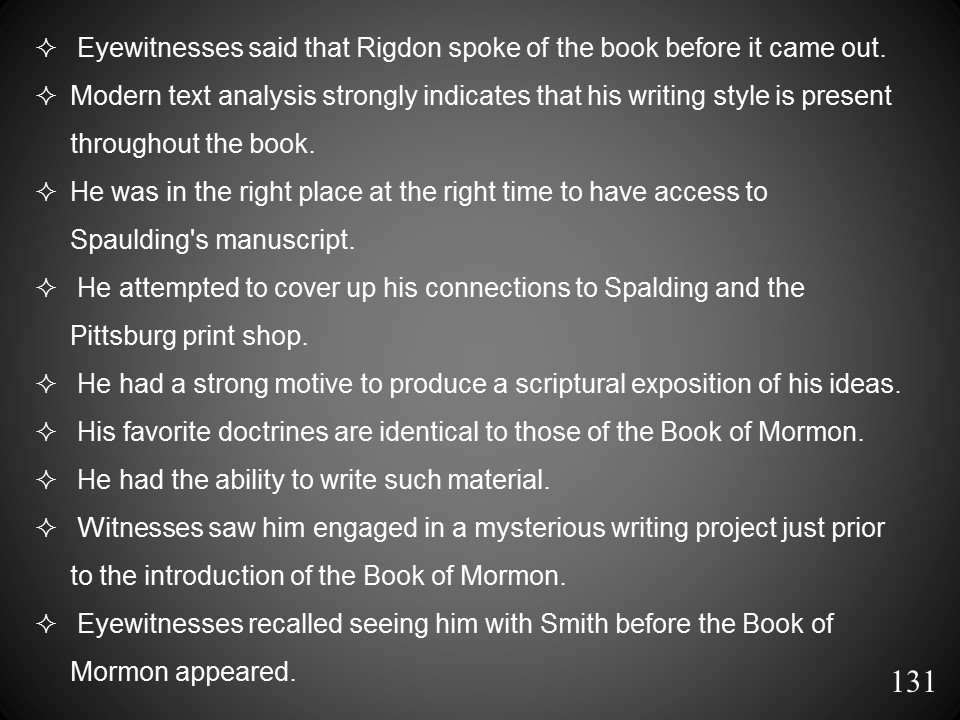Episode 03
Episode 03 – Slide 8
Rigdon was named as likely author of the Book of Mormon on February 15, 1831:
“Rigdon was formerly a disciple of Campbell’s and who it is said was sent out to make proselytes, but is probable he thought he should find it more advantageous to operate on his own capital, and therefore wrote, as it is believed the Book of Mormon, and commenced his pilgrimage in the town of Kirtland, which was represented as one of the extreme points of the Holy Land.”
Anon. (1831). Mormonism – or Grand Pugilistic Debate. Cleveland Advertiser, February 15, 1831.
Possible reasons Rigdon was suspected early on of being the author:
1. His apparent foreknowledge of the book prior to March, 1830.
2. His theology appeared throughout the book.
3. He almost immediately advanced to a position co-equal to Smith after his baptism.
Evidence of his apparent foreknowledge of the book:
Said Darwin Atwater, a Patriarch in the Disciples Church at Mantua:
“That he [Rigdon] knew before of the coming of The Book of Mormon is to me certain, from what he said the first of his visits to my father’s some years before [at about the close of January 1827]”. “He gave a wonderful description of the mounds and other antiquities found in some parts of America, and said they must have been made by the aborigines. He said there was a book to be published containing an account of those things. He spoke of these in his eloquent, enthusiastic style as being a thing most extraordinary.”
http://sidneyrigdon.com/wht/1891WhE3.htm#pg205
http://knowledgerush.com/paginated_txt/tsotm10/tsotm10_s1_p87_pages.html
Dr. Storm Rosa, a well-known “botanic physician” of Ohio, said in, an 1841 letter to Rev. John Hall of Ashtabula:
“In the early part of the year 1830 I was in company with Sidney Rigdon, and rode with him on horseback for a few miles…. He remarked to me that it was time for a new religion to spring up; that mankind were all right and ready for it.”
http://sidneyrigdon.com/RigHist/RigHist2.htm
In a Jan 22, 1841 letter written to Walter Scott, Adamson Bentley said:
“I know that Sidney Rigdon told me that there was a book coming out, the manuscript of which had been found engraved on gold plates, as much as two years before the Mormon Book made its appearance, or had been heard of by me.”
http://solomonspalding.com/docs2/1914Shk1.htm#pg055b
http://lavazone2.com/dbroadhu/OH/evan1832.htm#000043
Thomas Clapp, a deacon in the church where Rigdon preached, confirmed Bentley’s statement:
“Elder Adamson Bentley told me that as he was one day riding with Sidney Rigdon and conversing upon the Bible, Mr. Rigdon told him that another book of equal authority with the bible, as well authenticated and as ancient, which would give an account of the history of the Indian tribes on this continent, with many other things of great importance to the world, would soon be published. This was before Mormonism was ever heard of in Ohio, and when it appeared, the avidity with which Rigdon received it convinced him that if Rigdon was not the author of it he was at least acquainted with the whole matter some time before it was published to the world.”
http://thedigitalvoice.com/enigma/wrw/1977DavD.htm#pg116b
The Reverend Samuel F. Whitney said:
“I heard Sidney Rigdon preach in Squire Sawyers’ orchard in 1827 or ’28. He said how desirable it would be to know who built the forts and mounds about the country. Soon it would all be revealed. He undoubtedly referred to the “Book of Mormon” which was published in 1830.”
http://sidneyrigdon.com/dbroadhu/CA/natruths.htm#010088-3b2
John Rudolph stated:
“For two years before The Book of Mormon appeared Rigdon’s sermons were full of declarations and prophecies that the age of miracles would be restored, and more complete revelations, than those in the Bible, would be given. When The Book of Mormon appeared, all who heard him were satisfied that he referred to it.” (Cowdery et al., 2005, p. 313).
Reuben P. Harmon said:
“My parents came to Ohio from Vermont in 1815. I resided in Kirtland when the Mormons first arrived. I was personally acquainted with Rigdon….I have heard [him] several times say in his sermons that before long the Indian mounds and forts about there would all be explained. He caused a row of log houses to be built on Isaac Morley’s farm, and established a Communistic Society before Mormonism was heard of. I heard Rigdon preach his first sermon at Kirtland Flats, and after he embraced Mormonism. He said that he had been preaching wrong doctrine and asked their forgiveness…” (Cowdrey et al., 2005, p. 313).
Smith-as-Sole-Author advocates explain the above statements as information Rigdon acquired from local newspaper accounts prior to publication of The Book of Mormon. Newspapers published at Rochester, NY, on August 31 and Sept 5, 1829, indicated that Smith’s activities were known in Palmyra and vicinity as early as the fall of 1827. (Van Wagoner,1994, pages 55-56). A November 16, 1830 article in the Painesville Telegraph entitled “The Golden Bible” reported:
“Some two or three years since, an account was given in the papers, of a book purporting to contain new revelations from Heaven, having been dug out of the ground in Manchester, Ontario County, NY.”
Episode 03 – Slide 10
Though raised Baptist, Rigdon was not baptized until age 24. A condition for baptism was a profession of conversion. Rigdon complied. Rev. Samuel Williams reported in “Mormonism Exposed” that Rigdon’s pastor David Phillips doubted his sincerity:
“here was so much miracle that about his conversion and so much parade about his profession that the pious and discerning pastor entertained serious doubts at the time in regard to the genuineness of the work.”
Rigdon was later driven from his position as minister in the First Baptist Church of Pittsburgh. Of that event, Rev. Winters reported:
“When Holland Sumner dealt with Rigdon for his bad teachings, and said to him, ‘Brother Rigdon, you never got into a Baptist church without relating your Christian experiences,’ Rigdon replied, ‘When I joined the church at Peters Creek, I knew I would not be admitted without an experience, so I made up one to suit the purpose.’ * * * This I have just copied,” says Dr. Winter, “from an old memorandum as taken from Sumner’s himself.”
The expedient use of deception was a recurrent theme in Rigdon’s religious life.
Rigdon consistently denied any role in the authorship of the Book of Mormon.
Episode 03 – Slide 13
Said Darwin Atwater, a Patriarch in the Disciples Church at Mantua:
“That he [Rigdon] knew before of the coming of The Book of Mormon is to me certain, from what he said the first of his visits to my father’s some years before [at about the close of January 1827].” “He gave a wonderful description of the mounds and other antiquities found in some parts of America, and said they must have been made by the aborigines. He said there was a book to be published containing an account of those things. He spoke of these in his eloquent, enthusiastic style as being a thing most extraordinary.”
http://sidneyrigdon.com/wht/1891WhE3.htm#pg205
http://knowledgerush.com/paginated_txt/tsotm10/tsotm10_s1_p87_pages.html
Dr. Storm Rosa, a well-known “botanic physician” of Ohio, said in, an 1841 letter to Rev. John Hall of Ashtabula:
“In the early part of the year 1830 I was in company with Sidney Rigdon, and rode with him on horseback for a few miles…. He remarked to me that it was time for a new religion to spring up; that mankind were all right and ready for it.”
http://sidneyrigdon.com/RigHist/RigHist2.htm
In a Jan 22, 1841 letter written to Walter Scott, Adamson Bentley said:
“I know that Sidney Rigdon told me that there was a book coming out, the manuscript of which had been found engraved on gold plates, as much as two years before the Mormon Book made its appearance, or had been heard of by me.”
http://solomonspalding.com/docs2/1914Shk1.htm#pg055b
http://lavazone2.com/dbroadhu/OH/evan1832.htm#000043
Thomas Clapp, a deacon in the church where Rigdon preached, confirmed Bentley’s statement:
“Elder Adamson Bentley told me that as he was one day riding with Sidney Rigdon and conversing upon the Bible, Mr. Rigdon told him that another book of equal authority with the bible, as well authenticated and as ancient, which would give an account of the history of the Indian tribes on this continent, with many other things of great importance to the world, would soon be published. This was before Mormonism was ever heard of in Ohio, and when it appeared, the avidity with which Rigdon received it convinced him that if Rigdon was not the author of it he was at least acquainted with the whole matter some time before it was published to the world.”
http://thedigitalvoice.com/enigma/wrw/1977DavD.htm#pg116b
The Reverend Samuel F. Whitney said:
“I heard Sidney Rigdon preach in Squire Sawyers’ orchard in 1827 or ’28. He said how desirable it would be to know who built the forts and mounds about the country. Soon it would all be revealed. He undoubtedly referred to the “Book of Mormon” which was published in 1830.”
http://sidneyrigdon.com/dbroadhu/CA/natruths.htm#010088-3b2
John Rudolph stated:
“For two years before The Book of Mormon appeared Rigdon’s sermons were full of declarations and prophecies that the age of miracles would be restored, and more complete revelations, than those in the Bible, would be given. When The Book of Mormon appeared, all who heard him were satisfied that he referred to it.” (Cowdery et al., 2005, p. 313).
Reuben P. Harmon said:
“My parents came to Ohio from Vermont in 1815. I resided in Kirtland when the Mormons first arrived. I was personally acquainted with Rigdon….I have heard [him] several times say in his sermons that before long the Indian mounds and forts about there would all be explained. He caused a row of log houses to be built on Isaac Morley’s farm, and established a Communistic Society before Mormonism was heard of. I heard Rigdon preach his first sermon at Kirtland Flats, and after he embraced Mormonism. He said that he had been preaching wrong doctrine and asked their forgiveness…” (Cowdrey et al., 2005, p. 313).
Episode 03 – Slide 14
Reuben Harmon:
“I was personally acquainted with Rigdon….I have heard [him] several times say in his sermons that before long the Indian mounds and forts about there would all be explained. He…established a Communistic Society before Mormonism was heard of.”
Episode 03 – Slide 15
http://lavazone2.com/dbroadhu/OH/evan1832.htm#000043
Thomas Clapp, a deacon in the church where Rigdon preached, confirmed Bentley’s statement:
“Elder Adamson Bentley told me that as he was one day riding with Sidney Rigdon and conversing upon the Bible, Mr. Rigdon told him that another book of equal authority with the bible, as well authenticated and as ancient, which would give an account of the history of the Indian tribes on this continent, with many other things of great importance to the world, would soon be published.”
Episode 03 – Slide 28
Mormonism Unvailed (1834):
“We have been credibly informed that he [Rigdon] was on terms of intimacy with Lambdin, being seen frequently in his shop. Rigdon resided in Pittsburgh about three years, and during the whole of that time, as he has since frequently asserted, abandoned preaching and all other employment, for the purpose of studying the bible…We therefore, must hold out Sidney Rigdon to the world as being the original “author and proprietor” of the whole Mormon conspiracy, until further light is elicited upon the lost writings of Solomon Spalding. ”
Nov. 12, 1878 Samuel Williams Letter Theodore Albert Schroeder Papers: Box 2, folder 1., Wisconsin State Historical Society Library, Madison, WI Partial Catalog: Theodore A. Schroeder Papers.
“Rigdon was in Pittsburgh in 1824 with Mr. Brooks had a tannery for a short time. They did not succeed and Rigdon was intimate with Engles and all of the old residenters knew of the printing office in which he was forman. And Mr. Patterson wished to be understood that Engles had the care of various Manuscripts that came to the office, not that Engles handed to Rigdon other Manuscripts. Mr. P. simply certifies that he supposed that Engles had returned it to Mr. Spaulding.”
Episode 03 – Slide 29
For five years after publication of Howe’s Mormonism Unvailed on Nov. 28, 1834, Rigdon and Smith provided no written rebuttal to that book’s central thesis, i.e. that Rigdon had modified Spalding’s work to create The Book of Mormon. On May 27, 1839, however, Rigdon finally wrote a denial, accompanied by a vicious attack upon Matilda Spalding Davison (Solomon Spalding’s widow) after she had provided a statement to the Boston Recorder (April 19, 1839) implicating Rigdon in the fabrication of The Book of Mormon.
Here is the complete statement from Matilda: “ORIGIN OF THE “BOOK OF MORMON”, OR “GOLDEN BIBLE”
As this book has excited much attention, and has been put [forth] by a certain new sect, in the place of the sacred Scriptures, I deem it a duty which I owe to the public, to state what I know touching its origin. That its claims to a divine origin are wholly unfounded needs no proof to a mind unperverted by the grossest delusions. That any sane person should rank it higher than any other merely human composition is a matter of the greatest astonishment; yet it is received as divine by some who dwell in enlightened New England, and even by those who have sustained the character of devoted Christians. Learning recently that Mormonism had found its way into a church in Massachusetts, and has impregnated some of its members with some of its gross delusions, so that excommunication has been necessary, I am determined to delay no longer doing what I can to strip the mask from this monster of sin, and to lay open this pit of abomination.
Rev. Solomon Spaulding, to whom I was united in marriage in early life, was a graduate of Dartmouth College, and was distinguished for a lively imagination and a great fondness for history. At the time of our marriage, he resided in Cherry Valley, N.Y. From this place we removed to New Salem, Ashtabula county, Ohio; sometimes called Conneaut, as it is situated upon Conneaut Creek. Shortly after our removal to this place, his health sunk, and he was laid aside from active labors. In the town of New Salem, there are numerous mounds and forts, supposed by many to be the dilapidated dwellings and fortifications of a race now extinct. These ancient relics arrest the attention of the new settlers, and become objects of research for the curious. Numerous implements were found and other articles evincing great skill in the arts. Mr. Spaulding being an educated man and passionately fond of history, took a lively interest in these developments of antiquity; and in order to beguile the hours of retirement and furnish employment for his lively imagination, he conceived the idea of giving an historical sketch of this long lost race. Their extreme antiquity of course would lead him to write in the most ancient style, and as the Old Testament is the most ancient book in the world, he imitated its style as nearly as possible. His sole object in writing this historical romance was to amuse himself and his neighbors. This was about the year 1812. Hull’s surrender at Detroit, occurred near the same time, and I recollect the date well from that circumstance. As he progressed in his narrative, the neighbors would come in from time to time to hear portions read, and a great interest in the work was excited among them. It claimed to have been written by one of the lost nation, and to have been recovered from the earth, and, assumed the title of “Manuscript Found.” The neighbors would often inquire how Mr. S. progressed in deciphering “the manuscript”, and when he had sufficient portion prepared he would inform them, and they would assemble to hear it read. He was enabled from his acquaintance with the classics and ancient history, to introduce many singular names, which were particularly noticed by the people and could be easily recognized by them. Mr. Solomon Spaulding had a brother, Mr. John Spaulding residing in the place at the time, who was perfectly familiar with this work and repeatedly heard the whole of it read.
From New Salem we removed to Pittsburgh, Pa. Here Mr. Spaulding found an acquaintance and friend, in the person of Mr. Patterson, an editor of a newspaper. He exhibited his manuscript to Mr. P. who was very much pleased with it, and borrowed it for perusal. He retained it a long time and informed Mr. S. that if he would make out a title page and preface, he would publish it and it might be a source of profit. This Mr. S. refused to do for reasons which I cannot now state. — Sidney Rigdon,* who has figured so largely in the history of the Mormons, was at this time connected with the printing office of Mr. Patterson, as is well known in that region, and as Rigdon himself has frequently stated. Here he had ample opportunity to become acquainted with Mr. Spaulding’s manuscript and to copy it if he chose. It was a matter of notoriety and interest to all who were connected with the printing establishment. At length the manuscript was returned to its author, and soon after we removed to Amity, Washington county, Pa., where Mr. S. deceased in 1816. The manuscript then fell into my hands and was carefully preserved. It has frequently been examined by my daughter, Mrs. McKenstry, of Monson, Mass., with whom I now reside, and by other friends. — After the “Book of Mormon” came out, a copy of it was taken to New Salem, the place of Mr. Spaulding’s former residence and the very place where the “Manuscript Found” was written. A woman preacher appointed a meeting there, and in the meeting read and repeated copious extracts from the “Book of Mormon.” The historical part was immediately recognized by all the older inhabitants, as the identical work of Mr. S., in which they had been so deeply interested years before. Mr. John Spaulding was present, who is an eminently pious man, and recognized perfectly the work of his brother. He was amazed and afflicted, that it should have been perverted to so wicked a purpose. His grief found vent in a flood of tears, and he arose on the spot, and expressed to the meeting his deep sorrow and regret, that the writings of his sainted brother should be used for a purpose so vile and shocking. The excitement in New Salem became so great, that the inhabitants had a meeting and deputed Dr. Philastus Hurlbut, one of their number to repair to this place and to obtain from me the original manuscript of Mr. Spaulding, for the purpose of comparing it with the Mormon Bible, to satisfy their own minds, and to prevent their friends from embracing an error so delusive. This was in the year 1834. Dr. Hurlbut brought with him an introduction and request for the manuscript, signed by Messrs. Henry Lake, Aaron Wright and others, with all whom I was acquainted, as they were my neighbors when I resided in New Salem.
I am sure that nothing could grieve my husband more, were he living, than the use which has been made of his work. The air of antiquity which was thrown about the composition, doubtless suggested the idea of converting it to the purposes of delusion. Thus an historical romance, with the addition of a few pious expressions and extracts from the sacred Scriptures, has been constructed into a new Bible, and palmed off upon a company of poor deluded fanatics as divine. I have given the previous brief narration, that this work of deep deception and wickedness may be searched to the foundation, and its author exposed to the contempt and execration he so justly deserves.
MATILDA DAVIDSON.
http://solomonspalding.com/docs1/1897spld.htm
Episode 03 – Slide 30
The statement was obtained “from two highly respectable clergymen, the Rev. Mr. Austin and the Rev. A. Ely, D.D., residing in Monson, Mass”.
http://solomonspalding.com/docs1/1842ClkB.htm#pg216a
In the Boston Recorder (April 8, 1839), John Storrs reported:
“Having heard incidentally that there was a lady in Monson, Ma., whose husband now dead was the author of the book, I requested in a note, Rev. D. R. Austin, Principal of Monson Academy, to obtain of her, for my benefit, and to be used as I should think proper, a certified account of its origin with her husband; for the character of which lady I wished the venerable Dr. Ely and himself to avouch. The following highly satisfactory document came in reply.”
http://sidneyrigdon.com/dbroadhu/NE/miscne01.htm#041939
In Gleanings by the Way, Storrs explained to John Clark that Matilda did not write the statement:
“I requested in a note, Rev. D. R. Austin, Principal of Monson Academy, to obtain of her, for my benefit, and to be used as I should think proper, a certified account of its origin with her husband.”
Episode 03 – Slide 31
“Here [in Pittsburgh] Mr. Spaulding found a friend and acquaintance in the person of Mr. Patterson, who was very much pleased with it, and borrowed it for perusal. He retained it for a long time, and informed Mr. Spaulding that, if he would make out a title-page and preface, he would publish it, as it might be a source of profit. This Mr. Spaulding refused to do. Sidney Rigdon, who has figured so largely in the history of the Mormons, was at that time connected with the printing office of Mr. Patterson, as is well known in that region, and, as Rigdon himself has frequently stated, became acquainted with Mr. Spaulding’s manuscript and copied it. It was a matter of notoriety and interest to all connected with the printing establishment. At length the manuscript was returned to its author, and soon after we removed to Amity where Mr. Spaulding deceased in 1816. The manuscript then fell into my hands, and was carefully preserved.”
http://home1.gte.net/dbroadhu/RESTOR/Lib/New1839a.htm
Rigdon’s denial letter is available at:
http://solomonspalding.com/docs2/Rob1905a.htm
Episode 03 – Slide 33
Quincy Whig
[Bartlett & Sullivan]. Quincy, Illinois, Sat., June 8, 1839.; [Vol. 2 – No. 6].
COMMUNICATIONS.
COMMERCE, May 27th, 1839.
MESSRS. BARTLETT & SULLIVAN:
In your paper of the 18th inst. I see a letter signed by somebody, calling herself Matilda Davidson, pretending to give the origin of Mormonism, as she is pleased to call it, by relating a moonshine story about a certain Solomon Spalding, a creature with the knowledge of whose earthly existence, I am entirely indebted to this production; for surely, until Doctor Philastus Hurlburt informed me that such a being lived, at some former period, I had not the most distant knowledge of his existence; and all I now know about his character is, the opinion I form from what is attributed to his wife, in obtruding my name upon the public in the manner in which she is said to have done it, by trying to make the public believe, that I had knowledge of the ignorant, and according to her own testimony, the lying scribblings of her deceased husband; for if her testimony is to be credited, her pious husband, in his life time, wrote a bundle of lies, for the righteous purpose of getting money. How many lies he had told for the same purpose while he was preaching, she has not so kindly informed us; but we are at liberty to draw our own conclusions; for he that would write lies to get money, would also preach lies for the same object. This being the only information which I have, or ever had, of this said Rev. Solomon Spalding, I, of necessity have but a very light opinion of him as a gentleman, a scholar, or a man of piety; for had he been either, he certainly would have taught his pious wife not to lie, nor unite herself with adulterers, liars, and the basest of mankind.
It is only necessary to say, in relation to the whole story about Spalding’s writings being in the hands of Mr. Patterson, who was in Pittsburg, and who is said to have kept a printing office, and my saying that I was concerned in said office, &c. &c. is the most base of lies, without even the shadow of truth; there was no man by the name of Patterson during my residence at Pittsburgh who had a printing office; what might have been before I lived there I know not. Mr. Robert Patterson, I was told, had owned a printing office before I lived in that city, but had been unfortunate in business, and failed before my residence there. This Mr. Patterson, who was a Presbyterian preacher, I had a very slight acquaintance with during my residence in Pittsburgh. He was then acting under an agency, in the book and stationery business, and was the owner of no property of any kind, printing office, or any thing else, during the time I resided in the city.
If I were to say that I ever heard of the Rev. Solomon Spalding, and his hopeful wife, until Dr. P. Hurlburt wrote his lie about me, I should be a liar like unto themselves. Why was not the testimony of Mr. Patterson obtained to give force to this shameful tale of lies; the only reason is, that he was not a fit tool for them to work with; he would not lie for them; for if he were called on, he would testify to what I have here said.
Let me here, gentlemen, give a history of this Dr. P. Hulburt and his associates, who aided in getting up and propagating this batch of lies.
I have seen and heard, at one time and another, by the persecutors and haters of the truth, a great deal said about the eminent physician, Doctor Hulburt. I never thought the matter worthy of notice, nor probably ever should, had it not made its appearance in your paper, or some one of equal respectability. And I believe, gentlemen, had you have known the whole history of this budget of lies, it would never have found a place in your paper. —
But to my history.
This said Doctor was never a physician, at any time, nor anything else, but a base ruffian. He was the seventh son, and his parents called him Doctor; it was his name, and not the title of his profession.
He once belonged to the Methodist Church and was excluded for immoralities. He afterwards imposed himself on the Church of “Latter Day Saints,” and was excluded for using obscene language to a young lady, a member of said church, who resented his insult with indignation, which became both her character and profession.
After his exclusion, he swore — for he was vilely profane — that he would have revenge, and commenced his work. He soon found assistance, a pious old deacon of the Campbellite church, by the name of Onis [sic] Clapp, and his two sons, Thomas J. Clapp and Matthew S. Clapp, both Campbellite preachers, abetted and assisted by another Campbellite preacher by the name of Adamson Bentley. Hulburt went to work, catering lies for the company. Before Hulburt got through, his conduct became so scandalous, that the company utterly refused to let his name go out with the lies which he had collected, and he and his associates had made; and they substituted the name of E. D. Howe. The change, however, was not much better. There were scandalous immoralities about the Howe family of so black a character, that they had nothing to lose, and became good tools for this holy company to work with. A man of character would never have put his name to a work which Hulburt was concerned in. But while Hulburt was busily employed in the service of the company, old deacon Clapp was employed in taking care of his wife. How many others of the company aided in this business must be left to futurity to disclose. At a certain time, Hulburt being out till a late hour in the night, returned to his house, and in going to his bed room where his wife was. Behold and Lo! there was the pious old deacon, either in the bed with his wife, or at the side of it. He had a five dollar bank note in his hand, and his dress was rather light, to suit the Doctor’s taste; for he was not quite as well off as was Aaron, when he offered sacrifice; not even having on a pair of “linen breeches.” Hulburt laid hold of him and called for help, which soon came to his assistance. The pious old deacon was arraigned before a justice of the peace, and was on the eve of being bound over for his appearance to the county court, when to put an end to the evils which might result from his pious care of Mrs. Hulburt, he kindly offered a yoke of oxen and a hundred dollars; this was accepted. Hulburt took his wife and left the country forthwith, and the pious old deacon and his sons and the good Mr. Bentley, are left to wear out the shame of their great effort to destroy the character of innocent men, whom they never dare meet in argument. The tale in your paper is one hatched up by this gang before the time of their explosion.
It has always been a matter of no ordinary satisfaction to me, to know that my enemies have no better weapon to use against me, or the cause in which I am engaged, than lies; for if they had any better, they would certainly use them. I must confess, however, that there is some constancy in our persecutors; for, as truth never can destroy truth, it would be in vain for our persecutors to use truth against us, for this would only build us up; this they seem to know, and lay hold of the only available means they have, which are lies. And this, indeed, is the only weapon which can be or ever has been used against the truth. As our persecutors are endeavoring to stop the progress of truth, I must confess that they act with a degree of consistency in the choice of the means, namely, lies — but if truth would do it, they would surely not have recourse to lies.
In order to give character to their lies, they dress them up with a great deal of piety; for a pious lie, you know, has a good deal more influence with an ignorant people than a profane one. Hence, their lies come signed by the pious wife, of a pious deceased priest. However, his last act of piety seems to have been to write a bundle of lies, themselves being witnesses; but then his great piety sanctifies them, and lies become holy things in the hands of such excessive piety, particularly when they are graced with a few Reverends; but the days have gone by, when people are to be deceived by these false glossings of Rev’d sanctions; the intelligent part of the communities, of all parts of the country, know that Rev’ds are not more notorious for truth than their neighbors.
The only reason why I am assailed by lies, is that my opposers dare not adventure on argument, knowing that if they do, they fall. They try, therefore to keep the public from investigating, by publishing and circulating falsehoods. This I consider a high encomium on both myself and the cause I defend.
Respectfully,
S. RIGDON.
Episode 03 – Slide 37
Quincy Whig
[Bartlett & Sullivan]. Quincy, Illinois, Sat., June 8, 1839. [Vol. 2 – No. 6].
COMMUNICATIONS.
COMMERCE, May 27th, 1839.
MESSRS. BARTLETT & SULLIVAN:
In your paper of the 18th inst. I see a letter signed by somebody, calling herself Matilda Davidson, pretending to give the origin of Mormonism, as she is pleased to call it, by relating a moonshine story about a certain Solomon Spalding, a creature with the knowledge of whose earthly existence, I am entirely indebted to this production; for surely, until Doctor Philastus Hurlbut informed me that such a being lived, at some former period, I had not the most distant knowledge of his existence; and all I now know about his character is, the opinion I form from what is attributed to his wife, in obtruding my name upon the public in the manner in which she is said to have done it, by trying to make the public believe, that I had knowledge of the ignorant, and according to her own testimony, the lying scribblings of her deceased husband; for if her testimony is to be credited, her pious husband, in his life time, wrote a bundle of lies, for the righteous purpose of getting money. How many lies he had told for the same purpose while he was preaching, she has not so kindly informed us; but we are at liberty to draw our own conclusions; for he that would write lies to get money, would also preach lies for the same object. This being the only information which I have, or ever had, of this said Rev. Solomon Spalding, I, of necessity have but a very light opinion of him as a gentleman, a scholar, or a man of piety; for had he been either, he certainly would have taught his pious wife not to lie, nor unite herself with adulterers, liars, and the basest of mankind.
It is only necessary to say, in relation to the whole story about Spalding’s writings being in the hands of Mr. Patterson, who was in Pittsburg, and who is said to have kept a printing office, and my saying that I was concerned in said office, &c. &c. is the most base of lies, without even the shadow of truth; there was no man by the name of Patterson during my residence at Pittsburgh who had a printing office; what might have been before I lived there I know not. Mr. Robert Patterson, I was told, had owned a printing office before I lived in that city, but had been unfortunate in business, and failed before my residence there. This Mr. Patterson, who was a Presbyterian preacher, I had a very slight acquaintance with during my residence in Pittsburgh. He was then acting under an agency, in the book and stationery business, and was the owner of no property of any kind, printing office, or any thing else, during the time I resided in the city.
If I were to say that I ever heard of the Rev. Solomon Spalding, and his hopeful wife, until Dr. P. Hurlbut wrote his lie about me, I should be a liar like unto themselves. Why was not the testimony of Mr. Patterson obtained to give force to this shameful tale of lies; the only reason is, that he was not a fit tool for them to work with; he would not lie for them; for if he were called on, he would testify to what I have here said.
Let me here, gentlemen, give a history of this Dr. P. Hurlbut and his associates, who aided in getting up and propagating this batch of lies.
I have seen and heard, at one time and another, by the persecutors and haters of the truth, a great deal said about the eminent physician, Doctor Hurlbut. I never thought the matter worthy of notice, nor probably ever should, had it not made its appearance in your paper, or some one of equal respectability. And I believe, gentlemen, had you have known the whole history of this budget of lies, it would never have found a place in your paper. —
But to my history.
This said Doctor was never a physician, at any time, nor anything else, but a base ruffian. He was the seventh son, and his parents called him Doctor; it was his name, and not the title of his profession.
He once belonged to the Methodist Church and was excluded for immoralities. He afterwards imposed himself on the Church of “Latter Day Saints,” and was excluded for using obscene language to a young lady, a member of said church, who resented his insult with indignation, which became both her character and profession.
After his exclusion, he swore — for he was vilely profane — that he would have revenge, and commenced his work. He soon found assistance, a pious old deacon of the Campbellite church, by the name of Onis [sic] Clapp, and his two sons, Thomas J. Clapp and Matthew S. Clapp, both Campbellite preachers, abetted and assisted by another Campbellite preacher by the name of Adamson Bentley. Hurlbut went to work, catering lies for the company. Before Hurlbut got through, his conduct became so scandalous, that the company utterly refused to let his name go out with the lies which he had collected, and he and his associates had made; and they substituted the name of E. D. Howe. The change, however, was not much better. There were scandalous immoralities about the Howe family of so black a character, that they had nothing to lose, and became good tools for this holy company to work with. A man of character would never have put his name to a work which Hurlbut was concerned in. But while Hurlbut was busily employed in the service of the company, old deacon Clapp was employed in taking care of his wife. How many others of the company aided in this business must be left to futurity to disclose. At a certain time, Hurlbut being out till a late hour in the night, returned to his house, and in going to his bed room where his wife was. Behold and Lo! there was the pious old deacon, either in the bed with his wife, or at the side of it. He had a five dollar bank note in his hand, and his dress was rather light, to suit the Doctor’s taste; for he was not quite as well off as was Aaron, when he offered sacrifice; not even having on a pair of “linen breeches.” Hurlbut laid hold of him and called for help, which soon came to his assistance. The pious old deacon was arraigned before a justice of the peace, and was on the eve of being bound over for his appearance to the county court, when to put an end to the evils which might result from his pious care of Mrs. Hurlbut, he kindly offered a yoke of oxen and a hundred dollars; this was accepted. Hurlbut took his wife and left the country forthwith, and the pious old deacon and his sons and the good Mr. Bentley, are left to wear out the shame of their great effort to destroy the character of innocent men, whom they never dare meet in argument. The tale in your paper is one hatched up by this gang before the time of their explosion.
It has always been a matter of no ordinary satisfaction to me, to know that my enemies have no better weapon to use against me, or the cause in which I am engaged, than lies; for if they had any better, they would certainly use them. I must confess, however, that there is some constancy in our persecutors; for, as truth never can destroy truth, it would be in vain for our persecutors to use truth against us, for this would only build us up; this they seem to know, and lay hold of the only available means they have, which are lies. And this, indeed, is the only weapon which can be or ever has been used against the truth. As our persecutors are endeavoring to stop the progress of truth, I must confess that they act with a degree of consistency in the choice of the means, namely, lies — but if truth would do it, they would surely not have recourse to lies.
In order to give character to their lies, they dress them up with a great deal of piety; for a pious lie, you know, has a good deal more influence with an ignorant people than a profane one. Hence, their lies come signed by the pious wife, of a pious deceased priest. However, his last act of piety seems to have been to write a bundle of lies, themselves being witnesses; but then his great piety sanctifies them, and lies become holy things in the hands of such excessive piety, particularly when they are graced with a few Reverends; but the days have gone by, when people are to be deceived by these false glossings of Rev’d sanctions; the intelligent part of the communities, of all parts of the country, know that Rev’ds are not more notorious for truth than their neighbors.
The only reason why I am assailed by lies, is that my opposers dare not adventure on argument, knowing that if they do, they fall. They try, therefore to keep the public from investigating, by publishing and circulating falsehoods. This I consider a high encomium on both myself and the cause I defend.
Respectfully,
S. RIGDON.
Episode 03 – Slide 41
Dec. 14, 1878 Samuel Williams Letter
Theodore Albert Schroeder Papers: Box 2, folder 1. Wisconsin State Historical Society Library, Madison, WI
Samuel Williams
Dec. 14, 1878
Castle Shannon
Allegheny Co Pa
Dec 14th – 78
Dear Sir,
I have just recd. yours of the 27th ult through Mr. Craig, and answer your questions as well as I can in detail. Mr. Patterson of the Presn Banner says Engles was his Father’s cousin and was in his employ during the term of his partnership with Lambden, and was entrusted with the management of the printing office. I am not certain about Lambden being a Portrait painter. I distinctly recollect of a Mr. Lambden a Painter being in Pittsburgh when I came to the city in 1827 and somehow I received the impression that it was the same man. They may not have been the same. Mr. Craig has made a great mistake in regard to the death of Robert Patterson — he gave you the date of the death of his Father the Rev. Joseph Patterson. Robt Patterson was the Pastor of the Highlands Chh twenty years and all that time was engaged in the Book business on a small scale up at least to 1840 when his son and a Mr. Ingram succeeded him and he moved about six or seven miles out on the Washington road south of the city where he lived until 51 or 2 or about that time. I have been in his store a hundred times, had books or pamphlets on sale in his store, and was standing near him when he wrote that certificate in 1842. Besides I often met him on the street and preached once or twice for him in his church at Hilands. The date of his death is now certified by his son as you will see the by the scrap of paper with the pamphlet. The small chh to which he preached gave him but a small support and he was obliged to do something else for a living, as many others of us have to do. I was led to think 1842 was a misprint by Mr. Craig and without much thought gave you that date, 1832, but 1842 and not 32 is the correct date. Because when I came to recollect distinctly, I got the certificate when I was opposing John E. Page and I know he flourished in Pittsburgh in 1841-2, and all the other dates in the Pamphlet are correct for they were taken from the minutes of the Redstone Association and the old Church Book of the 1st Bap Chh. Mr. Patterson stated to me that Mr. Spaulding brought the Manuscript to the Office and of course it came under the charge of Engles, and at or about that time Engles spoke to Mr. Patterson about it. That time must have been 1814 or 15. All of the old men of our Church knew about Rigdon hanging about that Printing Office, and whether he spent his time there in copying it or concocting his schemes while
[Williams: Dec. 14, 1878][ 3 ] conversing with Engles and others, or at length procured the Manuscript by purchase or otherwise, makes not the smallest difference. If it is true that Mrs. Spaulding had the Manuscript returned to her, then unless Mr. Spaulding had duplicate copies leaving one in the office, Rigdon must have copied it. The identification of the Mormon Bible with the Novel of Mr Spaulding I consider complete and placed beyond cavil. Now I wish to write about J. Patterson. He was Mr. Joseph Patterson who I suppose was in with his brother Robert before Lambden came into the firm. He married a very wealthy lady, built a long block of buildings on one of the principal business streets 6th producing high rents, retired from active business, and finally moved to Philadelphia to enjoy his fortune. I knew him well. I have no doubt you are right in the matter of Mrs. Spaulding’s statement concerning the interest Jos. P. had taken in the Manuscript. But Mr. Spaulding not being able to furnish the money for its publication — there it remained. I have never supposed that Rigdon ever saw Mr. Spaulding for at that time he had not as yet come on the stage, but finding such a document there shown to him by Engles in 1822 or 3. But I do not think he ever wished Patterson to publish it, thinking he might turn it to account in making a fortune. And suppose the Novel was returned to Mrs. Spaulding — it being a strange production, Engles might during his leisure hours have copied it with the intention of making something out of it and perhaps not being able to publish it, sold it to Rigdon. Any one of these Lambden, Engles, Joseph Patterson, or Rigdon might have taken a copy. I think Rigdon had his plan of a community formed, { indeed the old members told me that when in Pittsburgh he often broached the subject to them of a common-stock system as he then called it } before he met Joe Smith, and at first expected to use him as a tool to carry out his plans. So that it may be that Rigdon had a little community begun at Kirtland before he met Joe Smith. But I remember well the report that Parley Pratt the tin pedlar told Rigdon of Smith and was the means of bringing them together, and I suppose it was 1829 or ’30. Another thing I learned that about the time they published the first edition of the Mormon Bible they established a Bank at Kirtland without a basis issued notes, and the Elders put them into circulation. I saw one of the notes. I hope you will persevere and collect all of the facts and publish an authentic history of that huge imposture. You will see by my pamphlet that you can get nowhere else the first facts in the history. I feel thankful that I can help a mite toward the object. I was sick for three or four weeks but have recovered. If I can aid you any further I shall be glad to do it. Judge Cobb.
Very respectfully,
S. Williams.
Episode 03 – Slide 44
Isaac Craig’s letter of Oct. 14, 1882:
“Rigdon had a small tannery on Penn street, near Hand, for the manufacture of book-binders sheep-skins, and supplying these to the office brought him in contact with [Silas] Engles. This impression I obtained from John Sandersen, an old time butcher, who sold sheep pelts to Rigdon.”
http://solomonspalding.com/docs/Eich1879.htm#1882a
Letter to the Editor of the Commercial Gazette (Feb 15, 1879):
“So far back as 1822 the firm of Patterson & Lambdin, (a shade of doubt about the last name of the firm) did business as Publishers, Bookbinders and Booksellers, at the southeast corner of the Diamond and Market street. At the same time Sidney Rigdon, tanner and currier, had his tan-yard and shop on Penn street, on the lot running from Penn Avenue to Allegheny above Ninth street.”
http://sidneyrigdon.com/dbroadhu/PA/penn1860.htm#021779
William Whitsitt in “Sidney Rigdon, The Real Founder of Mormonism” (1891) [p. 152-53]:
“…the question that pressed most heavily was that regarding the support of Bishop Rigdon, He was good for nothing in the line of handicraft; having been brought up at the most slipshod style of farming, he was not sufficiently educated to take a hand in the school even if a place had been open there, Nevertheless his situation was somewhat relieved by the sale to James (Means) on the 28th of June 1823, of the share of the paternal estate in St. Clair township that fell to his portion (Patterson, p.9), and there was a brief season of respite that could be employed in looking for a situation, After due consideration he decided to resort to a tannery. This point is established on the authority of Joseph Smith, who must have been in possession of definite information. In his biography of Rigdon, which there is reason to suspect was based upon a brief inquiry and investigation at first hands, Mr. Smith declares: “Having retired from the ministry, Mr. Rigdon engaged as a day laborer in a tannery, which employment he followed for two years, after which he removed to Bainbridge (township), Geauga county, Ohio” (Tullidge, p. 102). This view is confirmed by the authority of Patterson (p. 8); by the testimony of an eye witness in the person of Mrs. Eichbaum (Patterson, p. 11) and by Rigdon’s family, who are uniform in the denial that he was ever at any time employed in a printing-office (Patterson, p. 9). A still further indication of the correctness of it appears in the circumstance that when on the 25th of April 1834, the prophet was dividing out such property as he had been enabled to lay his hands upon in the village of Kirtland, the tannery was accorded to Sidney. Following are the exact words of the revelation in question: “Let my servant Pelagoram (Sidney Rigdon) have appointed unto him the place where he now resides, and the lot of Tahhanes (the tannery) for his stewardship, for his support while he is laboring in my vineyard, even as I will when I shall command him (D&C 104:20). Sidney being acquainted with the art of tanning, was an appropriate person to whose keeping and stewardship this establishment might be safely entrusted. In the face of proofs so strong as these that have just been supplied to the effect that Sidney’s handicraft in Pittsburgh was that of a tanner, it would under average circumstances hardly be considered important to give attention to any other representation….”
http://sidneyrigdon.com/features/tannery1.htm
Rigdon’s own autobiography (written in the 3rd person) in which he describes his feelings of being looked down upon in his profession as a tanner:
“Having now retired from the ministry [after Aug 1824], and having no way by which to sustain his family, besides his own industry, he was necessitated to find other employment in order to provide for his maintenance, and for this purpose he engaged in the humble capacity of a journeyman tanner, in that city, and followed his new employment, without murmuring, for two years — during which time he both saw and experienced, that, by resigning his pastorial vocations in that city, and engaging in the humble occupation of a tanner, he had lost many who once professed the greatest friendship, and who manifested the greatest love for his society — that when he was seen by them in the garb suited to the employment of a tanner, there was no longer that freedom, courtesy and friendship manifested — that many of his former friends became estranged and looked upon him with coolness and indifference — too obvious to admit of deception. To a well regulated and enlightened mind — to one who soars above the arbitrary and vain lines of distinction which pride or envy may draw, such conduct appears ridiculous — while at the same time it cannot but cause feelings of a peculiar nature, in those who, for their honesty and integrity of heart, have brought themselves into situations to be made the subjects of it. These things, however, did not affect his mind, so as to change his purpose. He had counted the cost before his separation, and had made his mind known to his wife, who cheerfully shared his sorrow and humiliation, believing that all things would work together for their good, being conscious that what they had done was for conscience sake, and in the fear of the Lord.”
Times & Seasons, vol IV, no. 12, May 15, 1843, ”History of Joseph Smith”, p. 193.
http://sidneyrigdon.com/Rigd1843.htm
Nov. 12, 1878 Samuel Williams Letter Theodore Albert Schroeder Papers: Box 2, folder 1. Wisconsin State Historical Society Library, Madison, WI Partial Catalog: Theodore A. Schroeder Papers.
“Rigdon was in Pittsburgh in 1824 with Mr. Brooks had a tannery for a short time. They did not succeed and Rigdon was intimate with Engles and all of the old residenters knew of the printing office in which he was forman. And Mr. Patterson wished to be understood that Engles had the care of various Manuscripts that came to the office, not that Engles handed to Rigdon other Manuscripts. Mr. P. simply certifies that he supposed that Engles had returned it to Mr. Spaulding.”
Episode 03 – Slide 46
Wayne Cowdrey, Howard A. David, and Arthur Vanick. 2005. Who Really Wrote The Book of Mormon? The Spalding Enigma, St. Louis. Page 172.
http://solomonspalding.com/Lib/Enig2000.h
In an affidavit, dated 21 July 1887, Lorenzo Saunders (a Smith family friend), made the following sworn statement sealed before Justice of the Peace Linus S. Parmalee of Reading, Michigan:
“I lived within one mile of Joseph Smith at the time said Joseph Smith claimed that he found the ‘tablets’ on which the ‘Book of Mormon’ was revealed. . . .
. . .[I]n March of 1827, on or about the 15th of said month, I went to the house of Joseph Smith for the purpose of getting some maple sugar to eat . . ..
[A]t a distance of 10 or 12 rods from the house there were five men that were engaged in talking, four of whom I knew, the fifth one was better dressed than the rest of those whom I was acquainted with.
I inquired of Harrison Smith, who the stranger was. He informed me his name was Sidney Rigdon with whom I afterwards became acquainted and found to be Sidney Rigdon. . . .”
Naked Truths About Mormonism Vol. I. No. 1. (January 1888) edited by Arthur B. Deming
COPYRIGHTED 1888, BY ARTHUR B. DEMING. Published Monthly by DEMING & CO., 856 Market St., Oakland.
Episode 03 – Slide 47
Excerpts from letter of the Rev Samuel Williams to James T. Cobb (Dec 14, 1878):
“Mr. Patterson stated to me that Mr. Spaulding brought the Manuscript to the Office and of course it came under the charge of Engles, and at or about that time Engles spoke to Mr. Patterson about it. That time must have been 1814 or 15. All of the old men of our Church knew about Rigdon hanging about that Printing Office, and whether he spent his time there in copying it or concocting his schemes while conversing with Engles and others, or at length procured the Manuscript by purchase or otherwise, makes not the smallest difference. If it is true that Mrs. Spaulding had the Manuscript returned to her, then unless Mr. Spaulding had duplicate copies leaving one in the office, Rigdon must have copied it.
The identification of the Mormon Bible with the Novel of Mr Spaulding I consider complete and placed beyond cavil.
Now I wish to write about J. Patterson. He was Mr. Joseph Patterson who I suppose was in with his brother Robert before Lambden came into the firm. He married a very wealthy lady, built a long block of buildings on one of the principal business streets 6th producing high rents, retired from active business, and finally moved to Philadelphia to enjoy his fortune. I knew him well.
I have no doubt you are right in the matter of Mrs. Spaulding’s statement concerning the interest Jos. P. had taken in the Manuscript. But Mr. Spaulding not being able to furnish the money for its publication — there it remained. I have never supposed that Rigdon ever saw Mr. Spaulding for at that time he had not as yet come on the stage, but finding such a document there shown to him by Engles in 1822 or 3. But I do not think he ever wished Patterson to publish it, thinking he might turn it to account in making a fortune. And suppose the Novel was returned to Mrs. Spaulding — it being a strange production, Engles might during his leisure hours have copied it with the intention of making something out of it and perhaps not being able to publish it, sold it to Rigdon. Any one of these Lambden, Engles, Joseph Patterson, or Rigdon might have taken a copy.
I think Rigdon had his plan of a community formed, {indeed the old members told me that when in Pittsburgh he often broached the subject to them of a common-stock system as he then called it} before he met Joe Smith, and at first expected to use him as a tool to carry out his plans. So that it may be that Rigdon had a little community begun at Kirtland before he met Joe Smith. But I remember well the report that Parley Pratt the tin pedlar told Rigdon of Smith and was the means of bringing them together, and I suppose it was 1829 or ’30. Another thing I learned that about the time they published the first edition of the Mormon Bible they established a Bank at Kirtland without a basis issued notes, and the Elders put them into circulation. I saw one of the notes.”
Episode 03 – Slide 50
Episode 03 – Slide 57
The Book of Mormon commands:
“…be baptized in my name, that ye may receive a remission of your sins, and be filled with the Holy Ghost.” 3 Nephi 30:22
Episode 03 – Slide 59
June 1833
Episode 03 – Slide 60
John Wycliff Rigdon, Sidney’s son, wrote of his father that:
“His parents would not let him have a candle to read by night; he therefore gathered hickory bark, there was plenty of it around the old farm. He used to get it & at night throw it on the old fire place & lay with his head toward the fire & read history till near morning, unless his parents got up & drove him to bed. In this way he became a great historian, the best I ever saw. He seemed to have the history of the world on his tongue’s end & he got to be a great Biblical scholar as well. He was as familiar with the Bible as a child with his spelling book. He was never known to play with the boys; reading books was the greatest pleasure he could get. He studied English Grammar, he was very precise in his language.”
http://ourgenealogyroots.com/images/samueljharned28352441fireplace.jpg
Episode 03 – Slide 61
New Yorker Rochester, New York — January 2, 1869 THE MORMONS: Pen and Pencil Sketches Illustrating their Early History.
http://sidneyrigdon.com/1869Moor.htm
Writing in 1869, A. W. Cowles (http://sidneyrigdon.com/1869Moor.htm) said:
“…young Rigdon was brought up to hard farm work, with extremely limited advantages of education. He became acquainted with a Baptist minister and his attention was called to personal religion. He received baptism not far from the time in which he attained his majority. He now struck out boldly from the homestead and spent a number of months in the family of his new friend and spiritual counsellor, the Baptist minister before mentioned. Here he found what seemed to him a perfect paradise of books and intellectual companionship. He found in himself an insatiable thirst for reading. He read history, divinity, and general literature, without much method or aim, except to gratify his intense love of reading. He gave great attention to the Bible, and made himself very familiar with all parts of it. He readily committed to memory and thus stored up large portions of the most attractive portions of the Bible.” [Italics added].
Episode 03 – Slide 62
Section 37, Post Collection.
More from Section 37 (July 1, 1868 Post Collection, box 1, fd 16):
“from his [Rigdon’s] earliest life”, the fear of God “was the ruling principle in his heart in consequence of this he was devoted to the study of the bible.”
He also boasted that “his acquaintance with the Bible became so far in advance of all others that they could not contend successfully with him.”
Episode 03 – Slide 68
http://sidneyrigdon.com/Rigd1843.htm
Episode 03 – Slide 70
Pratt also mentioned Rigdon’s interest in the lost tribes of Israel.
3 Ne 26:19
And they taught, and did minister one to another; and they had all things common among them, every man dealing justly, one with another.
4 Ne 1:3
And they had all things common among them; therefore there were not rich and poor, bond and free, but they were all made free, and partakers of the Heavenly gift.
Episode 03 – Slide 71
Episode 03 – Slide 72
Rigdon’s interest in “gifts of the Spirit” is understandable. He was susceptible to delusional thinking and deranged episodes, including seizures, fits, and fainting spells. He interpreted these episodes as manifestations of the spirit, evidence of a divine calling. This is consistent with the account of Loammi Rigdon, a physician and Sidney’s next older brother, who attributed Sidney’s behavior to a childhood head trauma that resulted when he was thrown by a horse and dragged with his feet caught in the stirrups.
“He [Rigdon] brought to his aid (in preaching while still a Campbellite preacher) the eccentric and grotesque workings of a nervous and enthusiastic temperament, which at times threw him into spasms and swoonings, similar to those nervous agitations which have so often prevailed, not only in individual instances, but raged as epidemics both in and out of the churches. These nervous fits he interpreted into the agony of the Holy Spirit as multitudes had done before him, and contended that the miraculous spiritual gifts of the apostolic age were now about to be restored to the church.” * Turner: op. cit., pp. 24-5.
Rigdon recorded many revelations from God and from mythical dead people using the first person voice. Example: The Book of the Revelations of Jesus Christ to the Children of Zion (1868). Section 86 – ministering of Phin’s Phineas the angel high priest to his son and descendant.
“Behold I am Phineas the son of Eliezur who was the son of Aaron, and according to the law and power of the holy priesthood, which priesthood has power as ministering angels, when they maintain their priesthood in the flesh during all their fleshly existence in purity. I Phineas being of the high priesthood and having been adjudged by the courts above as one who had honoured the Holy priesthood during all my days I obtained the privilege and power of ministering to those in the flesh who had obtained & were consecrated to the priesthood…”
Rigdon also spoke as God about himself (in quite flattering terms). Section 26 of The Book of the Revelations of Jesus Christ to the Children of Zion (1868):
“Behold saith the Lord it is my will that the Children of Zion should understand the character of the salvation which has come to them through the ministration of those whom I the Lord have chosen. Therefore I the Lord say to all the Children of Zion that I the Lord their God chose my servant Sidney to be the head of Zion even before he was born and he was mine from his mothers womb. I the Lord his God watched over him from his cradle to the present moment. The integrity of his heart I knew. The honesty of his soul was always before my eyes long before I sent him the fullness of my gospel. For him only did I behold among the sons of men whose intension of soul & purposes of heart were such as to warrant the Lord your God in chosing him for this high and holy calling. I the Lord made him mighty in the earth among the great ones thereof from the beginning. Even in his youthful days I made him one to be wondered at. As he advanced in life I made him a terror to those who opposed him, until his name became famous in the midst of the great ones of the earth.”
In 1830, Rigdon attended the annual Mahoning Baptist Association meeting in Warren, Trumbull, OH, and became embroiled in a controversy with former mentor Campbell. According to Hayden:
“Rigdon introduced an argument to show that our pretension to follow the apostles in all their New Testament teachings, required a community of goods; that as they established this order in the model church at Jerusalem, we were bound to imitate their example.”
http://mun.ca/relhayden/restmov/texts/ahayden/ehd/EHD13.HTM
Here is another account of the same meeting, given by Almon B. Green:
“In the annual meeting of the Mahoning Association held in Austintown in August, 1830, about two months before Sidney Rigdon’s professed conversion to Mormonism, Rigdon preached Saturday afternoon. He had much to say about a full and complete restoration of the ancient gospel. He spoke in his flowing style of what the Disciples had accomplished, but contended that we had not accomplished a complete restoration of the Apostolic Christianity. He contended such restoration must include community of goods – holding all in common stock, and a restoration of the spiritual gifts of the apostolic age. He promised that although we had not come up to the apostolic plan in full yet as we were improving God would soon give us a new and fuller revelation of his will. After the Book of Mormon had been read by many who heard Rigdon on that occasion, they were perfectly satisfied that Rigdon knew all about that book when he preached that discourse. Rigdon’s sermon was most thoroughly refuted by Bro. Campbell, which very much offended Rigdon”
http://thedigitalvoice.com/enigma/wrw/1977DavD.htm#pg091a
(Also cited in Cowdery et al., 2005, p. 313)
“This [Alexander Campbell’s denunciation of Rigdon’s plan] put an end to it. Rigdon finding himself foiled in his cherished purpose of ingrafting on the reformation his new community scheme, went away from the meeting at its close, chafed and chagrined, and never met with the Disciples in a general meeting afterward. On his way he stopped at Bro. Austin’s, in Warren, to whom he vented his spleen, saying; “I have done as much in this reformation as Campbell or Scott, and yet they get all the honor of it!”
Episode 03 – Slide 74
From the above source:
Mapping Brain Tissue Loss in Adolescents with Schizophrenia. This map reveals the 3-dimensional profile of gray matter loss in the brains of teenagers with early-onset schizophrenia, with a region of greatest loss in the temporal and frontal brain regions that control memory, hearing, motor functions, and attention. Using novel image analysis algorithms, dramatic reductions in the profiles of gray matter were detected, based on a database of 96 images from schizophrenic patients scanned repeatedly with MRI. The parallel extraction of anatomical models from all patients in the image database required 60 CPU hours, when running in parallel on an SGI RealityMonster with 32 internal CPUs. [Image by Paul Thompson, Christine Vidal, Judy Rapoport, and Arthur Toga].
World Health Organization definition:
Schizophrenia – The schizophrenic disorders are characterized in general by fundamental and characteristic distortions of thinking and perception, and affects that are inappropriate or blunted. Clear consciousness and intellectual capacity are usually maintained although certain cognitive deficits may evolve in the course of time. The most important psychopathological phenomena include thought echo; thought insertion or withdrawal; thought broadcasting; delusional perception and delusions of control; influence or passivity; hallucinatory voices commenting or discussing the patient in the third person; thought disorders and negative symptoms.
Episode 03 – Slide 75
The Baptist Witness. Pittsburgh, PA, March 1, 1875.
In 1875, A. H. Dunlevy cited Dr. Lammi Rigdon, of Hamilton, Ohio, regarding his younger brother:
“..Sidney Rigdon, when quite a boy, living with his father some fifteen miles south of Pittsburgh on a farm, was thrown from his horse, his foot entangled in a stirrup and dragged some distance before relieved. In this accident he received such a contusion of the brain as ever after seriously to affect his character and in some respects, his conduct. In fact, his brother always considered Sidney a little deranged in his mind by that accident. His mental powers did hot seem to be impaired, but the equlibrium in his intellectual exertions seemed thereby to have been sadly affected. He still manifested great mental activity and power, but he was to an equal degree inclined to run into wild and visionary views on almost every question. Hence he was a fit subject for any new movement in the religious world…”
http://solomonspalding.com/docs/1882PatA.htm#pg436b
In the Braden-Kelley debate of 1884, Clark Braden, a minister in the Disciples of Christ, described Rigdon’s preaching & illness, attributing it to an accident in his youth:
“As [a] Baptist and Disciple preacher he [Rigdon] was noted for his spread eagle eloquence and ability to get up revival excitements. He had been hurt in youth and it left him with a tendency to epileptic spells. He would often while preaching, especially in revival excitements, have such spells and see visions and swoon, have trances, etc. This tendency caused his preaching to be wild, visionary and extravagant…His preaching attracted the visionary and fanatical.”
Episode 03 – Slide 77
“As [a] Baptist and Disciple preacher he was noted for his spread eagle eloquence and ability to get up revival excitements. He had been hurt in youth and it left him with a tendency to epileptic spells. He would often while preaching, especially in revival excitements, have such spells and see visions and swoon, have trances, etc. This tendency caused his preaching to be wild, visionary and extravagant…. His preaching attracted the visionary and fanatical.”
Clark Braden in the Braden-Kelley Debate (1884)
Episode 03 – Slide 78
According to PsychCentral (http://psychcentral.com/disorders/sx33.htm), Schizotypal Personality Disorder is characterized by a pattern of social and interpersonal deficits marked by acute discomfort with, and reduced capacity for, close relationships as well as by cognitive or perceptual distortions and eccentricities of behavior, beginning by early adulthood and present in a variety of contexts, as indicated by five (or more) of the following:
1. Ideas of reference (excluding delusions of reference)
2. Odd beliefs or magical thinking that influences behavior and is inconsistent with subcultural norms (e.g., superstitiousness, belief in clairvoyance, telepathy, or “sixth sense”; in children and adolescents, bizarre fantasies or preoccupations)
3. Unusual perceptual experiences, including bodily illusions
4. Odd thinking and speech (e.g., vague, circumstantial, metaphorical, overelaborate, or stereotyped)
5. Suspiciousness or paranoid ideation
6. Inappropriate or constricted affect
7. Behavior or appearance that is odd, eccentric, or peculiar
8. Lack of close friends or confidants other than first-degree relatives
9. Excessive social anxiety that does not diminish with familiarity and tends to be associated with paranoid fears rather than negative judgments about self.
There is evidence that Rigdon possessed the first six of these characteristics.
Episode 03 – Slide 82
“…His instability I was induced to ascribe to a peculiar mental and corporeal malady, to which he has been subject for some years. Fits of melancholy succeeded by fits of enthusiasm accompanied by some kind of nervous spasms and swoonings which he has, since his defection, interpreted into the agency of the Holy Spirit, or the recovery of spiritual gifts, produced a versatility in his genius and deportment which has been increasing for some time.
I was willing to have ascribed his apostacy to this cause, and to a conceit which he cherished that within a few years, by some marvelous interposition, the long lost tribes of Israel were to be collected, had he not declared that he was hypocritical in his profession of the faith which he has for some time proclaimed. Perhaps this profession of hypocrisy may be attributed to the same cause.
This is the only hope I have in his case.”
Van Wagoner
“In the accident, he [Sidney] received such a concussion of the brain as ever afterward seriously affected his character, and in some respects his conduct. His mental powers did not seem to be impaired, but the equilibrium of his mental exertions seems thereby to have been sadly affected. He still manifested great mental activity and power, but to an equal degree was inclined to run into wild and visionary views on almost every question.”
Van Wagoner, p. 117
Episode 03 – Slide 83
http://www.e-familytree.net/F222/F222987.htm
Father: William Rigdon (farmer, 1743-1810)
Mother: Nancy Gallegher Rigdon (1757-around 1819?)
William’s will: He leaves wife, Nancy, one third of his personal estate and a life interest in his dwelling house and contiguous buildings during her widowhood. To son Carvel he left 100 ac . o f land on the SE end of his plantation , not to interfere with his mothers portion. To son Sidney 100 ac. on the N side of his plantation, not to interfere with his mothers portion. Remainder of land to son Loammi , not to infringe on his mothers portion. He appropriates funds for son Loammi to continue his studies to become a physician. The remaining 2/3 of his personal estate is left to daughter Lacy. Some abstracts have shown her as Lucy, but the film clearly shows L a c y. This name has come down strongly as a name for daughters in this branch of the RIGDONs. Wife, Nancy, and Joseph Phillips are named executors. Witnesses Ebenezer Gallahar brother of Nancy ,Thomas Rigdon and David Philips . The will was presented and admitted to probate on 31 May 1810. Rev. David Phillips was pastor of the Peters Creek Bapt. Church.
Name: Carvel Rigdon
Born: 1789 at Washington County, PA
Died: Aft 1850 at PA
Wife: Sarah Boyer
A few years after his father’s death, Carvel Rigdon, married and moved onto his own farm near the William Rigdon homestead. According to an article in the LDS Millennial Star (16:26, p. 835) Carvel Rigdon was converted to Mormonism by his brother Sidney and joined the Church in May 1831. Carvel had been ordained an elder before the end of 1834: see the Jan. 23, 1835 letter of “Elder Carvel Rigdon” published in the LDS Messenger and Advocate, I:5 (Feb. 1835). See also Carvel’s name among the list of elders published in the Dec. 1836 issue of the Messenger and Advocate, (III:3). Carvel took an active interest in his brother Sidney’s Mormon splinter group, formed in Pittsburgh in the fall of 1844, eventually bankrupting himself and losing his farm while trying to help fund Sidney’s religious adventure. For his trouble Carvel was ordained the Patriarch of that little church and was authorized to collect fifty cents for every blessing he bestowed upon its members. Carvel’s grave is located in the Rigdon-Boyer plot at the Peters Creek Baptist Church in Library, PA.
Name: Loammi Rigdon
Born: 30 Sep 1791 at Washington County, PA
Died: 10 Jul 1865 at Hamilton County, OH
Wife: Rebecca White Dunlevy
Dr. Loammi Rigdon, was born in Pennsylvania, September 30, 1791, and graduated in medicine at Transylvania Medical College, Lexington, Kentucky, in [1813]. He practiced for eleven years in Wilmington, [Clinton Co.] Ohio, and removed to Lebanon [Warren Co., Ohio] in 1824. In March, 1826, he came to Hamilton, and entered into partnership with Dr. John C. Dunlevy. Early in 1834 Dr. Dunlevy removed to Labanon, and in October of that year, Dr. Rigdon took into partnership, for a term of three years, Dr. Cyrus Falconer. October 9, 1815, he was married to Rebecca Dunlevy, the oldest daugher of Judge Francis Dunlevy. He died in the 10th of May, 1865. In all the active years of his professional life, he had a large medical practice. He was for many years a respected member of the Baptist Church, and died full of honors, as of years… Dr. Loammi Rigdon, after the death of Dr. Daniel Millikin, was the senior physician in Hamilton [Butler Co., OH] in active practice…” (from A History and Biographical Cyclopedia of Butler County, Ohio, 1882, pp. 188-190.)
Name: Sidney Rigdon
Born: 19 Feb 1793 at Peters Townplace, Washington County, PA
Died: 14 Jul 1876 at Friendship, Allegany County, NY
Wife: Phoebe Brook
Name: Lacy Rigdon
Born: Abt 1795 at Washington County, PA
Died: 31 Dec 1827 at Library, Allegheny County, PA
She married PETER BOYER, the son of JAMES BOYER and ANN BLACKMORE, in about 1816 near Library, Alleghney, PA. Peter Boyer was apparently converted to Mormonism, along with his late wife Lacy’s mother, her brother Carvel and his wife (Peter’s own sister, Sarah Boyer, Rigdon) at Library, PA in May 1831, under the proselytizing of Elder Sidney Rigdon. Peter Boyer, was still living in Upper St. Clair Twp., Allegheny Co., PA when the 1840 census was taken. He may have subsequently lived briefly at La Harpe, Hancock Co., IL in the early 1840s, returning to Allegheny Co., PA by mid-1843. Peter Boyer was an Elder and member of the High Council in Sidney Rigdon’s Mormon splinter group in and around Pittsburgh after the summer of1844. He later returned to the Baptist faith, died after 1879, and was buried in the Peters Creek Baptist Church cemetery at Library, PA.
Episode 03 – Slide 85
Episode 03 – Slide 86
“…in the month of August, A. D. 1824, after laboring among that people two years and six months, he [Pittsbirgh First Baptist Church pastor, Rev. Sidney Rigdon] made known his determination, to withdraw from the church, as he could no longer uphold the doctrines taught and maintained by it…. Having now retired from the ministry, and having no way by which to sustain his family, besides his own industry, he was [necessitated] to find other employment in order to provide for his maintenance, and for this purpose he engaged in the humble capacity of a journeyman tanner, in that city, and followed his new employment, without murmuring, for two years – during which time he both saw and experienced, that, by resigning his pastorial vocations in that city, and engaging in the humble occupation of a tanner, he had lost many who once professed the greatest friendship, and who manifested the greatest love for his society – that when he was seen by them in the garb suited to the employment of a tanner, there was no longer that freedom, courtesy and friendship manifested – that many of his former friends became estranged and looked upon him with coolness and indifference – too obvious to admit of deception. To a well regulated and enlightened mind – to one who soars above the arbitrary and vain lines of distinction which pride or envy may draw, such conduct appears ridiculous – while at the same time it cannot but cause feelings of a peculiar nature, in those who, for their honesty and integrity of heart, have brought themselves into situations to be made the subjects of it. After laboring for two years as a tanner, he removed to Bainbridge, Geauga, county, Ohio, where it was known that he had been a preacher, and had gained considerable distinction as a public speaker, and the people soliciting him to preach, he complied with their request.”
(Times & Seasons, May 15, 1843)
http://sidneyrigdon.com/features/tannery1.htm
Episode 03 – Slide 98
Late in life, Rigdon recalled his response to the Book of Mormon when it was delivered to him:
“There was no man living so well qualified to judge of the divine authenticity of the book of Mormon as he was. His knowledge of the Lords manner of writing was such as enabled him to detect it when he saw it, & thus it was that he received the Book of Mormon when I the Lord sent it to him.”
Quote from Copying Book A & The Book of the Revelations of Jesus Christ To The Children of Zion Through Sidney Rigdon Prophet & Seer & Revelator. 1864. Section 37 (Post Collection, U. Utah)
Episode 03 – Slide 102
Quote from: Thomas Hartwell Horne. An Introduction to the Critical Study and Knowledge of the Holy Scriptures. Publisher: E. Littell, Philadelphia, 1825, Vol 1, Appendix, No. 1, “On the Inspiration of the Scriptures”, p. 516
Episode 03 – Slide 103
Quote from: Thomas Hartwell Horne. An Introduction to the Critical Study and Knowledge of the Holy Scriptures. Philadelphia, 4th ed., Publisher: E. Littell 1825, Vol 1, Appendix No. 1 “On the Inspiration of the Scriptures”, p. 518.
Episode 03 – Slide 104
Thomas Hartwell Horne. An Introduction to the Critical Study and Knowledge of the Holy Scriptures. Philadelphia, 4th ed., Publisher: E. Littell 1825, Vol 1, p. 66.
Episode 03 – Slide 105
Thomas Hartwell Horne. An Introduction to the Critical Study and Knowledge of the Holy Scriptures. Philadelphia, 4th ed., Publisher: E. Littell 1825, Vol 1, p. 66.
Episode 03 – Slide 106
The report of Rigdon preaching from John Chapter 16 is from Richard S. Van Wagoner. 1994. Sidney Rigdon: A Portrait of Religious Excess. Signature Books, p. 640.
Episode 03 – Slide 107
Thomas Hartwell Horne. An Introduction to the Critical Study and Knowledge of the Holy Scriptures. Philadelphia, 4th ed., Publisher: E. Littell 1825, Volume 2, Chapter X, p. 473.
Episode 03 – Slide 109
Thomas Hartwell Horne. An Introduction to the Critical Study and Knowledge of the Holy Scriptures. Philadelphia, 4th ed., Publisher: E. Littell 1825, Volume 2, Chapter X, p. 473.
Episode 03 – Slide 110
Thomas Hartwell Horne. An Introduction to the Critical Study and Knowledge of the Holy Scriptures. Philadelphia, 4th ed., Publisher: E. Littell 1825, Volume 2, Chapter X, p. 473.
Episode 03 – Slide 111
“There was no man living so well qualified to judge of the divine authenticity of the book of Mormon as he was. His knowledge of the Lords manner of writing was such as enabled him to detect it when he saw it, & thus it was that he received the Book of Mormon when I the Lord sent it to him.”
From Copying Book A & Book of the revelations of Jesus Christ To The children of Zion Through Sidney Rigdon Prophet & Seer & Revelator. 1864.
Section 37 (Post Collection, U. Utah)
Episode 03 – Slide 112
During their late 1825 relocation from Pittsburgh to Bainbridge, the Rigdon family stopped at Warren, Ohio, where the family of Phebe Rigdon (Sidney’s wife) lived. Phebe’s sister, Amarilla Brooks (Dunlap) later described her 1826 visit to the family of her sister in Bainbridge (Phebe then had three children; Amarilla may have been visiting to help her with them):
“When I was quite a child I visited Mr. Rigdon’s family, He married my aunt. They at that time lived in Bainbridge, Ohio. During my visit Mr. Rigdon went to his bedroom and took from a trunk, which he kept locked, a certain manuscript. He came out into the other room, and seated himself by the fireplace and commenced reading it. His wife at that moment came into the room and exclaimed “What! You’re studying that thing again?” or something to that effect. She then added “I mean to burn that paper.” He said “No, indeed, you will not. This will be a great thing some day.” Whenever he was reading this he was so completely occupied that he seemed entirely unconscious of anything passing around him.”
http://sidneyrigdon.com/wht/1891WhE2.htm#pg174
Captain Henry of Geauga. By Frederick A. Henry. Cleveland. The Gates Press. 1942. Pages 50-52.
http://sidneyrigdon.com/books/hnry1942.htm
“Among the many Disciples of Christ, or “Campbellites,” on the Western Reserve, who were attracted for a season into the Mormon fold, Sidney Rigdon stood easily first. Ambitious, erratic, and eloquent, but not over-scrupulous, he became at once the brains of Mormondom. Grandfather John Henry maintained that he probably compiled the Book of Mormon while sojourning one winter (1825-1826) in Bainbridge. In his quarters south of the Center, he seemed always to be writing, sometimes far into the night; and though he received courteously all who called, he would first lift the lid of his desk and lock his mysterious manuscript away therein before admitting them. Some years of foreknowledge of the appearance of the Book of Mormon in April, 1830 (it was ready for the press in June, 1829), is, moreover, expressly ascribed to Rigdon by various contemporaries and particularly in a letter from Darwin Atwater, of Mantua, to the author of Hayden’s Early History of the Disciples in the Western Reserve, quoted at pages 239 and 240 of that work. ”
“Father wrote from Geauga Lake, under date of March 9, the following account of Rigdon’s connection with “The Spaulding Manuscript and Book of Mormon.” Other engagements prevented my hearing President Fairchild’s lecture last evening upon the Book of Mormon and its relation to the Spaulding manuscript. It has been the popular belief among older citizens of the Reserve, and especially among those who had personal contact with early Mormonism, that the Book of Mormon was made up in part from the Spaulding document, and yet there was no direct or positive evidence to prove it. From some facts and incidents connected with the career of Joseph Smith and Sidney Rigdon when they were in Geauga and Portage counties preaching their alleged new gospel I came to the conclusion some years ago that the Book of Mormon was the work of Sidney Rigdon, with perhaps some changes and additions by Smith or others. So far as I know, these facts and circumstances have never been published. The truth or falsity of the Spaulding matter in no manner affects them, and they came to me in a way that leaves no doubt in my mind that the Book of Mormon, or a large part thereof, was written by Rigdon within two miles of the spot where I am now writing. George Wilber, one of the early pioneers of Geauga county, taught school, the winter following the alliance of Smith and Rigdon, in a log schoolhouse a mile south of the center of Bainbridge. Rigdon lived in a log house about two hundred yards from the schoolhouse, and young Wilber, who had heard Rigdon preach before his alliance with Smith, often called on him during the noon hour of recess and sometimes in the evening. Rigdon had acquired the reputation of being something of a Biblical scholar among the pioneers, and was also a very persuasive and eloquent preacher. Some of the keen-sighted people, however, had lost confidence in him. They discovered that he had a strong religious ambition that was not tempered by Christian grace and humility. For a year or more before the advent of Smith they saw that Rigdon was bent on devising some new dogma — in short, to start a new church or sect that he could call his own or whose leadership he would share with only a few. It may be proper to state that George Wilber was at that time a young man of high character and good education, and for more than forty years no one in Geauga or Portage had a better reputation for truth and moderation. He was the father of Prof. C. D. Wilber, now of Nebraska, who was a roommate of General Garfield at Williams College. He died about forty years ago at Aurora, Illinois. Wilber’s statement, moreover, of the work and conduct of Rigdon that winter, was corroborated by some of the neighbors in the school district. Rigdon did not preach that winter, but was almost constantly engaged upon a manuscript that he was writing or revising. Wilber noticed, towards the close of the term, there was much more of it than there was the first time he saw it. Rigdon had before that been free and communicative, especially upon religious topics; he now appeared reserved and at times reticent. Whenever any reference was made to his manuscript he seemed disposed to parry inquiry by some general explanation that he was making notes or preparing some paper to throw light upon some portions of the gospel. The following spring Smith appeared and he and Rigdon went off together and were gone some months. It was reported that they had gone to Pittsburgh, but whether true or not, no one could say. It was generally believed, however, that Smith at least visited western New York before either returned to Ohio. Soon after their return the Book of Mormon was announced. Smith was mysterious and silent, assuming familiarity with the supernatural. It was difficult to measure or discover his powers or qualities, because of his silence and professions as a prophet. Those who were not awed by the glamour of mystery became convinced of one thing, that he was a man of little or no education, while Rigdon was a fine orator, a fair writer, and among the men of that day a good scholar. Rigdon believed that his own attainments would put him at the head of the new church. It did not take him long, however, to see that he had failed to measure properly those masterly powers of his companion in acting the part of the prophet. In a few months he was convinced that he must take a subordinate part, and from that time onward his zeal flagged. He drifted along, though still a leader, until the death of Smith, when he found that Brigham Young, a natural leader of the class of men who composed their followers, held the reins of power with a strong hand. Rigdon became disgusted and disheartened. He soon left them forever, and died some years ago in Pennsylvania. Nine years ago this winter, I spent two weeks in Salt Lake City. Elder Orson Pratt had been for many years the historian of the Mormon Church. As my father had been acquainted with him in his younger days, I called upon him and made myself known. He was then an old man of about eighty years. During our conversation, I inquired of him why it was that his people crossed what was called the Great Desert and settled at Salt Lake. He replied that they had Fremont’s narrative and that he carried a copy during their journey over the plains and mountains. In the history of the Mormon church it is stated that Pratt was with the advance guard, and on their arrival at Salt Lake, Pratt made observations and found the latitude and longitude. Soon after the interview I examined a copy of Fremont’s narrative and found the latitude and longitude given. Now, Pratt was not scholar enough to take an observation of that kind, so he must have announced their locality from the information given by Fremont. It is due to Elder Pratt to say that I do not believe he wrote the statement. He was more of a custodian of Mormon records than historian, and probably permitted the statement to be made. The Book of Mormon contains many internal evidences that Sidney Rigdon was the author of at least a good portion of it. How many others had a hand in it, or what other manuscripts, if any, assisted in the work, it would be difficult now to determine.”
http://rootsweb.ancestry.com/~ohwarren/photo/Assets/heighwaycabin-600.jpg
Episode 03 – Slide 113
During their late 1825 relocation from Pittsburgh to Bainbridge, the Rigdon family stopped at Warren, Ohio, where the family of Phebe Rigdon (Sidney’s wife) lived. Phebe’s sister, Amarilla Brooks (Dunlap) later described her 1826 visit to the family of her sister in Bainbridge (Phebe then had three children; Amarilla may have been visiting to help her with them):
“When I was quite a child I visited Mr. Rigdon’s family, He married my aunt. They at that time lived in Bainbridge, Ohio. During my visit Mr. Rigdon went to his bedroom and took from a trunk, which he kept locked, a certain manuscript. He came out into the other room, and seated himself by the fireplace and commenced reading it. His wife at that moment came into the room and exclaimed “What! You’re studying that thing again?” or something to that effect. She then added “I mean to burn that paper.” He said “No, indeed, you will not. This will be a great thing some day.” Whenever he was reading this he was so completely occupied that he seemed entirely unconscious of anything passing around him.”
Episode 03 – Slide 116
“Harvey Baldwin, of Aurora, Portage County, Ohio, says that over thirty years ago he heard his father say that he belonged to the Baptist Church in Bainbridge, Portage County, Ohio, when Sidney Rigdon preached there, and that several times when he called to see Rigdon he found him in a room by himself, and that he each time hurriedly put away books and papers he had as though he did not wish him to see them.”
Arthur B. Deming’s
Naked Truths About Mormonism
Oakland, California: Deming & Co., 1888
(Printed on the Seventh Day Adventist Pacific Press)
Episode 03 – Slide 117
http://sidneyrigdon.com/books/hnry1942.htm
“Among the many Disciples of Christ, or “Campbellites,” on the Western Reserve, who were attracted for a season into the Mormon fold, Sidney Rigdon stood easily first. Ambitious, erratic, and eloquent, but not over-scrupulous, he became at once the brains of Mormondom. Grandfather John Henry maintained that he probably compiled the Book of Mormon while sojourning one winter (1825-1826) in Bainbridge. In his quarters south of the Center, he seemed always to be writing, sometimes far into the night; and though he received courteously all who called, he would first lift the lid of his desk and lock his mysterious manuscript away therein before admitting them. Some years of foreknowledge of the appearance of the Book of Mormon in April, 1830 (it was ready for the press in June, 1829), is, moreover, expressly ascribed to Rigdon by various contemporaries and particularly in a letter from Darwin Atwater, of Mantua, to the author of Hayden’s Early History of the Disciples in the Western Reserve, quoted at pages 239 and 240 of that work.”
“Father wrote from Geauga Lake, under date of March 9, the following account of Rigdon’s connection with “The Spaulding Manuscript and Book of Mormon.” Other engagements prevented my hearing President Fairchild’s lecture last evening upon the Book of Mormon and its relation to the Spaulding manuscript. It has been the popular belief among older citizens of the Reserve, and especially among those who had personal contact with early Mormonism, that the Book of Mormon was made up in part from the Spaulding document, and yet there was no direct or positive evidence to prove it. From some facts and incidents connected with the career of Joseph Smith and Sidney Rigdon when they were in Geauga and Portage counties preaching their alleged new gospel I came to the conclusion some years ago that the Book of Mormon was the work of Sidney Rigdon, with perhaps some changes and additions by Smith or others. So far as I know, these facts and circumstances have never been published. The truth or falsity of the Spaulding matter in no manner affects them, and they came to me in a way that leaves no doubt in my mind that the Book of Mormon, or a large part thereof, was written by Rigdon within two miles of the spot where I am now writing. George Wilber, one of the early pioneers of Geauga county, taught school, the winter following the alliance of Smith and Rigdon, in a log schoolhouse a mile south of the center of Bainbridge. Rigdon lived in a log house about two hundred yards from the schoolhouse, and young Wilber, who had heard Rigdon preach before his alliance with Smith, often called on him during the noon hour of recess and sometimes in the evening. Rigdon had acquired the reputation of being something of a Biblical scholar among the pioneers, and was also a very persuasive and eloquent preacher. Some of the keen-sighted people, however, had lost confidence in him. They discovered that he had a strong religious ambition that was not tempered by Christian grace and humility. For a year or more before the advent of Smith they saw that Rigdon was bent on devising some new dogma — in short, to start a new church or sect that he could call his own or whose leadership he would share with only a few. It may be proper to state that George Wilber was at that time a young man of high character and good education, and for more than forty years no one in Geauga or Portage had a better reputation for truth and moderation. He was the father of Prof. C. D. Wilber, now of Nebraska, who was a roommate of General Garfield at Williams College. He died about forty years ago at Aurora, Illinois. Wilber’s statement, moreover, of the work and conduct of Rigdon that winter, was corroborated by some of the neighbors in the school district. Rigdon did not preach that winter, but was almost constantly engaged upon a manuscript that he was writing or revising. Wilber noticed, towards the close of the term, there was much more of it than there was the first time he saw it. Rigdon had before that been free and communicative, especially upon religious topics; he now appeared reserved and at times reticent. Whenever any reference was made to his manuscript he seemed disposed to parry inquiry by some general explanation that he was making notes or preparing some paper to throw light upon some portions of the gospel. The following spring Smith appeared and he and Rigdon went off together and were gone some months. It was reported that they had gone to Pittsburgh, but whether true or not, no one could say. It was generally believed, however, that Smith at least visited western New York before either returned to Ohio. Soon after their return the Book of Mormon was announced. Smith was mysterious and silent, assuming familiarity with the supernatural. It was difficult to measure or discover his powers or qualities, because of his silence and professions as a prophet. Those who were not awed by the glamour of mystery became convinced of one thing, that he was a man of little or no education, while Rigdon was a fine orator, a fair writer, and among the men of that day a good scholar. Rigdon believed that his own attainments would put him at the head of the new church. It did not take him long, however, to see that he had failed to measure properly those masterly powers of his companion in acting the part of the prophet. In a few months he was convinced that he must take a subordinate part, and from that time onward his zeal flagged. He drifted along, though still a leader, until the death of Smith, when he found that Brigham Young, a natural leader of the class of men who composed their followers, held the reins of power with a strong hand. Rigdon became disgusted and disheartened. He soon left them forever, and died some years ago in Pennsylvania. Nine years ago this winter, I spent two weeks in Salt Lake City. Elder Orson Pratt had been for many years the historian of the Mormon Church. As my father had been acquainted with him in his younger days, I called upon him and made myself known. He was then an old man of about eighty years. During our conversation, I inquired of him why it was that his people crossed what was called the Great Desert and settled at Salt Lake. He replied that they had Fremont’s narrative and that he carried a copy during their journey over the plains and mountains. In the history of the Mormon church it is stated that Pratt was with the advance guard, and on their arrival at Salt Lake, Pratt made observations and found the latitude and longitude. Soon after the interview I examined a copy of Fremont’s narrative and found the latitude and longitude given. Now, Pratt was not scholar enough to take an observation of that kind, so he must have announced their locality from the information given by Fremont. It is due to Elder Pratt to say that I do not believe he wrote the statement. He was more of a custodian of Mormon records than historian, and probably permitted the statement to be made. The Book of Mormon contains many internal evidences that Sidney Rigdon was the author of at least a good portion of it. How many others had a hand in it, or what other manuscripts, if any, assisted in the work, it would be difficult now to determine.”
Episode 03 – Slide 118
The Cleveland Leader, March 14, 1886
http://sidneyrigdon.com/dbroadhu/OH/miscoh05.htm#031486
The Chicago Tribune March 27, 1886
http://sidneyrigdon.com/dbroadhu/IL/mischig.htm#032786
The Salt Lake Daily Tribune April 11, 1886
http://sidneyrigdon.com/dbroadhu/UT/tribune2.htm#041186
SIDNEY RIGDON. ______
His Connection with the Spalding Manuscript and Book of Mormon.
Other engagements prevented my hearing President Fairchild’s lecture last evening upon the Book of Mormon and its relation to the Spalding manuscript. It has been the popular belief among the older citizens of the Reserve, and especially among those who had [personal] observations and contact with early Mormonism, that the Book of Mormon was compiled or rewritten or at least made up in part from the Spaulding document, and yet there was no direct or positive evidence to prove it. From some facts and incidents connected with the career of Joseph Smith and Sidney Rigdon when they were in Geauga and Portage counties preaching their alleged new gospel, I came to the conclusion some years ago that the Book of Mormon was the work of Sidney Rigdon, with perhaps some changes or additions by Smith or others. So far as I know these facts and circumstances have never been published. The truth or falsity of the Spalding matter in no way affects them, and they came to me in a way that leaves no doubt on my mind that the Book of Mormon, or a large part thereof, was written by Rigdon within two miles of the spot where I am now writing. George Wilber, one of the early pioneers of Geauga County, taught school in the winter following the alliance of Smith and Rigdon, in a log school-house a mile south of the centre of Bainbridge. Rigdon lived in a log house about 200 yards from the school-house, and young Wilber, who has heard Rigdon preach before his alliance with Smith, often called on him during the noon hour of recess and sometimes in the evening. Rigdon had acquired the reputation of being something of a biblical scholar among the pioneers, and was always a very persuasive and eloquent preacher. Some of the keen-sighted people, however, had lost confidence in him. They discovered that he had a strong religious ambition that was not tempered by Christian grace and humility. For a year or more before the advent of Smith they saw that Rigdon was bent on devising some new dogma: in short, to start a new church or sect that he could call his own or whose leadership he could share with only a few. It may be proper to state that George Wilber was at that time a young man of high character and good education, and for more than forty years no one in Geauga or Portage had a better reputation for truth and moderation. He was the father of Prof. C. D. Wilber now of Nebraska, who was a room-mate of Gen. Garfield at Williams College. He died about four years ago at Aurora, Ill. Wilber’s statement, moreover, of the work and conduct of Rigdon that winter was corroborated by some of the neighbors in the school district. Rigdon did not preach that winter, but was almost constantly engaged upon a manuscript that he was writing or revising. Wilber noticed that towards the close of the term there was much more of it than there was the first time he saw it. Rigdon had before that time been free and communicative, especially upon religious topics; he now appeared reserved reserved and at times reticent. Whenever any reference about his manuscript he seemed disposed to parry inquiry by some general explanation that he was making notes or preparing some papers to throw light upon some portions of the gospel. The following spring Smith appeared and he and Rigdon went off together and were gone some months. It was reported that they had gone to Pittsburg, but whether true or not no one could say. It was generally believed, however, that Smith at least visited Western New York before either returned to Ohio. Soon after their return the Book of Mormon was announced. Smith was mysterious and silent, assuming familiarity with the supernatural. It was difficult to measure or discover his powers or qualities, because of his silence and professions as a prophet. Those who were not awed by the glamour of mystery became convinced of one thing — that he was a man of little or no education, while Rigdon was a fine orator, a fair writer, and among the men of that day a good scholar. Rigdon believed that his own attainments would put him at the head of the new church. It did not take long, however, to see that he had failed to measure properly those masterly powers of his companion in acting the part of the prophet. In a few months he saw that he must take a subordinate part, and from that time onward his zeal flagged. He drifted along, though still a leader, until the death of Smith, when he found that Brigham Young, a natural leader of the class of men who composed their followers, held the reins of power with a strong hand. Rigdon became disgusted and disheartened. He soon left them forever, and died some years ago in Pennsylvania. Ten years ago this winter I spent two weeks in Salt Lake City. Elder Orson Pratt had been for many years the historian [sic – theologian?] of the Mormon Church. As my father had been acquainted with him in his younger days, I called upon him and made myself known. He was then an old man of about 80 years. During our conversation I inquired of him why it was that his people crossed what was called the Great Desert and settled at Salt Lake. He replied that they had Fremont’s narrative, and that he carried a copy during their journey over the plains and mountains. In the history of the Mormon Church it is stated that Pratt was with the advance guard, and on their arrival at Salt Lake Pratt made observations, and found the latitude and longitude. Soon after the interview I examined a copy of Fremont’s narrative, and found the latitude and longitude given. Now, Pratt was not scholar enough to take an observation of that kind, so he must have announced their locality from the information given by Fremont. It is due to Elder Pratt to say that I do not believe he wrote this statement. He was more of a custodian of Mormon records than a historian, and probably permitted the statement to be made. The Book of Mormon contains many internal evidences that Sidney Rigdon was the author of at least a good portion of it. How many others had a hand in it, or what other manuscripts, if any, assisted in the work, it would be difficult now to determine.
C. E. HENRY.
GEAUGA LAKE, O., March 9.
Episode 03 – Slide 119
Dencey’s account was recorded in a letter to the editor of the New Northwest, Portland, Oregon, Thurs., September 9, 1880.
The letter is from Orrin Parsons Henry, Dencey’s son, and reads as follows:
“We are in receipt of a letter from Mr. O. P. Henry, an Astoria subscriber, who says, in reference to an article in the Oregonian of recent date concerning the origin of the Mormon Bible, that his mother, who is yet alive, lived in the family of Sidney Rigdon for several years prior to her marriage in 1827; that there was in the family what is now called a “writing medium,” also several others in adjacent places, and the Mormon Bible was written by two or three different persons by an automatic power which they believed was inspiration direct from God, the same as produced the original Jewish Bible and Christian New Testament. Mr. H. believes that Sidney Rigdon furnished Joseph Smith with these manuscripts, and that the story of the “hieroglyphics” was a fabrication to make the credulous take hold of the mystery; that Rigdon, having learned, beyond a doubt, that the so-called dead could communicate to the living, considered himself duly authorized by Jehovah to found a new church, under a divine guidance similar to that of Confucius, Moses, Jesus, Mohammed, Swedenborg, Calvin, Luther or Wesley, all of whom believed in and taught the ministration of spirits. The New Northwest gives place to Mr. Henry’s idea as a matter of gen
eral interest. The public will, of course, make its own comments and draw its own conclusions.”
Episode 03 – Slide 120
Episode 03 – Slide 124
http://sidneyrigdon.com/dbroadhu/NW/miscnw04.htm#081680
Years later, Rigdon and Smith later worked together to create an inspired translation of the Bible. The original version of Isaiah 8:19 reads:
“And when they shall say unto you, Seek unto them that have familiar spirits, and unto wizards that peep, and that mutter: should not a people seek unto their God? for the living to the dead?”
The Inspired version reads:
“And when they shall say unto you, Seek unto them that have familiar spirits, and unto wizards that peep and that mutter; should not a people seek unto their God? for the living to hear from the dead?”
Episode 03 – Slide 125
2 Nephi 26:14-18 – “But behold I prophesy unto you concerning the days when the Lord God shall bring these things forth unto the children of men…for they which shall be destroyed shall speak unto them out of the ground, and their speech shall be low out of the dust, and their voice shall be as one that hath a familiar spirit; for the Lord God will give unto him power, that he may whisper concerning them, even as it were out of the ground; and their speech shall whisper out of the dust.”
NSC attributes 2 Nephi 26 to Rigdon.
